

Is Baja California Safe? 10+ First-Hand Tips

About the author
Alex Gomez, the founder of Mexico Travel Buddy, combines his firsthand, on-the-ground experiences in Mexico with a personal connection to the country, fostered through his Mexican wife and numerous explorations. More info
Edited by Brenna Harris on 21-Nov-2023
Baja California is one of Mexico’s largest states, and it’s a big hit among avid travelers thanks to its beautiful beaches, granite mountains, and mesmerizing islands. Surely, this all sounds great on paper, but is Baja California safe?
According to the U.S. State Department , Baja California is safe to travel to, with moderate crime. There are low levels of robberies, carjackings, and hate crimes and a high level of corruption and bribery.
Among the safest cities, Ensenada, Rosarito, and Guadalupe Valley have the lowest crime rates year over year and are some of the most highly touted destinations throughout Baja in their own regard.
Ready to do a deep dive on safety in Baja? This comprehensive guide has everything you need to know to ensure your holiday goes smoothly and everyone gets home safe and sound.
Jump to 👇 – Exploring Baja As A Solo Female Traveler

Is Baja California Safe?

According to Numbeo.com, Baja California is moderately safe. However, you should still travel with increased caution. In the past three years, crime has been on the rise due to uncertainty among the people and their government.
As a tourist, you’ll most likely encounter petty crimes like theft- if any. That’s assuming you’re not doing things that could get you in trouble, such as breaking the law, making a scene, or hanging out with the wrong people.
See also: Top Things to Do in Baja California
If you decide to travel to Baja California, it’s best to go with a group of people and not alone. Also, sticking to towns that are known to be touristy such as Ensenada, Rosarito, San Felipe, and Guadalupe Valley is a great way to ensure high security levels.
What Makes Baja California Safe?
Considering the size of Baja, Mexico, and the population factor, the crime rate is actually relatively low compared to other areas in Mexico. But what is it that makes Baja, Mexico, a safe place?
Baja, Mexico is safe because the people are friendly and welcoming, and the crime, although prevalent, is usually petty.
Moreover, more than 1.9 million tourists travel yearly to Baja California Sur, Mexico. Being home to popular tourist towns such as Cabo and La Paz, you can rest assured knowing police present a strong presence in the touristy areas.
What Are The Most Common Crimes in Baja?
According to Numbeo.com, the most common crimes in Baja are:
- Petty Theft/Pickpocketing
- Drug Crimes
- Assault/Armed Robbery
What Are The Safest Areas in Baja California?
When it comes to deciding if Baja California is safe, choosing the right destination is key. Below are some of the safest areas you can visit in Baja, Mexico.
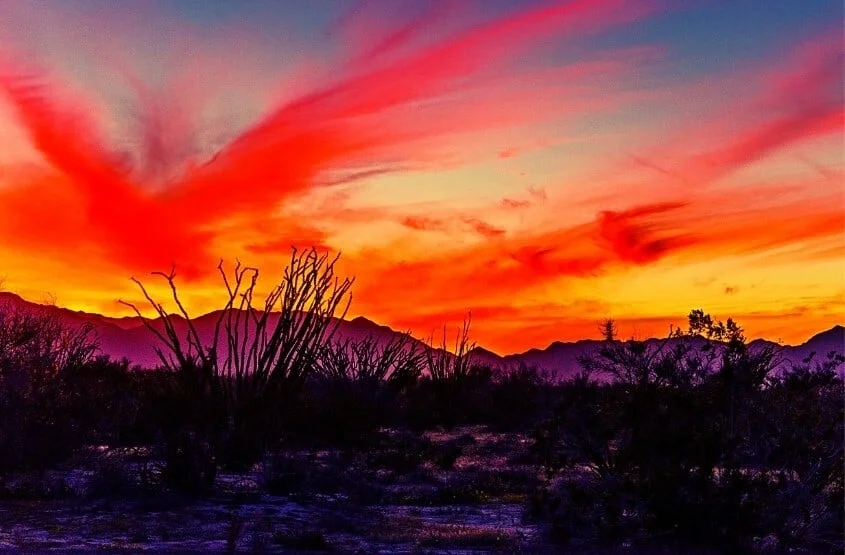
San Felipe is a very safe town on the eastern coast of Baja California. This fishing village is home to less than 20,000 citizens and is known to be much calmer than bigger cities within the state, like Rosarito.
See also: Best Hiking in Baja California
San Felipe also has a lot of gorgeous beaches where you can soak up the sun, swim, and of course, fish.

Ensenada, Mexico, is one of the most laidback cities in Baja Mexico, and as a result, this town has lower crime rates. Additionally, police and citizens carry a strong level of trust in each other, ensuring the city remains safe.
Ensenada is a coastal city and also happens to be the third-largest city when it comes to population. You can find local wines, delicious seafood, and a lot of fantastic beaches. As if that’s not enough, the weather there is consistently superb for almost nine months out of the year.
Todos Santos

Since Todos Santos is a popular tourist city, local police presence is apparent, and quick to respond to any petty crimes that may occur while visiting. This makes Todos Santos a safe and enjoyable place to visit.
Plus, it’s a hip surf town where you can find some of the most breathtaking views in the entire country. It’s situated on the Sierra de la Laguna Mountains’ foothills and the Pacific coast of the (Baja California) Peninsula. This natural paradise is made of stone streets and uncrowded beaches but it also features a ton of natural beauty and world-class waves.
Other Destinations
Overall, the southern part of Baja is known to be the safest place in the entire country. This part of Mexico is not attributed to the drug war and has had no major problems.
In addition to the aforementioned cities, here are some popular tourist destinations with a safe rap:
See also: Best Time to Visit Baja California: Events and Festivals
- San Quintin
These are some of the safest areas in all of Mexico and some of the most exciting because they’re the home to acclaimed national parks and amazing caves.
Hiking and camping are generally considered to be quite safe throughout Baja, but it’s highly recommended that you never venture out alone and try to stay close to other outdoorsy groups.
While “safety in numbers” is always a good strategy to employ, this is not just to protect you from wildlife or backroad criminals.
Many of Baja’s remote locations have really poor (or nonexistent) cell and Wi-Fi service. In the event of an emergency, you’ll want other people around to get you some help.
How to Stay Safe in Baja California
Traveling to Baja is not dangerous as long as you come prepared and know what to watch out for. Here are a few tips on how to protect yourself during your travels:

1. Check your country’s recommendations for travel to Baja Mexico
Many countries will put out safety advisories for destinations/cities that will help you understand the current political/crime climate at any given moment. It’s important to remember that the safety situation can change in an instant, so turning to the government for up-to-date information is wise.
That said, especially when it comes to Mexico, these safety concerns can be overblown. Do your homework, read the references they provide, and then you can make an informed decision in combination with articles like the one you’re reading right now.
Seeking a healthy mix of local and international context is the key to being a cautious traveler.
Need help finding resources? Here are a few helpful government advisory links:
- United States
2. Follow the laws while driving
Many travelers make the trip to Baja California in their vehicle as it’s right across the border from California. That said, the moment you cross the border, driving conditions and laws change, so make you understand all the requirements to travel to Mexico by car . To get started, these are a few quick things to keep in mind:
- Furthermore, the streets of Baja are littered with potholes and stray dogs, so always be observant while driving and drive during the day if possible .
- Be aware that you need Mexican car insurance to drive in Baja California and surrounding areas. Otherwise, you risk huge legal fees. Plus, many locals don’t have insurance, so if you do get into an accident, at least you’ll be covered. Pro tip: Don’t get just any insurance; it’s best to get affordable yet reputable insurance like Baja Bound , who’s been in business for decades.
Driving to Mexico? You MUST have third-party liability insurance. Ensure you read my guide for more info.
- It’s best to avoid driving at night if possible, as your visibility is reduced, and criminals are generally more active at this time. Cartels have been known to create illegal roadblocks as a way to demand money before allowing you to pass through.
- Also, armed muggings can occur while stopped, especially in crowded cities, so try to limit how often you stop and plan your trip ahead to ensure you’re taking the best routes.
3. Stay vigilant while wandering the streets
When it comes to exploring the cities in Baja, there are a few very simple rules you should follow to increase your safety.
- Never walk alone . Walking around alone is never a good idea, especially in a foreign city. It’s best to travel in a large group, or at least with two other people. Venturing around a city in Baja alone is just inviting trouble. Skip the trouble, don’t walk alone. Simple.
- Avoid exploring Baja at night – Exploring a city at night is not the best idea, as this is when crime is at its highest and you’re most vulnerable. If you do decide to explore at night, go with a group and make sure to bring an extremely bright flashlight and try to stay near the tourist areas as they tend to be safer.
4. Watch out for petty crimes
Thefts, snatch-and-grabs, and pickpocketing happen a lot in Mexico, especially in crowded areas, so try to avoid them. With that being said, be aware of who is around you at all times, don’t leave your personal belongings lying around, and certainly don’t carry all of your money with you.
Use common sense, stay alert, and don’t draw attention to yourself. Avoid wearing fancy jewelry and brand-name clothes, which may draw unwanted attention, ultimately leading the criminals right to you.
There are a also few common tourist scams you’ll want to look out for, especially in the larger cities. For example, people asking you to take their picture/offering to take yours do not always have the best intentions, and if anyone offers you assistance at the ATM, you should politely decline and walk away.
Trust me, at the end of the day, staying vigilant and keeping to yourself should be enough to keep you safe, so there’s no need to panic.
5. Don’t resort to violence
Although petty crime is the most common experience for all visitors, both physical and sexual violence is also at an all-time high. In fact, in recent years, it’s been well documented that Mexico has had a notably high murder rate (with most of the victims being Mexican nationals).
If you’re in a situation where you are being threatened for money or valuables, do not resist and/or fight back.
My aim is not to scare anyone but rather to inform you of the reality. Although, violent crimes should be easily avoidable using common sense.
Here are some key tips to avoid violent crimes:
- Don’t get involved with the wrong people
- Avoid attracting any kind of attention to yourself
- Be respectful and courteous
- Never find yourself in a situation where you are alone
- Don’t buy, sell, or use drugs
6. Don’t get involved with drugs
Most of the violent crimes in Mexico revolve around cartels and drugs. So the equation is simple. Avoid drugs and cartels. Then you avoid violence.
Expect to find yourself in trouble if you consider buying drugs while in Baja, Mexico. If I were you, I would avoid drugs, drug dealers, and any drug-related activities altogether in order to increase your overall safety.
Exploring Baja As A Solo Female Traveler
As we all well know, traveling on your own as a woman comes with its own unique set of challenges and safety concerns. While Baja is considered a safe destination for solo female travelers, you’ll want to take some additional measures to protect yourself.
Here are just a few tips and tricks if this will be your first trip without a companion:
1. Invest in an international phone plan so you can check in with your loved ones
It’s important that someone knows where you are and that you’ve made it back to the hotel safely. You can also share Uber driver information and other tracking info this way in case it’s needed.
2. Be mindful of your social media use
I totally understand the urge to post about your vacation as soon as you set foot on international soil, but giving away your location as a solo female traveler isn’t the wisest course of action. I typically avoid placing any geotags on my content and keeping my location ambiguous if I really can’t wait.
Otherwise, I will avoid sharing any highly specific content (hotel partnership anyone?) until I return home. Get those brand deals and brag about staying at that 5-star resort, by all means, but protect yourself while you’re at it.
3. Read reviews written by other solo female travelers
If another woman felt unsafe or insecure at any given hotel/vacation rental/attraction/part of town, chances are she’s going to warn others. We have to stick together, right? Before booking anything, I always comb through reviews for ones that seem to be written by someone like myself. If the overwhelming consensus is that they felt safe during their stay, then I go ahead with my plans.
4. Don’t feel bad about telling a fib
I get it, you don’t want to lie to someone’s face. But if you feel like a conversation is veering in a direction you’re uncomfortable with or you have to get into a taxi alone, there’s no harm in mentioning that you have a boyfriend/husband waiting for you back in the hotel room/at the restaurant. Being polite is never worth sacrificing your safety.
5. Take a walking tour before venturing out on your own
This might sound a little silly, but local tour guides know all the best spots in town (and the shadiest). If you want to know which areas to avoid, they’ll almost certainly point them out, and there’s no harm in asking about which areas are okay after dark or where to steer clear of. That said, I’d avoid mentioning that you’re on your own.
Police corruption and bribes in Baja California
Police corruption and “mandatory” bribes are not a huge concern in Baja, but this is something that occurs in some of the larger, more dangerous cities, especially those near the border.
Namely, this is more of a concern in Tijuana. Mexicali and Tecate. While the chances of being stopped are low, if you are, it is important to remain calm and level-headed. They will never be framed as a bribe right off the bat, and the officers will inform you that you have broken the law in some way, such as a minor driving infraction.
Generally, the bribes requested could range from $100-$500 USD, and will typically go up if they can see that you have a lot of cash on you. For this reason, it’s best not to flash your money around while counting it out.
Advice on how to handle these bribe stops is varied, but from what I’ve seen, it may be best to pay the fine and move on rather than run the risk of garnering too much attention.
You may find it’s worth requesting that they take you to the police station to pay the fine, but this is not a foolproof strategy.
Is Baja California Safe? – FAQs
Is the food in baja safe.
The food in Baja California is relatively safe to consume. To minimize your risk of foodborne illness, here are a few tips:
1. Always check the reviews of restaurants online before dining out 2. Avoid eating perishable foods that are room temperature or look like it’s been left out for a long time. 3. Make sure the meat you eat is cooked all the way through before consuming. 4. If eating at a street stand, watch to see if the person who handles the money is also the same person making and serving the food.
Is it safe to drink tap water in Baja California?
Waterborne illness can also be a concern, so to avoid a medical emergency (or even some uncomfortable tummy grumbles) don’t drink the tap water.
You can easily stock up on bottled water at convenience and grocery stores, but you’ll also want to be mindful about ice at the bar or produce that doesn’t have a peel.
Is Driving through Baja Safe?
Driving through Baja is generally safe. Be sure to stick to the main roads, avoid picking up hitchhikers, and try not to stop unless it’s an emergency. Also, drive during the day if possible and have Mexican vehicle insurance in case of an accident.
Is the Cartel in Baja?
There is always a cartel presence in Baja California. However, the cartel does not generally wreak havoc on tourists because they are their main source of income. As long as you don’t get involved in any of the cartel’s business, they will leave you alone.
Is Baja California safe for the LGTQIA2S+ community?
Within the smaller, catholic communities throughout Mexico, there’s definitely still a lingering stigma when it comes to LGBTQIA2S+ people, and PDA is discouraged for your own safety. This is true of Baja as well. That said, there are several “resort” destinations throughout the state that are gay-friendly and highly inclusive. Los Cabos, Cabo San Lucas, and La Paz all come highly recommend and purpleroofs.com is a great resource if you’re looking for places where you’re 100% free to be yourself.
In Conclusion – Is Baja California Safe?
If you’re looking to travel to Baja, Mexico, but you’re worried about the state’s overall safety, you can travel with confidence, knowing you’re already increasing your safety just by consuming helpful content such as this article.

Alex Gomez, the founder of Mexico Travel Buddy, combines his firsthand, on-the-ground experiences in Mexico with a personal connection to the country, fostered through his Mexican wife and numerous explorations. As a professional writer and avid travel enthusiast, his favorite destination remains anywhere within Mexico's diverse landscapes. His extensive travels have equipped him with a treasure trove of tips, tricks, and insights, which he enthusiastically shares with his audience. Alex's stories and photos on the website not only showcase his love for Mexico but also offer readers a deeply authentic and engaging perspective.
Read more by Alex Gomez
Leave a Comment Cancel reply
Welcome to mexico travel buddy.
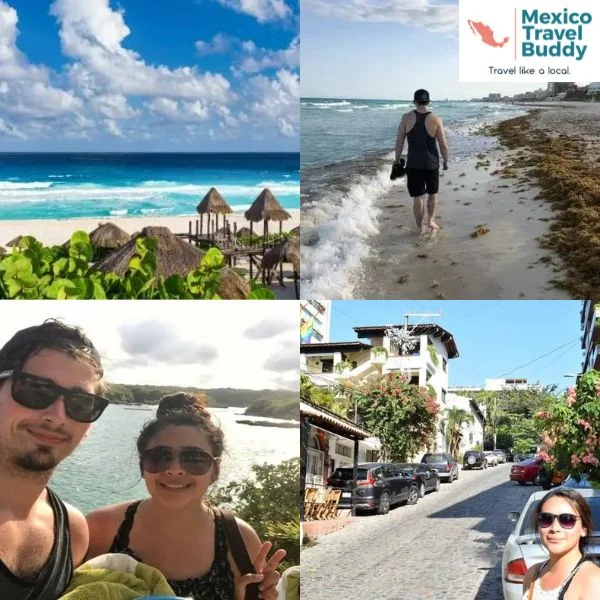
We are excited to help you make the most out of your travels to Mexico, in a safe and joyful manner!
We share our personal experiences and expert advice so you can travel Mexico like a local.
Find out more about our journey and our love for Mexico.
Follow us on our socials!
Looking for something or somewhere specific? We might just have it!
Travel Like A Local Where's Your Next Stop?
Recent Posts
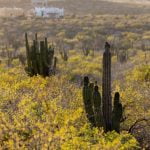
San Ignacio Mexico Travel Guide
March 30, 2024
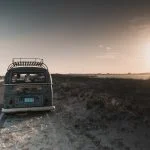
Everything You Need to Know About Punta Baja: The Sleepy Seaside Camp of Your Dreams

Pescadero Mexico Travel Guide

Mulege Baja California Travel Guide
Is Baja safe? Should you drive? Things to know before you go
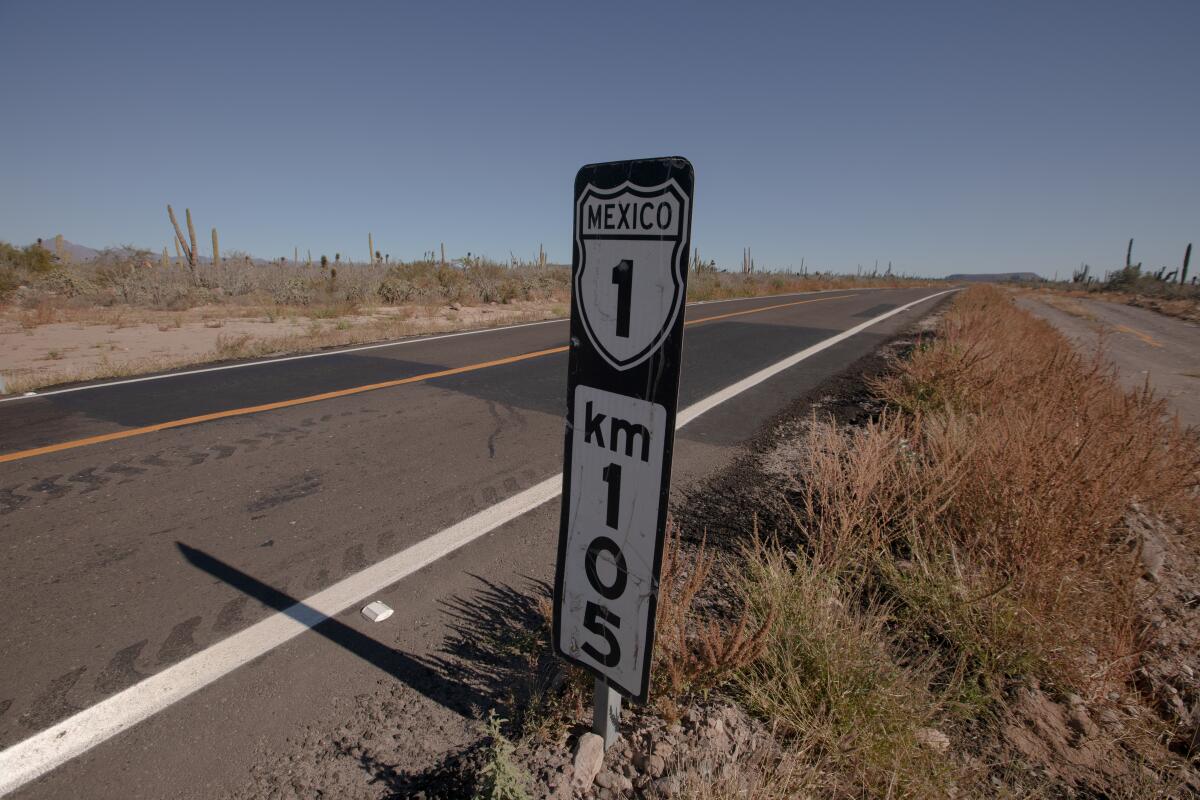
- Copy Link URL Copied!
Homework is vital before travel in Baja California, especially if you’re considering a road trip.
Questions over Americans’ safety in Mexico have been underlined by the mid-January death of Orange County public defender Elliot Blair, who suffered unexplained head injuries at a Rosarito Beach resort; and by the early March shooting deaths of two Americans and one Mexican in an apparently botched kidnapping in Matamoros, 1,570 miles east of Tijuana.
Here’s a rundown of sources I consulted and factors I weighed before my eight-day drive to Cabo San Lucas in early January.
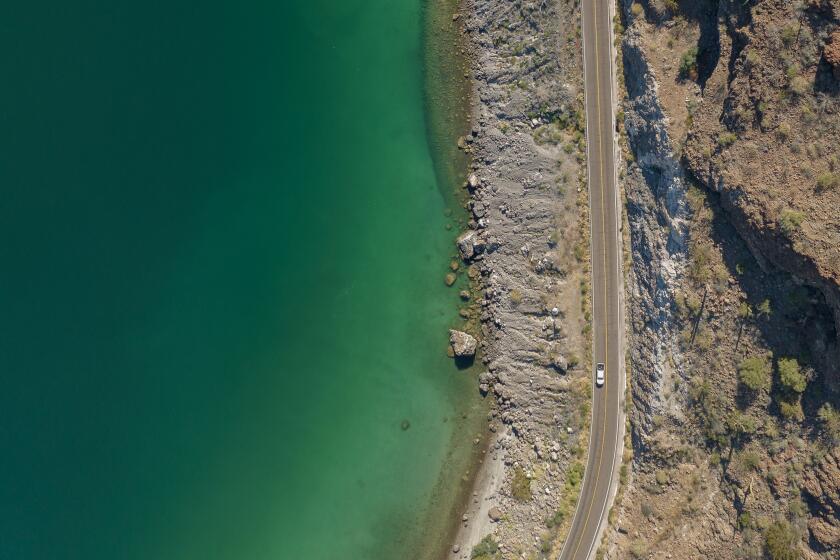
Travel & Experiences
Joshua Tree with beaches and taquerias? No, just an epic Baja road trip
On a drive down the Baja peninsula’s Highway 1, travel writer Christopher Reynolds finds baby whales, a pond to float in and a new generation of adventurers.
March 15, 2023
Overall safety
The U.S. State Department classifies Mexico’s states in four ways for would-be travelers. The most severe advice is “do not travel,” which currently covers the states of Colima, Guerrero, Michoacán, Sinaloa, Zacatecas and Tamaulipas (which includes Matamoros) on Mexico’s east coast.
The state of Baja California is in the second most severe category — “reconsider travel” — because of crime and kidnapping, especially homicides in the non-tourist areas of Tijuana. The State Department urges those who do travel to remain on main highways. The State Department also puts the states of Chihuahua, Durango, Jalisco, Morelos, Sonora and Guanajuato (the latter includes San Miguel de Allende) in that category.
The state of Baja California Sur, which begins about 450 miles south of the U.S. border, is in the State Department’s less extreme “exercise increased caution” category.
Canada’s government urges Canadians to “exercise a high degree of caution” in Mexico.
The website elcri.men , which summarizes and analyzes Mexican crime statistics, said Baja California had the third-highest homicide rate among Mexican states in 2022, in large part because of Tijuana. By the same measure, Baja California Sur had the fourth-lowest rate among Mexican states.
If studying up on conditions in the Baja peninsula makes you or your companions uncomfortable, stay away. Even if nothing goes wrong, feeling unsafe can ruin a trip. (I didn’t drive the peninsula with my family; I drove it with two people who felt comfortable with it.)
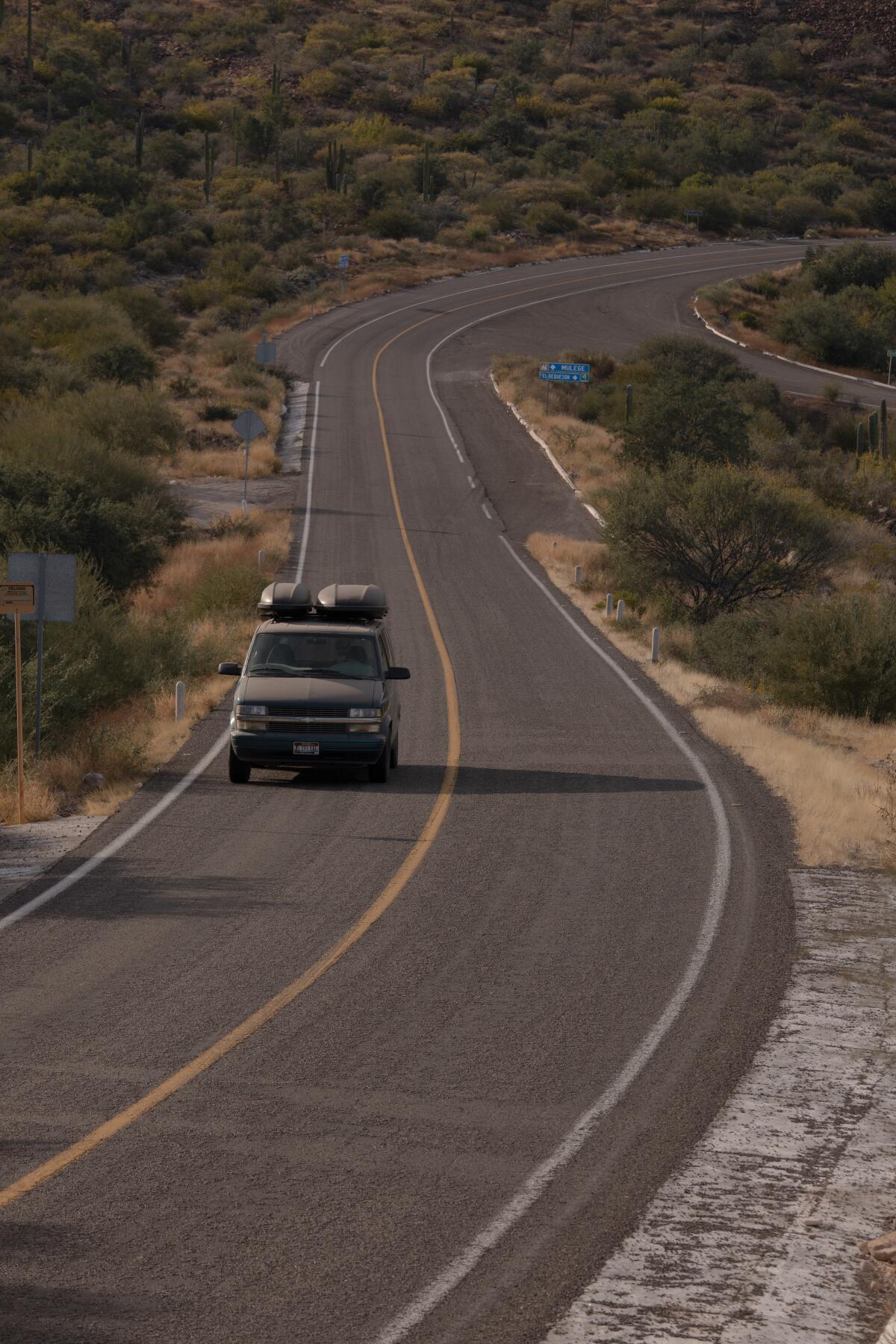
Driving in Baja
In addition to a valid driver’s license, Mexican law requires anyone driving into the country to have Mexico-specific liability insurance.
Many companies specialize in insurance for Americans driving south, offering liability policies that often cost from $10 to $40 per day. More extensive policies can double the cost but may give you more peace of mind. Vendors include AAA , Allstate , Bajabound.com , Baja-mex.com , Discoverbaja.com, Geico and Mexpro.com .
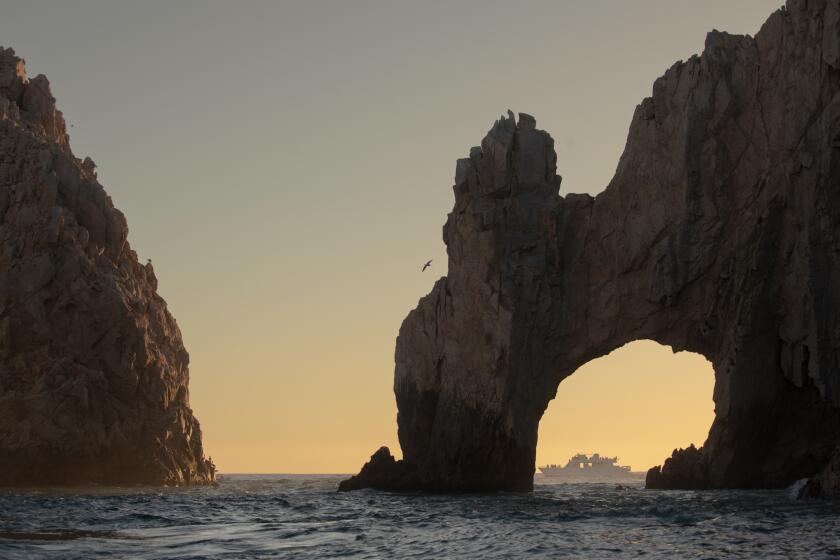
25 restaurants, hotels and hidden wonders along the Baja Highway
Cave paintings. Missions. A lagoon where gray whales gather. Whether you’re taking on the whole highway or targeting one stretch, the landscape is full of revelations.
All authorities agree that driving at night in rural Baja is dangerous because of the many roaming livestock. In addition, drivers should be ready for long, narrow stretches of two-lane blacktop without shoulders or turnouts.
Two other things: Drunk driving is just as illegal in Baja California and Baja California Sur as it is in California. Also, it’s illegal to enter Mexico with a gun without written authorization in advance from Mexican authorities.
More driving tips:
- Occasionally drivers in Tijuana, Rosarito Beach and Ensenada are pulled over after an alleged infraction and offered a chance to pay a fine at the police station or on the spot. Don’t argue or pay on the spot, many Baja veterans say. Instead, they say, the best response is to ask for a written citation and agree to pay the citation at the police station or by mail (or challenge it) . An additional option: calling Baja California’s bilingual Tourist Assistance Hotline (078, around the clock) from any cellphone with roaming privileges in Baja.
- Police checkpoints are placed every few hundred miles along the peninsula. Officers typically ask drivers where they have come from and where they’re going. We went through about six checkpoints, the conversation never lasting more than one or two minutes.
- Many roads to scenic spots are dirt, not blacktop, and best handled by vehicles with four-wheel drive and high clearance.
- The peninsula is so big that most travelers choose to explore selected portions. Many travelers fly to Los Cabos, La Paz or Loreto, rent a car at the airport, drive a loop and return the car where they began. Picking up and dropping off a rental car in different locations is possible in Baja but can double the cost. Topoterra is the only company I could find that would rent me a vehicle in San Diego and let me drop it off (for a fee) in Los Cabos.
- In Baja (and all of Mexico) distances are measured in kilometers, gas is sold by the liter (and usually pumped by an attendant) and speed bumps ( topes ) pop up in some urban areas. Gas prices in Baja have lately fluctuated around 22 pesos per liter (about $4.50 per gallon) and are often cheaper than in California.
- Beyond the Pemex station in El Rosario there isn’t another gas station until Villa Jesús María (just north of Guerrero Negro), 200 miles south.
- More detailed advice is offered by the Automobile Club of Southern California , Bajabound, AllAboutBaja.com and other sources.
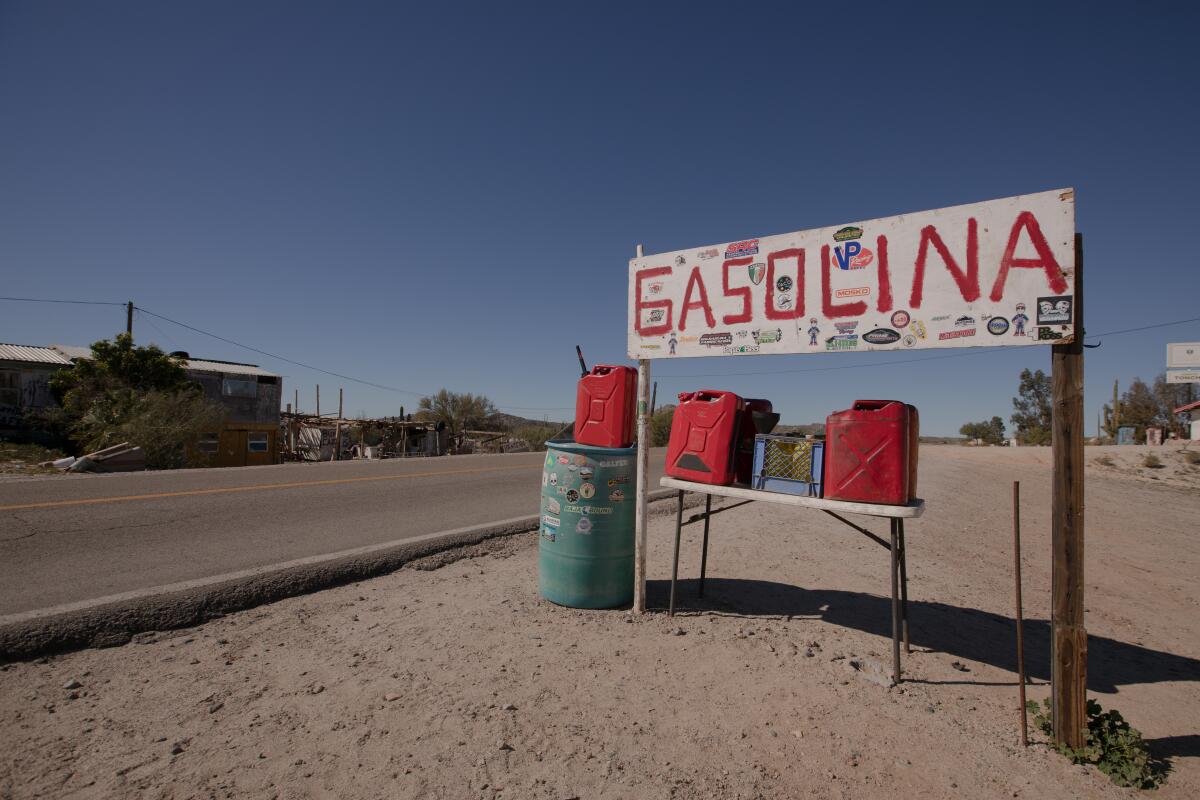
Communication and laws
Southbound travelers must show a passport or passport card and are required to get an FMM tourist permit online or in person from Mexican immigration officials at the border. For trips of more than seven days, the cost is about $36 (687 pesos).
The more Spanish you speak, the better. If you’re hoping to camp on ranch land, the best preparation may be hiring a local guide who can help get you permission.
To ease web access and communication with the U.S., many regular winter visitors to Baja use Starlink , which for $599 up front and $135 monthly allows a road-tripper or RV driver to access the internet from just about anywhere in Baja.
More to Read

Tropical Storm Ileana makes landfall on Mexico’s Sinaloa coast after pounding Los Cabos
Sept. 14, 2024
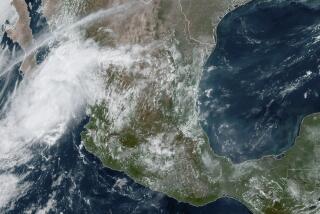
Tropical Storm Ileana heads toward Los Cabos resorts bringing heavy rains
Sept. 13, 2024

12 great beaches in Southern California beloved by locals
Aug. 1, 2024
Sign up for The Wild
We’ll help you find the best places to hike, bike and run, as well as the perfect silent spots for meditation and yoga.
You may occasionally receive promotional content from the Los Angeles Times.

Born and raised in California, Christopher Reynolds has written about travel, the outdoors, arts and culture for the Los Angeles Times since 1990.
More From the Los Angeles Times

World & Nation
Mexican president responds to allegations from jailed ex-security chief: ‘Show the proof’
Sept. 18, 2024

U.N. experts decry worsening repression in Venezuela after contested election
Sept. 17, 2024
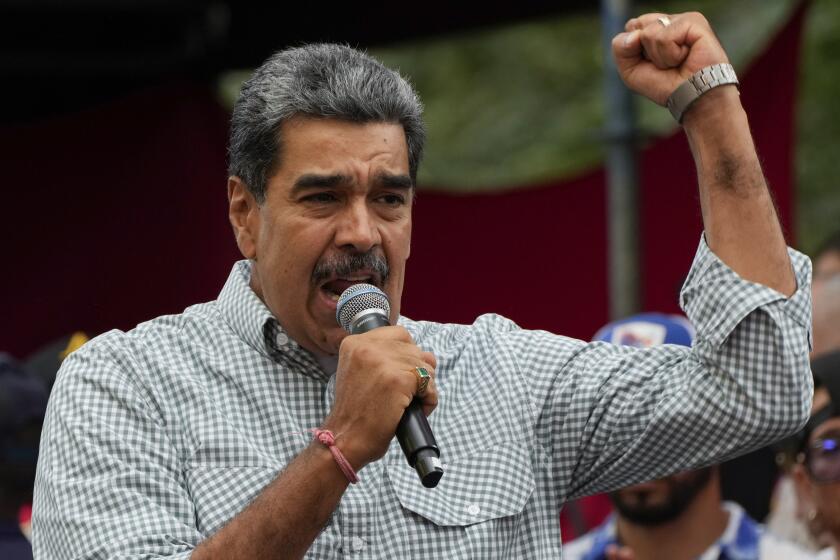
Venezuela says it arrested 3 Americans, 3 other foreigners in alleged plot to kill Maduro
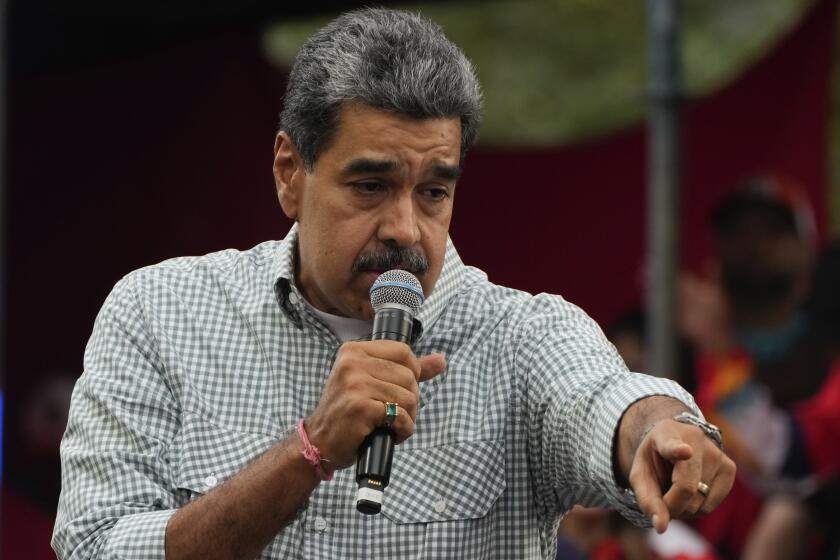
U.S. sanctions 16 allies of Venezuela’s president over accusations of obstructing election
Sept. 12, 2024

Is Baja California Safe? Understanding Baja California Crime Rates and Travel Concerns
Is Baja California safe? With stunning desert landscapes, beautiful beaches, vibrant cities, and excellent cuisine and wine, Baja California has become an alluring destination for travelers seeking vibrant experiences. From the Valle de Guadalupe’s wine country to the stunning beaches, Baja entices visitors with its natural beauty and cultural attractions.
However, according to the U.S. State Department, Baja California falls under the second-highest severity level , urging travelers to “reconsider travel” due to crime and kidnapping. By being aware of the risks, using caution in troubled areas, and focusing on safer tourist destinations, it’s possible to experience Baja’s Baja’slluring sights safely.
So, keep reading to uncover Baja crime rating, the safest and the most dangerous neighborhoods. Moreover, learn risk when you driving a car, using a taxi, or bus. And know 9 essential tips for making the most of your Baja dreams without compromising personal safety. Let’s get it started!
Is Baja California Safe to Visit in 2024 – Key Takeaways
- Cartel Violence Risk – MODERATE (in tourist zones)
- Kidnappings Risk – MODERATE
- Fraud Risk – HIGH
- Petty Theft Risk – MODERATE
- Level of Danger When Driving – MODERATE
- Bad Areas – Tijuana, Tecate, Mexicali
- Safe Places – Ensenada, San Felipe
- Number of crimes in the Baja California state compared to other states in Mexico:
All material presented in this article is based on official Mexican and U.S. government data and recommendations, statistics from reputable publications, and local news reports. The information is intended for general guidance purposes only and does not constitute professional travel advice.
Our danger level study is based on:
- Mexican government statistics National incidents of crime for 2023, January 2024.
- US Government travel advisory levels and precautions in 2024.
- US Government travel map in 2024.
- Risk map analysis of the Mexico Cartel War in 2023.
- Elcri map of most violent tourist destinations and homicides map upon on the Mexican Justice System and the INEGI in 2023 and 2024.
- Numbeo’s statistics are derived from the real experiences of travelers and residents in 2024.
- News summaries from local presses as well as authoritative resources from Mexico and the United States in 2023 and 2024. In some cases, these data are taken for an earlier period if the type of crime or hazard is not present in 2023 and 2024.
Each risk level will be indicated by a different color red for high risk, orange for medium risk, and green for low risk.
Risk Levels Meaning:
- High Risk : High number of offenses in the last year, skyrocketing incidents, crime rate higher than the Mexican average. Regarding Numbeo travelers express fear and concern.
- Medium Risk : The amount of infractions over the past year is close to the national average. Visitors’ worries and concerns are at a moderate level according to Numbeo.
- Low Risk : Low number of prior year offenses, there has been a decrease in incidents, and crime is lower than the Mexican average. Travelers feel safe according to Numbeo statistics.
Is Baja Mexico Safe? Crime in Baja Mexico
Blessed with beautiful beaches, vibrant cities, and excellent cuisine, Baja California has become a popular tourist destination in Mexico. From swimming with whale sharks in La Paz to enjoying Valle de Guadalupe’s acclaimed wines, Baja lures visitors with its natural landscapes and cultural attractions.
However, Baja has witnessed rising safety issues. The Mexican government released an official report documenting over 121,065 crime cases in Baja, California. Out of the total, 9,908 incidents happened in December 2023. In January 2024 this value was 9,929 . Another report by the National Network of Observatories using Mexican Justice System data shows Baja California State suffered a total of 29 homicides and femicides in December 2023 alone.

While parts of the state remain risky, it’s still possible for travelers to safely experience Baja’s beauty by exercising caution, avoiding trouble spots, and focusing on safer tourist areas. Let me shed light on common crimes to watch for in the state. By being aware and vigilant, you can still fulfill your Baja-bound dreams. Let’s dive further:
Cartel Violence Risk – Moderate in Tourist Zones
Behind its beautiful façade of beaches and vineyards, Baja California masks an ongoing battle between powerful drug cartels. The Sinaloa Cartel and Jalisco New Generation Cartel continue to clash over control of lucrative drug smuggling and other illicit enterprises in the state. This has fueled outbreaks of cartel violence, including broad daylight shootouts, homicides, and kidnappings that threaten locals and travelers alike.

While cartel violence has plagued parts of Mexico City, the risk in Baja California’s tourist zones remains moderate, according to official data in The Tweek. The state registered 2,618 homicides in 2023, some of which were likely linked to cartel and gang activity. The Mexican government has bolstered security to protect visitors, including:
- Deploying more National Guard troops across Baja California.
- Partnering with the UN and Interpol on new enforcement strategies.
- Enacting stricter anti-organized crime laws with longer sentences.

Kidnapping Risk – Moderate
Despite concerns elsewhere in mainland Mexico, the risk of kidnapping remains relatively moderate in Baja California’s tourist areas. In 2023, there were only 10 reported kidnappings in Baja California. For comparison in 2022 according to news outlets KETX and FOX 51 , only in Tijuana were registered 60 kidnappings. Primarily they were targeting locals rather than foreign visitors.
The popular travel destinations of Cabo San Lucas, La Paz, and Locations near border crossings saw few to no abductions. However, caution is still advised near the US border. The State Department warns travelers to avoid certain border regions.

Fraud Risk – High
Fraud poses a major risk in Baja California, with 3,753 reported incidents in 2023. The most common schemes involve:
- Trust abuse: There were 651 reported incidents of trust abuse in 2023. This involves financial scams or manipulation by someone the victim trusts. Common schemes include romance fraud, fraudulent investments, and identity theft by “friends.”
- Extortion: 106 extortion cases were reported last year. This involves threats to obtain money or information. Phone extortion scams are common, with criminals impersonating officials demanding payment.
- Other popular frauds: Additional street frauds involve rigged games, money exchange manipulation, and hotel booking schemes.
Petty Theft Risk – Moderate
Petty theft and property crimes pose a moderate risk:

- A total of 33,458 were reported in beach camping areas in 2023.
- Home robberies occurred 3,215 times, though the majority (2,998) involved no violence.
- There were 11,563 motor vehicle thefts, mostly (10,783) car thefts.
- Violent robbery totaled 1,193 incidents.
Exercising vigilance, securing belongings, and avoiding ostentatious displays of wealth help reduce risks. Overall, Baja’s main tourist zones remain relatively safe if smart precautions are taken.
Baja California Safety: Avoiding Bad Areas
The best way to explore a city or state is to know the best areas to land and where to avoid visiting. The northern region of Baja bordered by San Diego should be avoided by all means. Areas like Tijuana experience significant criminal incidents ranging from drug cartels to gang-related violence.
While the Mexican government has intensified efforts to combat criminal activity in the vicinity, it remains a hazardous place and you should exercise caution. Discover more places that are to be avoided and the reasons behind them.

Tijuana is deemed unsafe for visitors due to its high crime level, notably one of the world’s highest homicide rates, largely linked to cartel operations. Regarding Statista a murder rate of 105.15 per 100,000 people in 2023. As for Elcri.men homicides in Tijuana were 1651 to 1,854,041 people, with a crime rate of 89, from February 2023 to January 2024.
Though violence tends to target specific demographics and is concentrated in particular areas, tourists may still encounter incidents of petty theft, robbery, and assault.

Just like Tijuana, Tecate is also a border town renowned for its bear. Public Security in Baja California announced that there was a 146.9% increase in intentional homicides in the city of Tecate in 2022. From February 2023 – January 2024 a crime rating of 90.6 and 107 homidicies to 118,126 people.
This shows that this region has a high crime, therefore, it’s advisable to observe safety. To add to that, the Centers for Disease Control and Prevention (CDC) issued a warning in December 2023 against traveling to Tecate due to the risks of contracting Rocky Mountain spotted fever (RMSF).
3. Mexicali
Mexicali has a high crime rate, with only 6.96% of the population having confidence in the state police. The primary safety concerns in Mexicali pertain to petty crime and scams that target tourists. Furthermore, Mexicali recorded a total of 2996 complaints for December 2023. Out of those complaints, 428 were for violence and 316 for property damage.
As for homicides from February 2023 to January 2024, a crime rating in Mexicali was low at 15,4, 175 cases to 1,133,409 people.
How Dangerous Is It to Drive in Baja California? – Moderate
Driving alone in Baja California poses safety risks due to cartel violence and road hazards. Regarding the US Department of State, the region contains major drug trafficking routes , making it prone to cartel activity and banditry. According to the latest government crime report, the overall risk index for vehicles is moderate at around.

However, some roads are considered safer for travel, such as:
- Mexican Federal Highway 1 – runs along the entire Pacific coast of the Baja California peninsula.
- Mexican Federal Highway 1D – a toll highway that runs parallel to Highway 1, but with less traffic.
- Mexican Highway 3 – connects the cities of Ensenada and San Felipe on the east coast.
- Mexican Federal Highway 5 – runs through the Mexicali Valley to the southern tip of the Peninsula.
Army patrols and ground checkpoints are present on these major federal highways to increase the safety of travel along them.
Safe Places to Visit in Baja California
Despite the Baja Peninsula having high crime rates, some places are safe to visit, especially in the southern tip areas. These renowned spots include Ensenada and San Felipe, all recognized as safe places to explore. Whether you are planning for a honeymoon or a family getaway, they present themselves as beautiful and enjoyable safety destinations. Keep scrolling to discover why they are considered secure:

1. Ensenada
Located in the northern part of Baja California, Ensenada is known for its beautiful coastline, wineries, and outdoor activities. It has a low crime rate index of 39.52 , according to Numbeo, meaning it is generally safe for travelers compared to other cities in the region.
Ensenada is considered secure to visit because of good safety measures, infrastructure improvements, and intolerance of crime. This Pacific coast destination has seen a recent booking rise , highlighting its status as a low-risk and popular tourist location. Popular attractions include La Bufadora blowho le and the wine region of Guadalupe Valley.
2. San Felipe
Major investments in tourism security help keep risks low. On Baja California’s eastern coast, San Felipe typically reports a low incidence of petty crimes. According to the latest data regarding DATA MEXICO:
- 12.4% of the population claimed high confidence in the state police, while 14.7% have high distrust.
- 16.9% expressed high trust in the Public Ministry and State Prosecutors.
- 25.3% have high confidence in the Federal Police.
This indicates relatively strong public trust in law enforcement. Last year saw no reported kidnappings or homicides related to organized crime. With under 100 total crimes, San Felipe is very safe for Baja and offers peace of mind with gorgeous beaches, fishing, and water sports.
Safety Tips for Baja California Mexico
Baja California (not to be confused with Baja California Sur) is not one of the safest states to live in Mexico. And to be assured of your safety, you need to take into consideration several aspects. Here are some of the tips:
- Purchase Mexico travel insurance before driving across the border. Mexican law requires liability coverage for all foreign vehicles .
- Steer far clear of any drug activity. Cartel violence is confined to border towns like Tijuana, but drug charges carry severe penalties, including a 25-year jail sentence.
- If pulled over, politely ask for the officer’s citation and ID before paying bribes. Call the Tourist Assistance Hotline at 078 for better clarification in case of any doubts.
- Stick to daylight driving. Livestock wandering at night and cartel threats make night travel dangerous.
- Monitor local news and advisories. Social media and outlets like Baja Post provide updates on any incidents of concern.
- Use only regulated taxis or shuttle services. Avoid hitchhiking, which poses kidnapping risks.
- Stay in well-known tourist spots and avoid remote areas without guidance. This reduces risks.
- Keep emergency contacts at the police station and inform loved ones of your itinerary. This allows checking in if trouble arises.
With proper precautions, Baja California offers incredible experiences. Use good judgment; you’ll find warm locals, delicious cuisine, and stunning landscapes to enjoy safely.
Is Baja Mexico safe for tourists?
The U.S. Department insists Baja is unsafe and it’s best to avoid traveling. However, tourist areas like Ensenada, and San Felipe have lower crime rates. Popular beach towns can see petty theft. Border cities like Tijuana and Mexicali have cartel violence risks.
Is Baja a safe place to live?
Living in Baja depends on the location. Coastal cities like Ensenada and San Felipe have good infrastructure and less crime, making them safer. Ensenada has a crime index of 39.52 , making it relatively safe to live in.
Is it safe to drive through Baja California?
It is not safe to drive in Baja and you should take precautions. Avoid remote roads at night due to livestock and banditry risks. Stick to Mexican Federal Highways like 1, 1D, 3, and 5 during the day. Keep doors locked and don’t pick up hitchhikers. Monitor travel warnings for cartel roadblocks or carjackings.
Let’s recap: is Baja California safe for travel? The state has varying risks depending on location. Border towns like Tijuana and Mexicali have high homicide rates tied to cartel violence. Rural roads also pose hazards at night. However, popular family-oriented tourist destinations Ensenada and San Felipe have lower crime rates. Tourism police patrols make them safer.
The U.S. government advises reconsidering travel to Baja, California, due to crime. Avoid isolated areas and northern border regions. Exercise caution at night, especially at gas station. Monitor weather and news to prepare for emergencies. Getting insurance, using registered transportation, and informing others of your itinerary are smart steps. Ultimately, travelers to Baja can stay relatively safe by sticking to recommended locales and proper precautions.

The Safest Destinations to Visit in the Baja
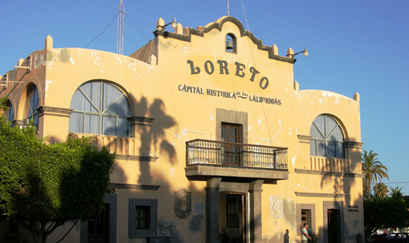
Traveling to a different country can always be a risk, especially now with a global pandemic. While Mexico has long been a favorite country for Americans to travel to, some places are safer than others, in terms of both crime and the pandemic. Much of the country is under federal warnings to reconsider travel, but there are a few places where, with extra precautions in place, one can travel to, provided you have tested negative for COVID-19 prior to arrival. Mexico does not require a negative COVID-19 test to enter but it’s still important to get tested if you’re going to
It’s also important to note that staying at a resort property adds an extra layer of security due to their enhanced health and safety protocols. That’s why going to some of the most popular tourist destinations, like the Riviera Maya or Los Cabos, will be your safest bet this year. Click through to see the safest places to visit in Mexico, and as always, make sure to follow proper guidelines and check out the U.S. Department of State’s travel advisory page.

Loreto Loreto , located in Baja California Sur, is one of the oldest towns in the Mexican state and is known for being a beautiful escape from the hustle and bustle of city life. Go on a whale watching tour, discover dolphins swimming in the ocean as you watch some of the most beautiful sunsets around and visit the Loreto National Marine Park, home to 800 species of fish and marine life. Hike the Sierra de la Giganta, the local mountain range, to discover prehistoric cave art. Check out the Villa del Palmar Beach Resort & Spa or the Loreto Bay Golf Resort & Spa. And according to the state’s coronavirus website, Loreto has the smallest amount of cases in the state. Baja California Sur is currently under the “orange” designation in Mexico’s phased reopening system, which means that all restaurants, hotels, parks and more are operating at 50% capacity. Measures such as masks and social distancing are still required.

Los Cabos Los Cabos is most definitely the most popular destination in Baja California Sur to visit. This resort-heavy locale is actually made up of two cities: San Jose del Cabo and Cabo San Lucas. It offers more than twenty miles of beachfront paradise along the southernmost tip of the state. There’s also no lack of incredible all-inclusive resorts here, from the romantic adults-only Secrets Puerto Los Cabos Golf & Spa Resort to the stunning cliffside Grand Fiesta Americana Los Cabos Golf & Spa Resort.

La Paz La Paz is the capital of Baja California Sur, and is known for its beaches and beachfront promenade Malecón, which features artwork by Mexican artists. It’s also a famous university town, where the most popular major is marine biology. It’s no wonder why: stunning blue water, sea lions, dolphins, whales and a plethora of other marine life make their homes alongside the city’s beach. Taking care of the environment is big here, and so are the opportunities for outdoor adventures. To start your hotel search, try the Puerta Cortes. The beaches in the state are also operating at 30% capacity because of the pandemic, so you have a great opportunity to enjoy a more serene beach experience.
Reproduced from an article in Travel Pulse

About The Author
Chuck kinder, view profile, send me a message.
- This is a nother one of my blog posts you can enjoy.
RELATED POSTS
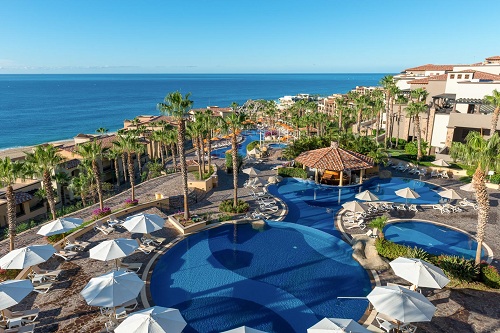
SUSTAINABILITY ALWAYS IN SEASON AT PUEBLO BONITO RESORT

Mexico Tourism returning to Pre-Pandemic levels
Holland america cruises coming to los cabos in 2023, popular navigation.
- Advertising
- Search Directory
- Latest Resources
More Navigation
- Become An Ambassador
- About Baja Alive
- Baja Locations
Business Owners
- Add Your Business
- Login or Register
- Business Dashboard
The Legal Corner
- Contact Us Today
- Privacy Policy
- Terms & Conditions
Send Chuck Kinder A Message

Safe Travel

Baja California Awarded “Safe Travels” Stamp from World Travel and Tourism Council for Outstanding Health and Hygiene Protocols

A step by step guide when traveling to Tijuana

Baja California restaurants are now ready to welcome you with the «Safe Table» program!
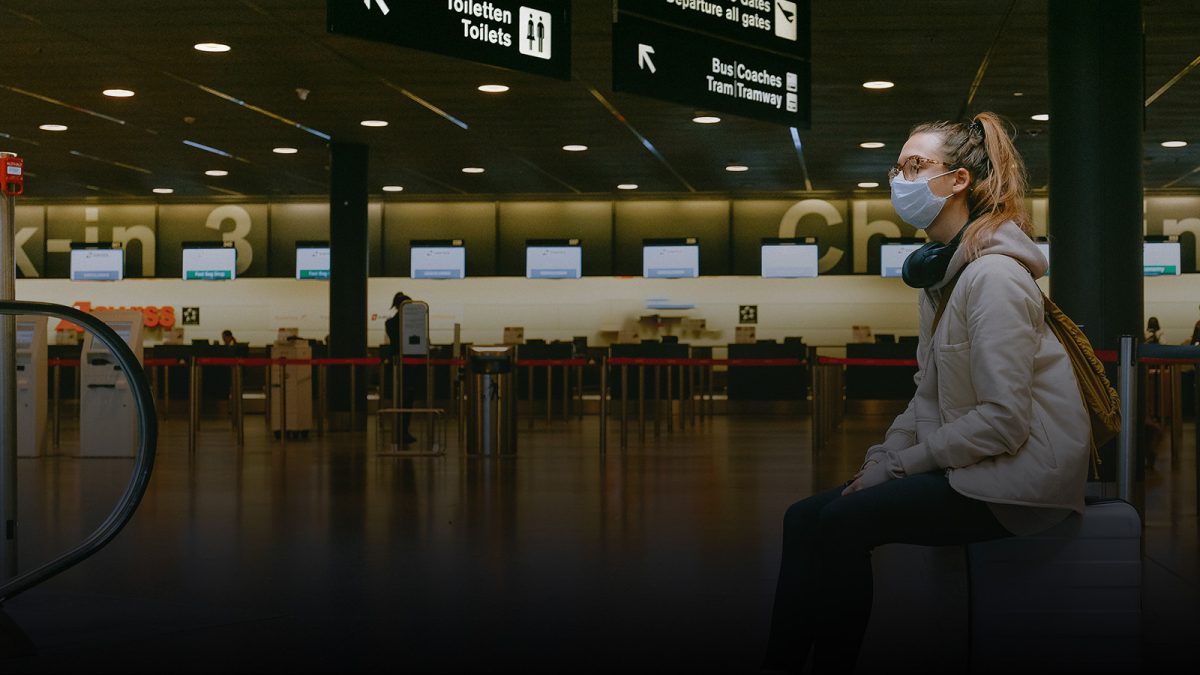
What recommendations should you follow as a traveler at the Tijuana Airport?
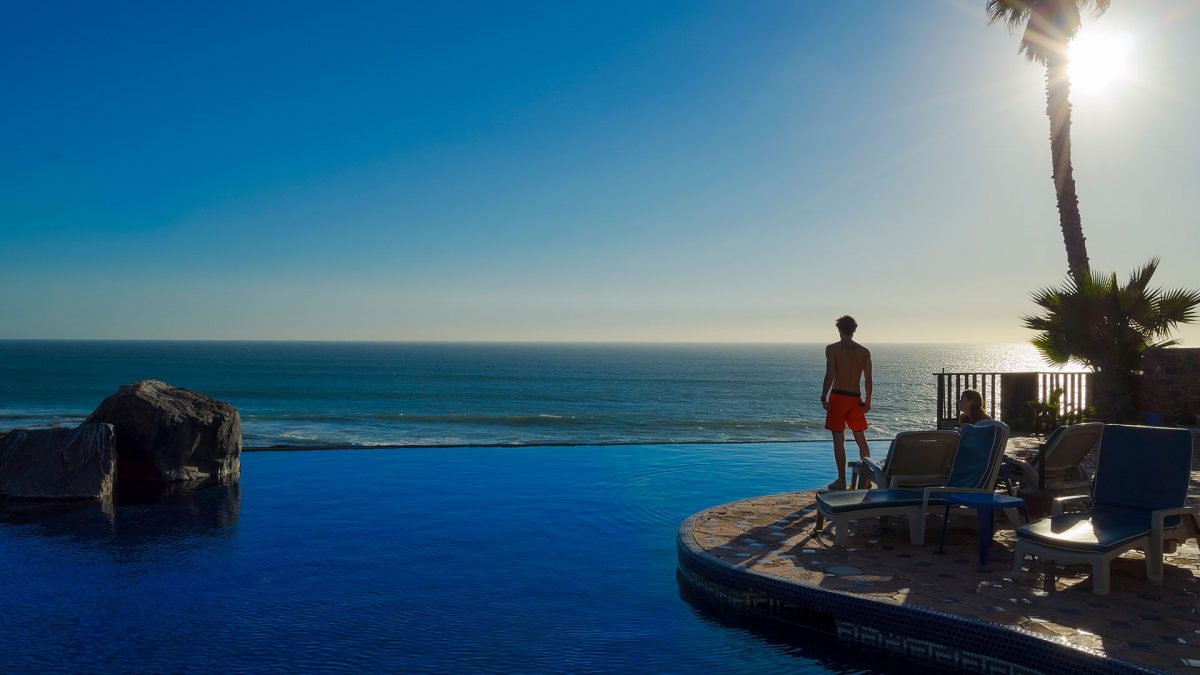
Get to know what Baja California hotels are doing to safely welcome you

6 safety steps for your upcoming trip to Tijuana!

Actions and recommendations for international patients coming to Tijuana for medical procedures
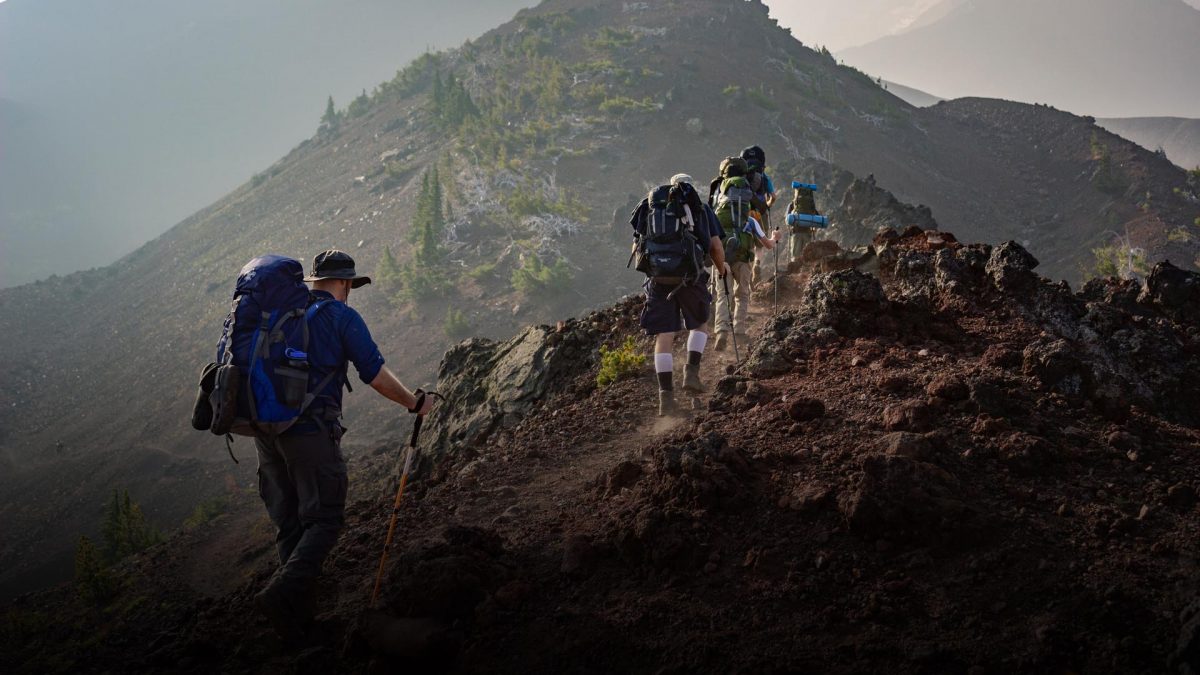
Hiking Promoters can operate under approved protocols
- No translations available for this page

7 Reasons Why Baja California Is Safe for Travel
Baja California is a popular tourist destination, known for its beautiful beaches, rugged mountains, and rich cultural heritage. But is it safe to travel to
In this blog post, we’ll take a look at the safety situation in Baja California, and answer the question
Is Baja California Safe
1. Low crime rates 2. Strong economy 3. Modern infrastructure 4. Beautiful beaches 5. Rich culture 6. Safe drinking water 7. English widely spoken
Is Baja California Safe?
Baja California is a state in Mexico that borders the United States to the north. It is a popular tourist destination due to its beautiful beaches, clear water, and rich culture. However, there is some concern about the safety of Baja California, especially in the more remote areas.
Crime Rates
The crime rate in Baja California is higher than the national average in Mexico. However, it is still lower than the crime rate in many major US cities. The most common crimes in Baja California are petty theft, robbery, and drug trafficking.
Violence Against Women
There is also a high incidence of violence against women in Baja California. This is a serious problem that the government is working to address. However, it is important to be aware of this issue if you are planning to travel to Baja California.
Safety Tips
Here are some safety tips for travelers to Baja California:
Stay in well-lit areas and avoid walking alone at night. Be aware of your surroundings and keep your valuables close at hand. Don’t accept drinks from strangers. Be careful when using ATMs. If you are approached by someone who seems suspicious, don’t be afraid to walk away.
Baja California is a beautiful and safe place to visit. However, it is important to be aware of the potential risks and take precautions to stay safe.
Also Read: Is California On Fire
FAQs about Is Baja California Safe
Is baja california safe to travel to.
Short answer: Yes, Baja California is generally safe to travel to. However, there are some areas that are more dangerous than others, so it’s important to do your research before you go.
What are the most dangerous areas in Baja California?
Short answer: The most dangerous areas in Baja California are Tijuana, Mexicali, and Ciudad Juárez. These cities are located along the U.S.-Mexico border and are known for their high rates of crime and violence.
What should I do to stay safe in Baja California?
Short answer: Here are some tips to stay safe in Baja California:
Be aware of your surroundings: Keep an eye on your belongings and don’t walk alone at night.
Don’t flash your cash or valuables: Keep your valuables hidden and don’t wear flashy jewelry.
Be respectful of local customs: Dress modestly and avoid making eye contact with strangers.
Use common sense: Don’t go to dangerous areas or get involved in illegal activities.
What are the best places to visit in Baja California?
Short answer: There are many beautiful and safe places to visit in Baja California, including:
La Paz is a beautiful coastal city with a relaxed atmosphere. It’s a great place to relax on the beach, go swimming, or explore the nearby islands.
Todos Santos is a charming town with a bohemian vibe. It’s a great place to visit for art galleries, restaurants, and shops.
Cabo San Lucas is a popular tourist destination with beautiful beaches, resorts, and golf courses.
What are the best times to visit Baja California?
Short answer: The best times to visit Baja California are from November to April, when the weather is warm and sunny. The summer months can be hot and humid, so it’s best to avoid visiting during this time.

Hey there, I'm Robyn and I'm a travel enthusiast and the writer behind this website. With a passion for adventure, I've been traveling and sharing my experiences for as long as I can remember.
Similar Posts

[Number] Adorable American Labrador Puppies in California [Adjective] Friendly, playful, and eager to please, these American Labrador puppies are sure to make your family complete. [Keyword] Puppies [Promise] Find your perfect puppy today at [website].
American Labrador puppies for sale in California. These puppies are AKC-registered, healthy, and come with a 1-year health guarantee.
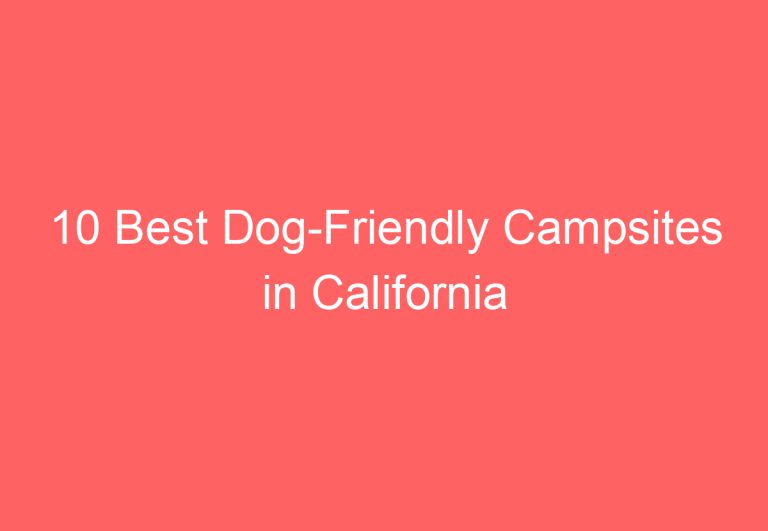
10 Best Dog-Friendly Campsites in California
California is home to some of the most beautiful and dog-friendly campsites in the country. From the redwood forests of the north to the deserts of the south, there’s a…

3 Dog Barking Laws in California That You Should Know
Dog Barking Laws in California A Brief Are you a dog owner in California If so, you need to be aware of the state’s dog barking laws. These laws are…

Is Culver’s Finally Coming to California?
Culver’s A Midwestern Favorite Comes to California Culver’s, a Midwestern fast-food chain known for its butterburgers and frozen custard, has finally come to California. The first California location opened in…

Is Concord California Safe? Your Questions Answered
California’s Concord A Safe Haven for Visitors and Residents Alike Concord, California is a city located in the East Bay of the San Francisco Bay Area. With a population of…

last How Long Will California Unemployment Benefits Last?
California’s unemployment rate is currently 4.3%, down from a peak of 16.1% in April 2020. The state has added over 2.1 million jobs since the start of 2021, and the…
Leave a Reply Cancel reply
Your email address will not be published. Required fields are marked *
Save my name, email, and website in this browser for the next time I comment.
Is Baja California Safe in 2023?
Due to its close proximity to the United States, the section of Mexico known as Baja California is a popular travel destination. With a diverse landscape, including beaches, forests, deserts, and even mountains, Baja California has something to offer any traveler.
However, is Baja California safe for tourists to visit? In this article, we will discuss the current safety situation in Baja California and give recommendations on where to go and what places to avoid so you can decide if Baja California is a safe destination for you.
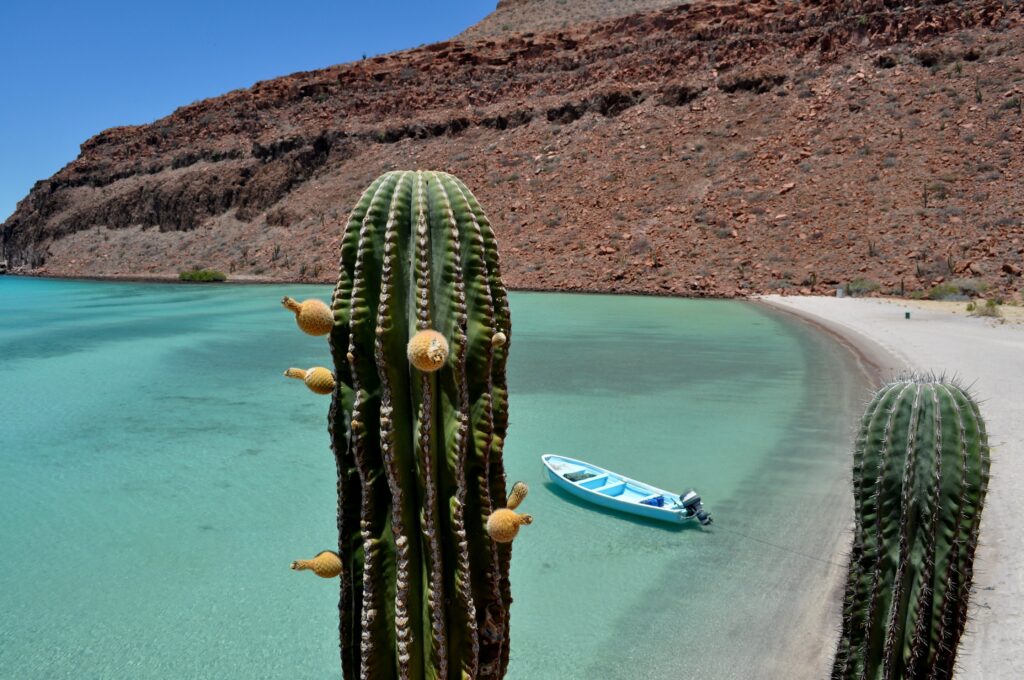
Is Baja California Safe to Visit?
The Mexican state of Baja California is a popular destination for tourists due to its location just south of the California border. In fact, residents of San Diego are only 17 miles from the Mexico border and can be in the city of Tijuana in under an hour.
While this is convenient for those looking for a quick and inexpensive vacation, is Baja California safe? Well, it really depends on where you go and what you plan to do while you visit.
Places like Tijuana are known to have a higher crime rate due to the drug activity that goes on there. However, if you stick to the patrolled areas and stay aware, you can have a safe and enjoyable trip.
There are several other great places to visit in Baja California. One of the most popular places in Baja California is Cabo .
Cabo is a top spot for tourists due to its luxury resorts, beaches, and nightlife. Whether you are going for a honeymoon or a family vacation, Cabo is a beautiful and fun destination.
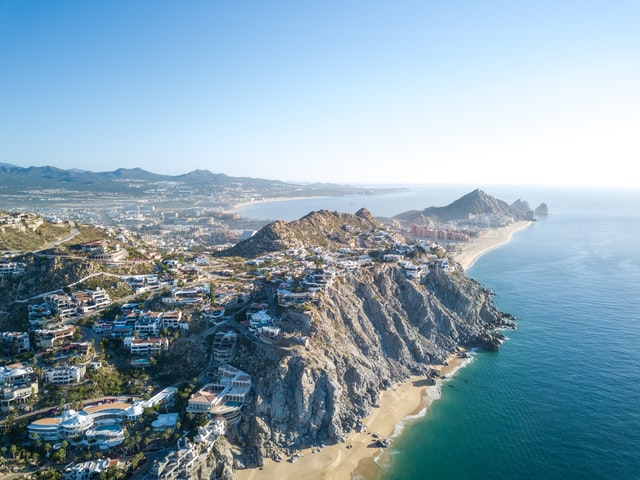
Other popular spots include Todos Santos, La Paz, and Ensenada, Mexico, which are all considered safe places to visit in Baja California. However, you will still need to take caution when visiting and not let your guard down. You can be a victim of crime anywhere if you don’t use common sense.
With that said, there are plenty of travelers who visit Baja California regularly without any issues. In fact, Baja California is a popular Mexican state for a campervan or RV trip, as there are numerous campgrounds, hiking trails, and beaches to explore throughout the region.
Let’s take a closer look at the crime rate to give you more of an idea of how safe Baja California is.
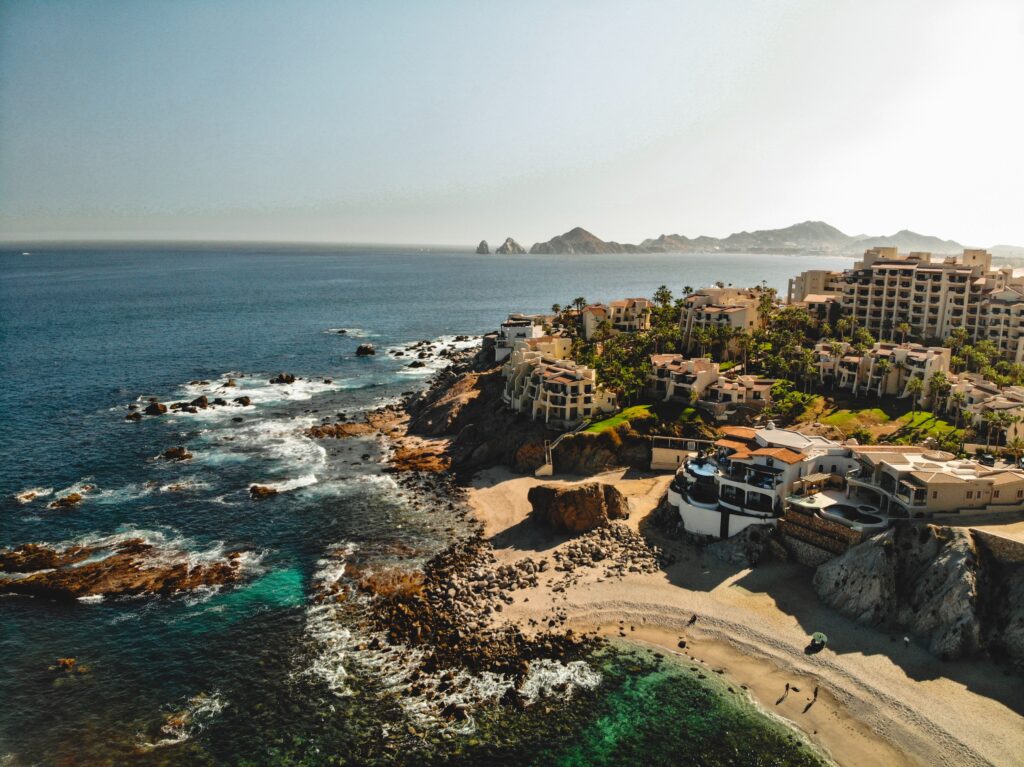
Is Baja California Safe: Crime Rate
Overall, Baja California has a moderate to low crime rate. While crime has been increasing in the past three years , that seems to be the norm in most countries due to the economic impacts of the pandemic. When more people are out of work, crime increases, primarily theft and drug-related activities.
You will see the same crime rate spike in other parts of Mexico, like Cancun and Puerto Vallarta . Here are some safety tips to follow to ensure you have an enjoyable and safe trip when exploring Baja California.
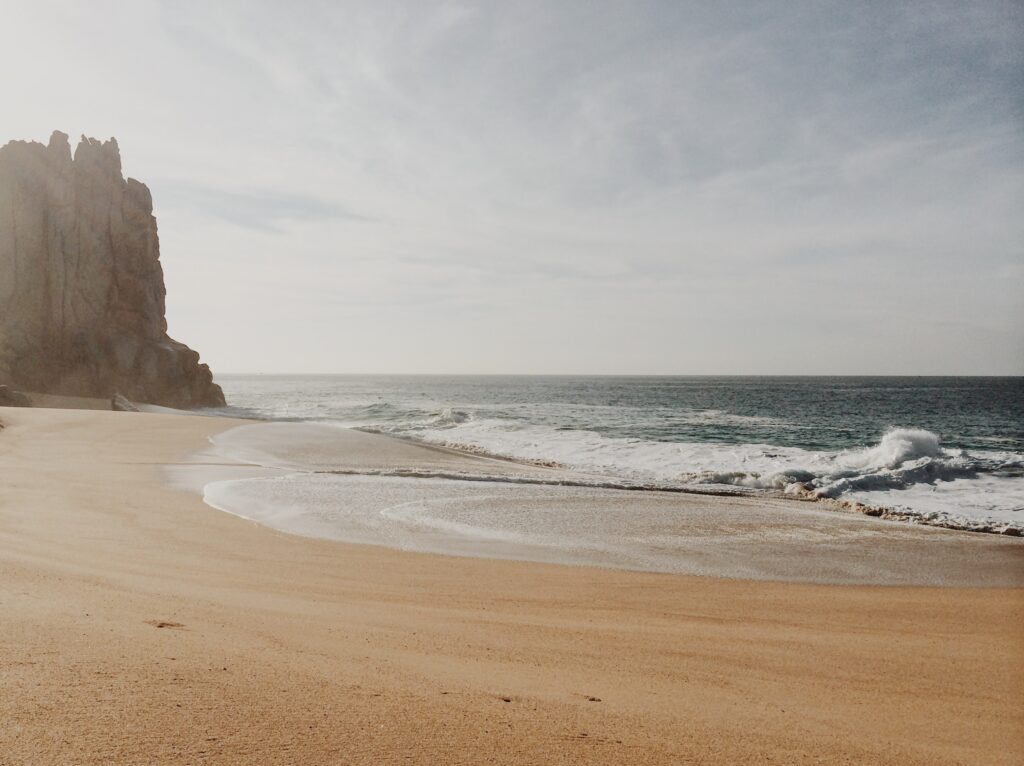
Do Your Research
It’s vital to do your research before traveling to Baja California as it’s a large state with several cities and towns. When you have chosen a place to visit, be sure to check where the best neighborhoods are to stay.
You won’t have to worry about this as much if you are staying at an all-inclusive resor t, but if you plan on booking a boutique hotel or Airbnb, then it’s good to know what areas are safe.
For example, even though La Paz and Cabo are two of the safer towns to visit in Baja California, there are still areas to avoid. Look into this before booking your accommodations.

Don’t Be Flashy
Many sources recommend to “blend in” while traveling in a new country, but that can be hard to do if you aren’t from there or don’t speak the local language.
To increase your chances of a safe trip, avoid being flashy and careless when you’re out and about. For example, when you walk around town, don’t bring nice items like your laptop or wear expensive jewelry. Also, don’t carry a lot of cash and only go to ATMs inside banks or in highly populated areas.
If you have a car, don’t leave anything in it, and make sure to lock the doors. More than likely, you won’t have an issue, but this will make you less likely to be a target of theft.
If you need to carry your valuable items with you, get a backpack lock, and make sure not to leave it unattended.
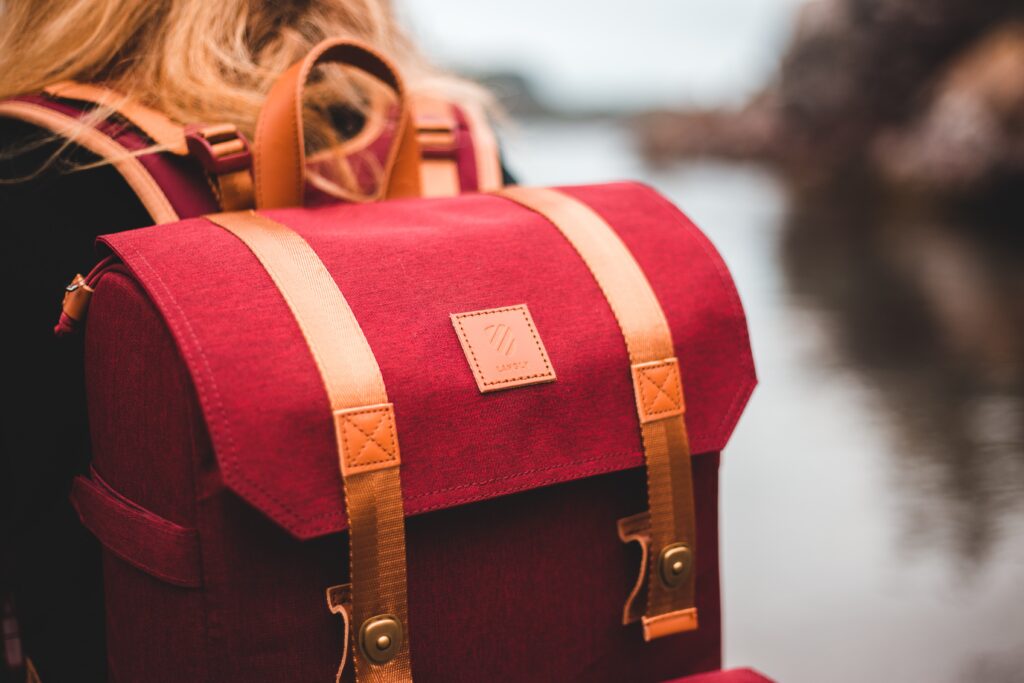
Avoid Drugs and Be Careful When Drinking
While you may not be interested in buying drugs on your honeymoon in Baja California, it won’t stop people from offering them to you. If you are out at night, then it’s best to stay clear of any drug activity. Not only can you be put in a bad situation with the police, but it could also be a setup to rob you.
If you go out at night, try to stay in pairs and stick to well-lit, populated areas. At bars, don’t accept drinks from strangers and keep your eyes on your drink at all times. Don’t get drunk, as that can make you careless and susceptible to danger.
Don’t Give Out Too Much Information
You will find the majority of locals in Mexico are very friendly and proud that you have chosen to visit their country. However, not everyone has good intentions and could be fishing for information.
It’s best to be vague when talking about where you are staying, where you are going, and any other personal information. Even if you are staying at a resort, don’t tell others what the resort’s name is. The same applies if you are staying at a hotel or Airbnb.
While the person you are directly talking to may have good intentions, you never know if someone overhearing your conversation doesn’t.
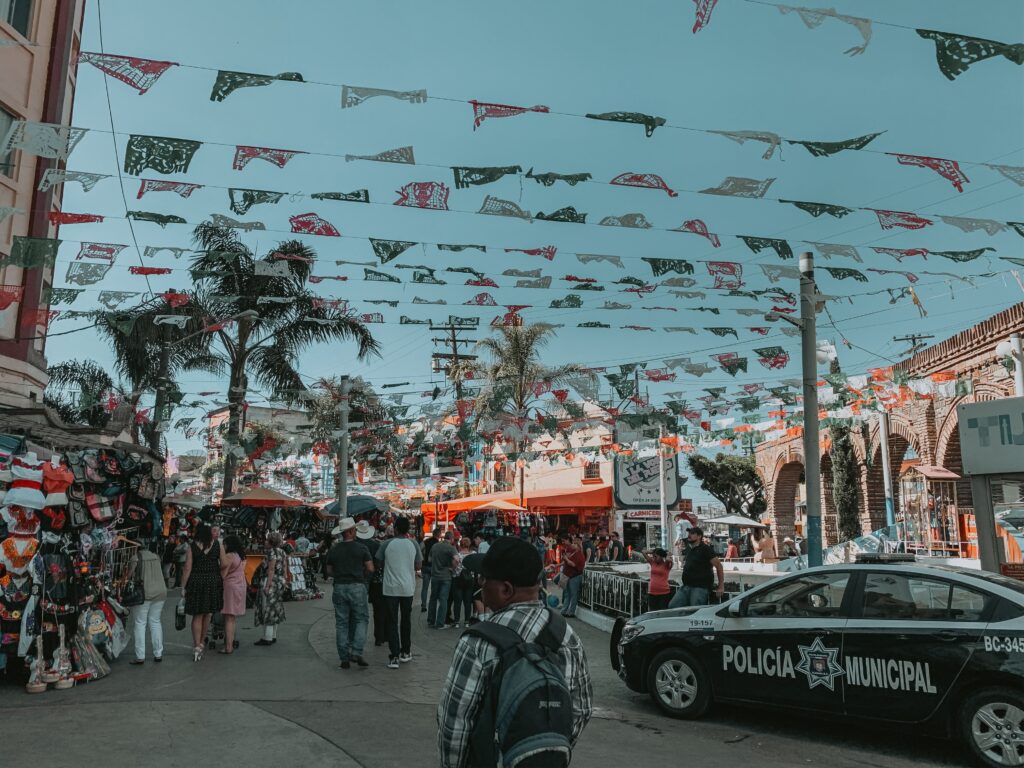
Is Baja California Safe: Driving
As mentioned earlier, Baja California is a big area with a lot to see, so it’s a prime road trip destination. In addition, cities and towns are spread out, so renting a car is the best way to visit different areas.
Driving in Baja California is generally safe as long as you stick to the main roads. You should also avoid driving at night as this is when cartel activity takes place. Plan your days out, so you are always driving during the day and don’t park in unknown areas.
It’s also a good idea to check that you have plenty of fuel before driving. Since Baja California is a vast landscape, you don’t want to run out of gas in an unknown area.
Lastly, check your vehicle or rental car before hitting the road. Ensure that your tires are inflated, turn signals are working properly, and fluid levels are good. As always, check and follow local driving laws to avoid getting a traffic violation.
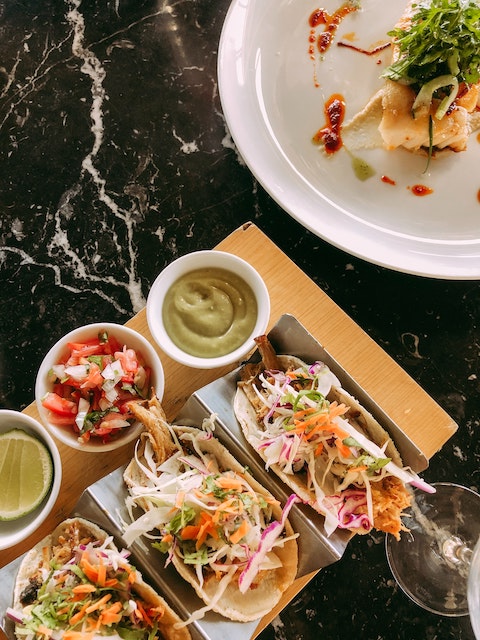
Is Baja California Safe: Food
You’d be crazy not to try the local street food in Baja California, or anywhere in Mexico, for that matter. You will find taco stands and fondas (mom-and-pop restaurants) all over, but be picky about the places you choose.
Not every place is diligent about its hygiene practices, and even someone with a strong stomach can get food poisoning. It’s best to stick to the popular places where you see locals eating. This is a good sign that the place is clean and the food is delicious.
Another way to avoid getting sick is to look up established restaurants on Google maps. You will be able to see what other tourists have said about it.
As you probably know, you should avoid tap water in Mexico, and that includes drinks with ice. Some places will make ice with tap water which can make you sick. Unless you are at a reputable restaurant or resort, then stick to bottled water and alcoholic drinks with no ice.
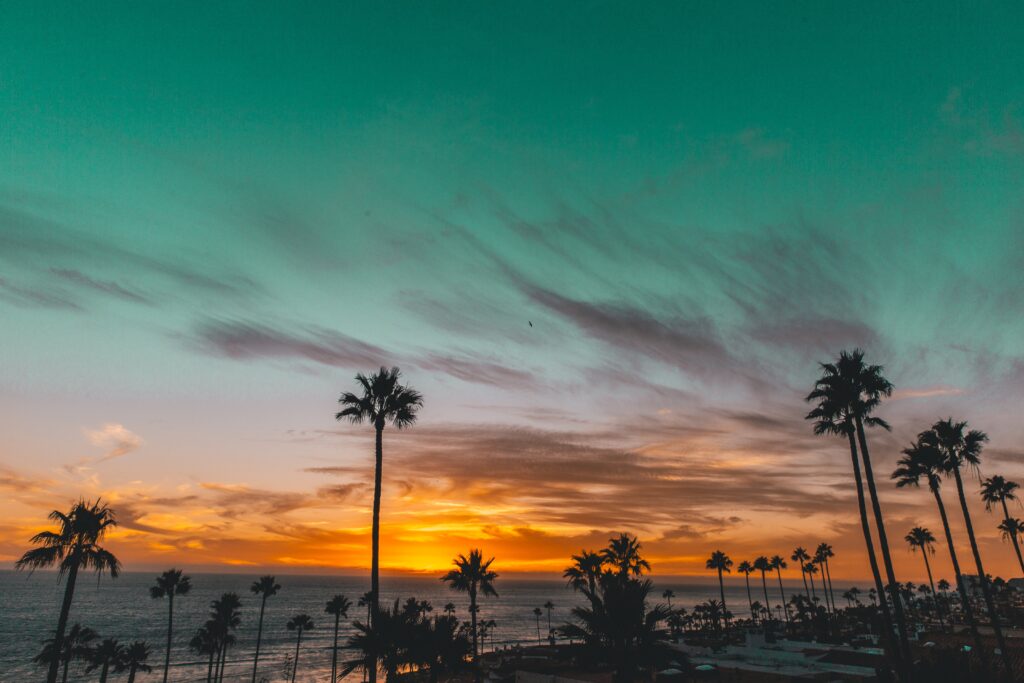
Where Is the Safest Place to Stay in Baja California?
While there are several safe places to stay in Baja California, here are the top suggestions.
La Paz is one of the safest cities to visit in Baja California, popular with families, couples, and solo travelers. Here you will find several white sand beaches, such as Balandra Beach.
It also offers a relaxed atmosphere where you can walk up and down the Malecon day and night. Some of the most popular activities include swimming with whale sharks, snorkeling with sea lions, and renting ATVs on the sand dunes.
Todos Santos
About an hour’s drive from La Paz is Todos Santos. You may remember the hit song “Hotel California” by the Eagles, which was written about this chill beach town. While Todos Santos isn’t as exciting as La Paz, there is still plenty to do, and it is a surfer’s delight.
Todos Santos has a good police presence, so you don’t need to worry about being a victim of crime when visiting.
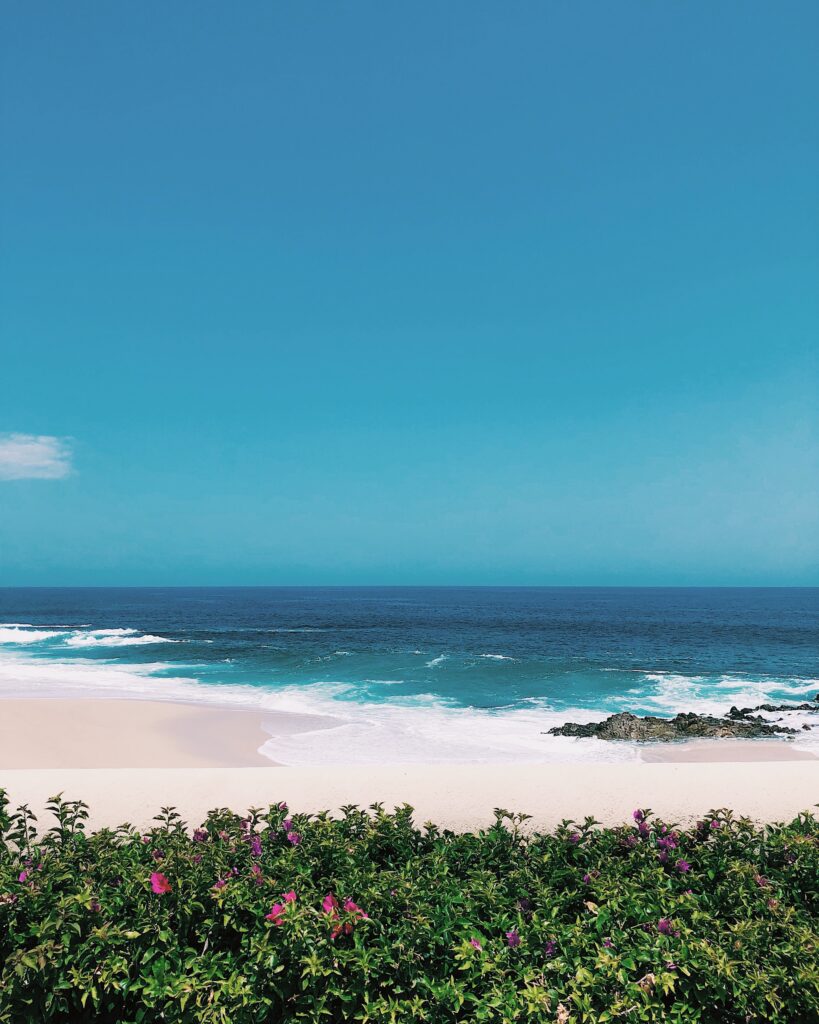
Cabo San Lucas and San Jose del Cabo are the two entities that makeup Los Cabos, which literally translates as “The Capes.” Both are safe areas for travelers and have plenty of activities to do.
Cabo San Lucas is known for its luxury resorts, beautiful beaches, and lively nightlife. San Jose del Cabo has a more relaxed vibe and is known for its art scene. Both are safe places to visit in Baja California and very popular for honeymoons and romantic retreats.

Trying to plan a honeymoon in Mexico? We have several articles that may help, such as Cozumel Honeymoons: All You Need to Know to Plan the Perfect Honeymoon in Cozumel, Mexico, Cancun vs. Cozumel: Which Is Best for Your Mexico Honeymoon or Vacation? , The Ultimate Playa del Carmen Honeymoon Planning Guide , and many more!
Ready to get started?
Get the help of a seasoned travel advisor. We'll help you make the best choice for your vacation, guide you through the travel planning process, and support you until you are back home.
Working with a travel advisor
You don't know what you don't know.
We visit the resorts we recommend regularly, leveraging our unbiased expertise to meet or exceed your expectations. From round-trip airfare and transfers to accommodations at top-notch resorts, we handle it all. Let us be your trusted travel partner, aiming not just for a single sale but a lasting relationship.
There are so many details we work through seamlessly because we do this every day and know how to work everything out to give you an amazing experience.
Don't waste any more time researching online when you can talk to an expert
Our travel experts are here to help you plan the perfect vacation. With over 20 years of experience in all-inclusive travel, we customize vacations to suit your preferences, ensuring competitive pricing.
- We provide personalized customer service to guide you before, during, and after your trip. We handle issues directly, avoiding large, impersonal call centers.
- We'll match or beat any legitimate quote.
- We have access to the best prices, promotions, and possible rate adjustments if resort prices drop after your down payment.
- Our relationships and connections in travel allow our clients to get upgrades and perks at the resorts they stay at.
What people say about us
We worked with Mike to plan our perfect honeymoon in Greece — he was amazing the whole way through and put together a trip we will cherish for our lifetime.
He was thoughtful with our suggestions, and provided some of his own without every pushing us. He stayed within our budgetary means but made it feel like we had a budget twice the size.
Dan and Michelle were such a joy to work with! They really made our trip and cruise successful. Based on our needs they were able to help us identify and schedule what side trips and activities would best suit our interests.
After this trip I will be using a travel agent for future vacations…just can’t wait for the next one they help us plan!
Honeymoon Always has been fantastic- our trips were 1000% better because of their help. The first time we used them we wanted to have a fun trip with some cultural experiences, good food, not too packed, and for a good price. It was fantastic and now we've used them for several trips in Europe, Central America, and the Caribbean. Each trip was so different but they were able to make each one special and unique to our needs.
Get In Touch
" * " indicates required fields
2 thoughts on “Is Baja California Safe in 2023?”
It’s a good article. It gears towards South baja california, mx. I live in a small town called LA Mision. Which is located between Rosarito and Ensenada. It is a very quiet town. Where everyone knows each other like cheers the show. It is close to the beach and town located in mountains. In the valley, we have farms. Who grow vegetables for top restaurants in Los Angeles. 20 minutes drive to Gulalupa is the wine country like Napa Valley. Where world class wine is made and won several awards at international level as #1 &2 spots. Crime rate here is not even close to 1%. I live here fir many years. It is very safe place. Where I don’t even lock my front door in night. People are very friendly and help anyone comes to this town. We have only 3 cops or even 2 cops at any given shift. Jail at the police station is always empty or maybe one person in jail for overnight due to drinking.we have 50/50 population of Americans and Mexicans. LA Mision is beautiful and very calm area. For outdoor activities. We have mountain climbing right behind my house, hiking, nature walks, bird watching, canoe rental, horse back riding, sand dooms for riding quads, swimming in fresh water coming down from mountains and lastly great sandy beautiful beach. Safety wise, you will not find another town in baja like LA mision. Even Los Cobos and LA Paz have higher crime rates than LA mision. Location wise, we are only one hour south of San ysidro border. To enjoy tijuana during day is only 45 minutes away. So you don’t have to spend several hours in driving. Ensenada is 20 minutes south of us. ROSARITO IS 15 MINUTES north of us before tijuana. You are welcome here and I be very happy to show you this little gem in baja california. You can walk 24 hrs day or night. Nobody bothers you. The places you mentioned in the articles are very nice places. But based on your headline. I say LA Mision should get the #1 spot for baja california. Which offers pretty much everything except night life. Most people living here are family oriented. We kept night life style out of this town so our families and children are safe.
A couple of corrections from a full time Baja expat. Baja California is actually two states, Baja California and Baja California Sur. Second, I have never seen any cartel activity in the Loreto area where I live. We don’t drive at night because cows like to stand on the warm road at night, not because of cartels. You should really add Loreto to your list. It is a Pueblo Magico and has an international airport with direct flights to the US and Canada and amazing restaurants. It is the Cabo of 30 years ago.
Leave a Comment Cancel reply

Following Recent Violence, How Safe Is Travel to Baja California in Mexico?
After three surfers were killed in ensenada, travelers may be wondering what kind of safety and security measures are in place for travel to the mexican state of baja california. experts offer their insights and advice..
- Copy Link copied

Locals and tour operators in the region advise travelers to use local guides and tour companies when they are traveling in Baja.
Photo by Yitzhak Rodrigguez/Unsplash
Baja California awoke to tragedy on Sunday, May 5. The bodies of three surfers had been discovered, tragically murdered under mysterious circumstances. The case is still under investigation, but it is believed that they were killed resisting a carjacking, CNN reported . The incident has sent shock waves through the tight-knit surfing community and the community of travelers who have been touring Baja for years. It has prompted concerns about the region’s safety among travelers looking to take a trip to the peninsula.
The victims, identified as Jack Carter Rhoad (an American) and Australian brothers Jake and Callum Robinson, were found with gunshot wounds to the head. According to CBS News , the suspect in custody, Jesus Gerardo “N”, aka “El Kekas,” is being prosecuted. The three men had been camping in a remote beachside area when they were killed in what investigators are saying was a robbery attempt.
“Our hearts are broken and the world has become a darker place for us,” Debra Robinson, the mother of the two Australian brothers, said in a tribute . “They were young men enjoying their passion of surfing together.”
The crime is a stark reminder of the inherent risks associated with travel to any destination, no matter how idyllic it may seem. It also is a reminder to travelers to be extremely vigilant.
“The incident took place in a remote region, and the victims were wild-camping alone with no facilities, campground, or other infrastructure—no electricity, mobile phone connectivity, or even paved roads,” Zach Rabinor, CEO of Journey Mexico , a luxury destination management company based in Mexico, told a concerned client—a response he then shared with Afar.
We need to keep in mind that this is a random act of violence and not the case for most of the Baja.
Rabinor’s advice to travelers in the region is to avoid overnighting and wild-camping in remote areas. If you are going to adventure, it is best to travel in groups, even during the day, with a local expert planning and leading the expedition—an expert who has access to real-time, local intelligence.
“We offer our clients fully guided trip extensions in Baja,” said Todd Smith, founder and president of AdventureSmith Explorations , an expedition cruise and wilderness tour operator with tours to Baja. “A lot of people in North America don‘t realize this is a thing. You can go to the islands in the Sea of Cortez. You can go to beautiful beaches with not a soul around. There is this great adventure, and it‘s so cool. We want to raise awareness that fully guided trips are a thing in Baja.”
If you are traveling on your own, staying in reputable hotels or marked campsites is always the safer choice.
“There’s no boondocking in Baja. It’s all private land,” said Nathan Stuart, co-founder and guide with Legends Overlanding . “If you’re somewhere where you think you’re in the middle of nowhere and you think you’re staying for free, you’re only staying for free if the owner doesn’t come and charge you.”
The Mexican state of Baja California borders California. It is home to popular tourist destinations like Tijuana, Rosarito, and Ensenada. When it comes to tourism, Mexico is generally considered a safe destination for travelers, and any attacks directly involving tourists are extremely rare. Still, Mexico is a country that has its share of crime and corruption, like many other countries in the world. Violent crime, including kidnapping and human trafficking, is a risk in parts of the country. As of August 2023, the U.S. State Department has issued a Level 3 classification for the state of Baja California, advising visitors to “reconsider travel,” specifically because of crime and kidnapping.
“The aggression to these three people, a regrettable attack, had nothing to do with these three being surfers. They were killed because they were at the wrong moment,” said Baja California Attorney General María Elena Andrade Ramírez in a taped press conference.
Baja California is not the only tourist destination in the world with a Level 3 advisory. Guatemala, Colombia, and Jamaica also share Level 3 status .
“It‘s also important to put this into perspective in the context of international travel,” Rabinor‘s response continued, noting that violent acts occur throughout the world, including in developing and developed countries, such as the United States, the United Kingdom, and others.
While the incident was an unexpected and horrific tragedy, many parts of Baja are still considered safe, including the tourist areas of Ensenada and Rosarito, as well as the tourist destinations in the southern half of the peninsula in the state of Baja California Sur.
Baja California Sur, which has a Level 2 advisory , is home to popular resort destinations such as Los Cabos, Todos Santos, La Paz, and Loreto.
“I am so devastated about what happened to these young men. As a parent I cannot imagine the grief [theirs] are dealing with,” said Sharon Walters, founder of Sharon Walters Travel , and a homeowner in Baja California Sur. “Unfortunately, the border towns between the U.S. and Mexico along the northern part of Baja can sometimes be a difficult place to visit. While this part of Baja has endless beautiful beaches, there is an element of danger here due to lack of policing and remote locations.”
She added, “Just as you would in any location, it is best to stick to the touristed areas and check with locals and hotel staff about what places to avoid. When something like this happens in Mexico, it seems to get extra bad press than it would in other countries. But we need to keep in mind that this is a random act of violence and not the case for most of the Baja.”
The tragedy highlights the need for travelers to be responsible and informed when embarking on their adventures. This means staying abreast of travel advisories, heeding local customs and laws, and exercising caution and vigilance at all times.

- Travel Advisories |
- Contact Us |
- MyTravelGov |
Find U.S. Embassies & Consulates
Travel.state.gov, congressional liaison, special issuance agency, u.s. passports, international travel, intercountry adoption, international parental child abduction, records and authentications, popular links, travel advisories, mytravelgov, stay connected, legal resources, legal information, info for u.s. law enforcement, replace or certify documents.
Share this page:
Mexico Travel Advisory
Travel advisory september 6, 2024, mexico - see state summaries.
Reissued after periodic review with updates for Chiapas, and Durango.
Country Summary: Violent crime – such as homicide, kidnapping, carjacking, and robbery – is widespread and common in Mexico. The U.S. government has limited ability to provide emergency services to U.S. citizens in many areas of Mexico, as travel by U.S. government employees to certain areas is prohibited or restricted. In many states, local emergency services are limited outside the state capital or major cities.
U.S. citizens are advised to adhere to restrictions on U.S. government employee travel. State-specific restrictions are included in the individual state advisories below. U.S. government employees may not travel between cities after dark, may not hail taxis on the street, and must rely on dispatched vehicles, including app-based services like Uber, and regulated taxi stands. U.S. government employees should avoid traveling alone, especially in remote areas. U.S. government employees may not drive from the U.S.-Mexico border to or from the interior of Mexico, except daytime travel within Baja California and between Nogales and Hermosillo on Mexican Federal Highway 15D, between Nuevo Laredo and Monterrey on Highway 85D and between Ciudad Juarez and interior cities as noted in the Chihuahua section. Read the country information page for additional information on travel to Mexico.
Do Not Travel To:
- Colima state due to crime and kidnapping .
- Guerrero state due to crime .
- Michoacan state due to crime .
- Sinaloa state due to crime .
- Tamaulipas state due to crime and kidnapping.
- Zacatecas state due to crime and kidnapping .
Reconsider Travel To:
- Baja California state due to crime and kidnapping .
- Chiapas state due to crime .
- Chihuahua state due to crime and kidnapping .
- Guanajuato state due to crime .
- Jalisco state due to crime and kidnapping .
- Morelos state due to crime and kidnapping .
- Sonora state due to crime and kidnapping .
Exercise Increased Caution When Traveling To:
- Aguascalientes state due to crime .
- Baja California Sur state due to crime .
- Coahuila state due to crime .
- Durango state due to crime .
- Hidalgo state due to crime .
- Mexico City due to crime .
- Mexico State due to crime and kidnapping .
- Nayarit state due to crime .
- Nuevo Leon state due to crime .
- Oaxaca state due to crime .
- Puebla state due to crime and kidnapping .
- Queretaro state due to crime .
- Quintana Roo state due to crime .
- San Luis Potosi state due to crime and kidnapping .
- Tabasco state due to crime .
- Tlaxcala state due to crime .
- Veracruz state due to crime .
Exercise Normal Precautions When Traveling To:
- Campeche state
- Yucatan state
Visit our website for Travel to High-Risk Areas .
If you decide to travel to Mexico:
- Keep traveling companions and family back home informed of your travel plans. If separating from your travel group, send a friend your GPS location. If taking a taxi alone, take a photo of the taxi number and/or license plate and text it to a friend.
- Use toll roads when possible and avoid driving alone or at night. In many states, police presence and emergency services are extremely limited outside the state capital or major cities.
- Exercise increased caution when visiting local bars, nightclubs, and casinos.
- Do not display signs of wealth, such as wearing expensive watches or jewelry.
- Be extra vigilant when visiting banks or ATMs.
- Enroll in the Smart Traveler Enrollment Program (STEP) to receive Alerts and make it easier to locate you in an emergency.
- Follow the Department of State on Facebook and X/Twitter .
- Follow the U.S. Embassy on Facebook and X/Twitter .
- Review the Country Security Report for Mexico.
- Mariners planning travel to Mexico should check for U.S. maritime advisories and alerts , which include instructions on reporting suspicious activities and attacks to Mexican naval authorities.
- Prepare a contingency plan for emergency situations. Review the Traveler’s Checklist .
- Visit the CDC page for the latest travel health information related to your travel.
Aguascalientes state – Exercise Increased Caution
Exercise increased caution due to crime.
Criminal activity and violence may occur throughout the state.
There are no restrictions on travel for U.S. government employees in Aguascalientes state.
Baja California state – Reconsider Travel
Reconsider travel due to crime and kidnapping.
Transnational criminal organizations compete in the border area to establish narco-trafficking and human smuggling routes. Violent crime and gang activity are common. Travelers should remain on main highways and avoid remote locations. Of particular concern is the high number of homicides in the non-tourist areas of Tijuana. Most homicides appeared to be targeted; however, criminal organization assassinations and territorial disputes can result in bystanders being injured or killed. U.S. citizens and LPRs have been victims of kidnapping.
U.S. government employees must adhere to the noted restrictions:
- Mexicali Valley: U.S. government employees should avoid the Mexicali Valley due to the heightened possibility of violence between rival cartel factions. The boundaries of the restricted area are: to the east, the Baja California/Arizona and Baja California/Sonora borders; to the south, from La Ventana (on Highway 5) due east to the Colorado River; to the west, Highway 5; and to the north, Boulevard Lazaro Cardenas/Highway 92/Highway 1 to Carretera Aeropuerto, from the intersection of Highway 1 and Carretera Aeropuerto due north to the Baja California/California border, and from that point eastward along the Baja California/California border.
- Travelers may use Highways 2 and 2D to transit between Mexicali, Los Algodones, and San Luis Rio Colorado during daylight hours. Travelers may also use Highways 1 and 8 to transit to and from the Mexicali Airport during daylight hours. Travel on Highway 5 is permissible during daylight hours.
To view a map of the restricted areas, visit https://mx.usembassy.gov/maps-of-restricted-areas There are no other travel restrictions for U.S. government employees in Baja California state. These include high-traffic tourism areas of border and coastal communities, such as Tijuana , Ensenada , and Rosarito .
Baja California Sur state – Exercise Increased Caution
There are no restrictions on travel for U.S. government employees in Baja California Sur state.
Campeche state – Exercise Normal Precautions
Exercise normal precautions.
There are no restrictions on travel for U.S. government employees in Campeche state.
Chiapas state – Reconsider Travel
Reconsider travel due to crime.
U.S. government employees may not travel to the municipality of Ocozocoautla and to the following restricted areas in the southeastern region. All areas within the boundaries, including highway and roads unless specifically exempted, are restricted. East-Northeast Boundary: the eastern boundary follows the Mexican-Guatemalan border from the southern point on the Pacific coast, along the border, to the northern end point east of Netzahualcóyotl. Northern Boundary: from Netzahualcóyotl in a straight line southwest towards the northern limit of Ocosingo. Western Boundary: from Ocosingo in a straight-line south to El Ocote, from El Ocote in a straight-line west to San Francisco Pujiltic, from San Franciso Pujiltic southwest to just north of Mapastepec. South-Southwest Boundary: Highway 200 from Mapastepec to Tapachula. All towns along this highway are not restricted. The area to the north of highway 200 defines the southern boundary of the restricted area. From Tapachula, the restricted area boundary is north and east of the city limits and then extends southeast to the Pacific coast at Tres Hermanos San Isidro.
U.S. government employees may travel to Tapachula within the city limits and on Highway 225, from Port Chiapas to Tapachula, including the Tapachula Airport.
To view a map of the restricted areas, visit https://mx.usembassy.gov/maps-of-restricted-areas
Chihuahua state – Reconsider Travel
Violent crime and gang activity are common. Most homicides are targeted assassinations against members of criminal organizations. Battles for territory between criminal groups have resulted in violent crime in areas frequented by U.S. citizens and U.S. government employees, including restaurants and malls during daylight hours. Bystanders have been injured or killed in shooting incidents. U.S. citizens and LPRs have been victims of kidnapping.
U.S. government employee travel is limited to the following areas with the noted restrictions:
- Ciudad Juarez: U.S. government employees may travel to the area of Ciudad Juarez bounded to the east by Bulevar Independencia; to the south by De los Montes Urales/Avenida Manuel J Clouthier/Carretera de Juárez; to the west by Via Juan Gabriel/Avenida de los Insurgentes/Calle Miguel Ahumada/Francisco Javier Mina/Melchor Ocampo; and to the north by the U.S.-Mexico border. Direct travel to the Ciudad Juarez airport (officially called the Abraham González International Airport) and the factories located along Bulevar Independencia and Las Torres is permitted. Travel to San Jerónimo is permitted only through the United States via the Santa Teresa U.S. Port of Entry; travel via Anapra is prohibited.
U.S. government employees may only travel from Ciudad Juarez to the city of Chihuahua during daylight hours via Federal Highway 45, with stops permitted only at the Guardia Nacional División Caminos station, the Umbral del Milenio overlook area, the border inspection station at KM 35, and the shops and restaurants on Federal Highway 45 in the city of Ahumada.
- U.S. government employees may travel between Ciudad Juarez and Ascension via Highway 2.
- Nuevo Casas Grandes Area (including Nuevo Casas Grandes, Casas Grandes, Mata Ortiz, Colonia Juárez, Colonia LeBaron, Paquimé and San Buenaventura): U.S. government employees may travel to the Nuevo Casas Grandes area during daylight hours via Mexico Federal Highway 2, and subsequently Federal Highway 10, to Nuevo Casas Grandes. Employees are permitted to stay overnight in the cities of Nuevo Casas Grandes and Casas Grandes only.
- City of Chihuahua: U.S. government employees may travel at any time to the area of the city of Chihuahua bounded to the north by Avenida Transformación; to the east by Avenida Tecnológico/Manuel Gómez Morín/Highway 16/Blvd.José Fuentes Mares; to the west by the city boundary; and to the south by Periférico Francisco R. Almada.
- U.S. government employees may travel on Highways 45, 16, and 45D through the city of Chihuahua and to the Chihuahua airport (officially called the General Roberto Fierro Villalobos International Airport).
- U.S. government employees may travel to Santa Eulalia to the east of the city of Chihuahua, as well as to Juan Aldama via Highway 16 to the northeast.
- U.S. government employees may travel south of the city of Chihuahua on Highway 45 to the southern boundary of Parral, including each town directly connected to Highway 45, including Lázaro Cárdenas, Pedro Meoqui, Santa Cruz de Rosales, Delicias, Camargo, Ciudad Jiménez, and Parral itself.
- U.S. government employees may only travel on official business from the city of Chihuahua on Highway 16 to Ciudad Cuauhtémoc bounded by Highway 21 to the north and east, Highway 5 to the west, and Bulevar Jorge Castillo Cabrera to the south.
- Ojinaga: U.S. government employees must travel to Ojinaga via U.S. Highway 67 and enter through the U.S. Port of Entry in Presidio, Texas.
- Palomas: U.S. government employees may travel to Palomas via U.S. highways through the U.S. Port of Entry in Columbus, New Mexico, or via Highway 2 in Mexico.
To view a map of the restricted areas, visit https://mx.usembassy.gov/maps-of-restricted-areas U.S. government employees may not travel to other areas of Chihuahua, including Copper Canyon .
Coahuila state – Exercise Increased Caution
Violent crime and gang activity occur in parts of Coahuila state.
U.S. government employees must adhere to the following travel restrictions:
- Zaragoza, Morelos, Allende, Nava, Jimenez, Villa Union, Guerrero, and Hidalgo municipalities : U.S. government employees may not travel to these municipalities.
- Piedras Negras and Ciudad Acuña: U.S. government employees must travel directly from the United States and observe a curfew from midnight to 6:00 a.m. in both cities.
To view a map of the restricted areas, visit https://mx.usembassy.gov/maps-of-restricted-areas There are no other restrictions on travel for U.S. government employees in Coahuila state.
Colima state – Do Not Travel
Do not travel due to crime and kidnapping.
Violent crime and gang activity are widespread. Most homicides are targeted assassinations against members of criminal organizations. Shooting incidents between criminal groups have injured or killed bystanders. U.S. citizens and LPRs have been victims of kidnapping.
Travel for U.S. government employees is limited to the following areas with noted restrictions:
- Manzanillo: U.S. government employee travel is limited to the tourist and port areas of Manzanillo.
- Employees traveling to Manzanillo from Guadalajara must use Federal Toll Road 54D during daylight hours.
To view a map of the restricted areas, visit https://mx.usembassy.gov/maps-of-restricted-areas U.S. government employees may not travel to other areas of Colima state.
Durango state – Exercise Increased Caution
Violent crime and gang activity are common in parts of Durango state.
- West and south of Federal Highway 45: U.S. government employees may not travel to this region of Durango state.
To view a map of the restricted areas, visit https://mx.usembassy.gov/maps-of-restricted-areas There are no other restrictions on travel for U.S. government employees in Durango state.
Guanajuato state – Reconsider Travel
Gang violence, often associated with the theft of petroleum and natural gas from the state oil company and other suppliers, occurs in Guanajuato, primarily in the south and central areas of the state. Of particular concern is the high number of murders in the southern region of the state associated with cartel-related violence. U.S. citizens and LPRs have been victims of kidnapping.
- Areas south of Federal Highway 45D: U.S. government employees may not travel to the area south of and including Federal Highway 45D, Celaya, Salamanca, and Irapuato.
To view a map of the restricted areas, visit https://mx.usembassy.gov/maps-of-restricted-areas There are no other restrictions on travel for U.S. government employees in Guanajuato state, which includes tourist areas in: San Miguel de Allende , Guanajuato City , and surrounding areas.
Guerrero state – Do Not Travel
Do not travel due to crime.
Crime and violence are widespread. Armed groups operate independently of the government in many areas of Guerrero. Members of these groups frequently maintain roadblocks and may use violence towards travelers. U.S. citizens and LPRs have been victims of kidnapping in previous years.
U.S. government employees may not travel to any area in the state of Guerrero, including to tourist areas in Acapulco , Zihuatanejo , Taxco , and Ixtapa .
Hidalgo state – Exercise Increased Caution
There are no restrictions on travel for U.S. government employees in Hidalgo state.
Jalisco state – Reconsider Travel
Violent crime and gang activity are common in parts of Jalisco state. In Guadalajara, territorial battles between criminal groups take place in tourist areas. Shooting incidents between criminal groups have injured or killed innocent bystanders. U.S. citizens and LPRs have been victims of kidnapping.
- Jalisco-Michoacan border and Federal Highway 110: U.S. government employees may not travel to the area between Federal Highway 110 and the Jalisco-Michoacan border, nor travel on Federal Highway 110 between Tuxpan, Jalisco, and the Michoacan border.
- Federal Highway 80: U.S. government employees may not travel on Federal Highway 80 south of Cocula.
To view a map of the restricted areas, visit https://mx.usembassy.gov/maps-of-restricted-areas There are no other restrictions on travel for U.S government employees in Jalisco state which includes tourist areas in: Guadalajara Metropolitan Area , Puerto Vallarta (including neighboring Riviera Nayarit) , Chapala , and Ajijic .
Mexico City (Ciudad de Mexico) – Exercise Increased Caution
Both violent and non-violent crime occur throughout Mexico City. Use additional caution, particularly at night, outside of the frequented tourist areas where police and security patrol more routinely. Petty crime occurs frequently in both tourist and non-tourist areas.
There are no restrictions on travel for U.S. government employees in Mexico City.
Mexico State (Estado de Mexico) – Exercise Increased Caution
Exercise increased caution due to crime and kidnapping.
Both violent and non-violent crime occur throughout Mexico State. Use additional caution in areas outside of the frequented tourist areas, although petty crime occurs frequently in tourist areas as well. U.S. citizens and LPRs have been victims of kidnapping. There are no restrictions on travel for U.S. government employees in Mexico State.
Michoacan state – Do Not Travel
Do not travel due to crime and kidnapping.
Crime and violence are widespread in Michoacan state. Travel for U.S. government employees is limited to the following areas with the noted restrictions:
- Federal Highway 15D: U.S. government employees may travel on Federal Highway 15D to transit the state between Mexico City and Guadalajara.
- Morelia: U.S. government employees may travel by air and by land using Federal Highways 43 or 48D from Federal Highway 15D.
- Lazaro Cardenas: U.S. government employees must travel by air only and limit activities to the city center or port areas.
To view a map of the restricted areas, visit https://mx.usembassy.gov/maps-of-restricted-areas U.S. government employees may not travel to other areas of the state of Michoacan, including the portions of the Monarch Butterfly Reserve located in Michoacan.
Morelos state – Reconsider Travel
Reconsider travel due to crime and kidnapping.
Violent crime and gang activity are common in parts of Morelos state. U.S. citizens and LPRs have been victims of kidnapping.
There are no restrictions on travel for U.S. government employees in Morelos state.
Nayarit state – Exercise Increased Caution
Criminal activity and violence may occur throughout Nayarit state.
There are no restrictions on travel for U.S government employees in Nayarit state.
Nuevo Leon state – Exercise Increased Caution
Criminal activity and violence may occur throughout the state. There are no restrictions on travel for U.S. government employees in Nuevo Leon state.
Oaxaca state – Exercise Increased Caution
Criminal activity and violence occur throughout the state.
U.S. travelers are reminded that U.S. government employees must adhere to the following travel restrictions:
- Isthmus region: U.S. government employees may not travel to the area of Oaxaca bounded by Federal Highway 185D to the west, Federal Highway 190 to the north, and the Oaxaca-Chiapas border to the east. This includes the cities of Juchitan de Zaragoza, Salina Cruz, and San Blas Atempa.
- Federal Highway 200 northwest of Pinotepa: U.S. government employees may not use Federal Highway 200 between Pinotepa and the Oaxaca-Guerrero border.
To view a map of the restricted areas, visit https://mx.usembassy.gov/maps-of-restricted-areas There are no restrictions on travel for U.S. government employees to other parts of Oaxaca state, which include tourist areas in: Oaxaca City , Monte Alban , Puerto Escondido, and Huatulco .
Puebla state – Exercise Increased Caution
Exercise increased caution due to crime and kidnapping.
Criminal activity and violence may occur throughout the state. U.S. citizens and LPRs have been victims of kidnapping.
There are no restrictions on travel for U.S. government employees in Puebla state.
Queretaro state – Exercise Increased Caution
There are no restrictions on travel for U.S. government employees in Queretaro state.
Quintana Roo state – Exercise Increased Caution
Criminal activity and violence may occur in any location, at any time, including in popular tourist destinations. While not directed at tourists, shootings between rival gangs have injured and killed innocent bystanders, including U.S. citizens. Violent crime, including homicides and assaults, has increased in Tulum.
There are no restrictions on travel for U.S. government employees in Quintana Roo state. Exercise increased caution after dark in Cancun, Playa del Carmen, and Tulum and remain in well-lit pedestrian streets and tourist zones.
San Luis Potosi state – Exercise Increased Caution
There are no restrictions on travel for U.S. government employees in San Luis Potosi state.
Sinaloa state – Do Not Travel
Violent crime is widespread. Criminal organizations are based in and operating in Sinaloa.
Travel for U.S. government employees is limited to the following areas with the noted restrictions:
- Mazatlan: U.S. government employees may travel to Mazatlan by air or sea only, are limited to the Zona Dorada and historic town center, and must travel via direct routes between these destinations and the airport and sea terminal.
- Los Mochis and Topolobampo: U.S. government employees may travel to Los Mochis and Topolobampo by air or sea only, are restricted to the city and the port, and must travel via direct routes between these destinations and the airport.
To view a map of the restricted areas, visit https://mx.usembassy.gov/maps-of-restricted-areas U.S. government employees may not travel to other areas of Sinaloa state.
Sonora state – Reconsider Travel
Sonora is a key location used by the international drug trade and human trafficking networks. Violent crime is widespread. U.S. citizens and LPRs have been victims of kidnapping. Travelers should maintain a heightened level of awareness of their surroundings in all their travels in Sonora. Security incidents may occur in any area of Sonora.
- Travel between Hermosillo and Nogales: U.S. government employees may travel between the U.S. Ports of Entry in Nogales and Hermosillo during daylight hours via Federal Highway 15 only. U.S. government employees may not use ANY taxi services, public buses, nor ride-share applications due to a lack of secure vetting and/or dispatching procedures. Travelers should exercise caution and avoid unnecessary stops as security incidents, including sporadic, armed carjackings, and shootings have been reported along this highway during daylight hours. Travelers should have a full tank of gas and inform friends or family members of their planned travel.
- Nogales: U.S. government employees may not travel in the triangular area north of Avenida Tecnologico, west of Bulevar Luis Donaldo Colosio (Periferico), nor east of Federal Highway 15D (Corredor Fiscal). U.S. government employees also may not travel in the residential and business areas to east of the railroad tracks along Plutarco Elias Calle (HWY 15) and Calle Ruiz Cortino, including the business area around the Morley pedestrian gate port-of-entry. U.S. government employees may not use ANY taxi services, public buses, nor ride-share applications in Nogales due to a lack of secure vetting and/or dispatching procedures and the danger of kidnapping and other violent crimes.
- Puerto Peñasco: U.S. government employees may travel between Puerto Peñasco and the Lukeville-Sonoyta U.S. Port of Entry during daylight hours via Federal Highway 8 only. They may not travel on any other route to Puerto Peñasco. U.S. government employees may not use ANY taxi services, public buses, nor ride-share applications in Puerto Peñasco. due to a lack of secure vetting and/or dispatching procedures and the danger of kidnapping and other violent crimes.
- Triangular region near Mariposa U.S. Port of Entry: U.S. government employees may not travel into or through the triangular region west of the Mariposa U.S. Port of Entry, east of Sonoyta, and north of Altar municipality.
- San Luis Rio Colorado, Cananea, and Agua Prieta : U.S. government employees may travel directly from the nearest U.S. Port of Entry to San Luis Rio Colorado, Cananea (via Douglas Port of Entry), and Agua Prieta, but may not go beyond the city limits. Travel is limited to daylight hours only. Travel between Nogales and Cananea via Imuris is not permitted. U.S. government employees may not use ANY taxi services, public buses, nor ride-share applications in these cities due to a lack of secure vetting and/or dispatching procedures and the danger of kidnapping and other violent crimes.
- Eastern and southern Sonora (including San Carlos Nuevo Guaymas and Alamos): U.S. government employees may not travel to areas of Sonora east of Federal Highway 17, the road between Moctezuma and Sahuaripa, and State Highway 20 between Sahuaripa and the intersection with Federal Highway 16. U.S. government employees may travel to San Carlos Nuevo Guaymas and Alamos; travel to Alamos is only permitted by air and within city limits. U.S. government employees may not travel to areas of Sonora south of Federal Highway 16 and east of Federal Highway 15 (south of Hermosillo), as well as all points south of Guaymas, including Empalme, Guaymas, Obregon, and Navojoa. U.S. government employees may not use ANY taxi services, public buses, nor ride-share applications in these areas due to a lack of secure vetting and/or dispatching procedures and the danger of kidnapping and other violent crimes.
To view a map of the restricted areas, visit https://mx.usembassy.gov/maps-of-restricted-areas U.S. government employees may travel to other parts of Sonora state in compliance with the above restrictions, including tourist areas in: Hermosillo , Bahia de Kino , and Puerto Penasco .
Tabasco state – Exercise Increased Caution
There are no restrictions on travel for U.S. government employees in Tabasco state.
Tamaulipas state – Do Not Travel
Organized crime activity – including gun battles, murder, armed robbery, carjacking, kidnapping, forced disappearances, extortion, and sexual assault – is common along the northern border and in Ciudad Victoria. Criminal groups target public and private passenger buses, as well as private automobiles traveling through Tamaulipas, often taking passengers and demanding ransom payments.
Heavily armed members of criminal groups often patrol areas of the state and operate with impunity particularly along the border region from Reynosa to Nuevo Laredo. In these areas, local law enforcement has limited capacity to respond to incidents of crime. Law enforcement capacity is greater in the tri-city area of Tampico, Ciudad Madero, and Altamira, which has a lower rate of violent criminal activity compared to the rest of the state. U.S. citizens and LPRs have been victims of kidnapping. U.S. citizens and LPRs have been victims of kidnapping.
- Matamoros and Nuevo Laredo: U.S. government employees may only travel within a limited radius around and between the U.S. Consulates in Nuevo Laredo and Matamoros, their homes, the respective U.S. Ports of Entry, and limited downtown sites, subject to an overnight curfew.
- Overland travel in Tamaulipas: U.S. government employees may not travel between cities in Tamaulipas using interior Mexican highways. Travel between Nuevo Laredo and Monterrey is limited to Federal Highway 85D during daylight hours with prior authorization.
To view a map of the restricted areas, visit https://mx.usembassy.gov/maps-of-restricted-areas U.S. government employees may not travel to other parts of Tamaulipas state.
Tlaxcala state – Exercise Increased Caution
There are no restrictions on travel for U.S. government employees in Tlaxcala state.
Veracruz state – Exercise Increased Caution
Violent crime and gang activity occur with increasing frequency in Veracruz, particularly in the center and south near Cordoba and Coatzacoalcos. While most gang-related violence is targeted, violence perpetrated by criminal organizations can affect bystanders. Impromptu roadblocks requiring payment to pass are common. There are no restrictions on travel for U.S. government employees in Veracruz state.
Yucatan state – Exercise Normal Precautions
There are no restrictions on travel for U.S. government employees in Yucatan state, which include tourist areas in: Chichen Itza , Merida , Uxmal , and Valladolid .
Zacatecas state – Do Not Travel
Violent crime, extortion, and gang activity are widespread in Zacatecas state. U.S. citizens and LPRs have been victims of kidnapping.
- Zacatecas City : U.S. government employee travel is limited to Zacatecas City proper, and employees may not travel overland to Zacatecas City.
- U.S. government employees may not travel to other areas of Zacatecas state.
Travel Advisory Levels
Assistance for u.s. citizens, search for travel advisories, external link.
You are about to leave travel.state.gov for an external website that is not maintained by the U.S. Department of State.
Links to external websites are provided as a convenience and should not be construed as an endorsement by the U.S. Department of State of the views or products contained therein. If you wish to remain on travel.state.gov, click the "cancel" message.
You are about to visit:
Loreto Mexico Travel Guide: Baja’s Best Kept Secret
This post shares everything you need to know about visiting the laidback town of Loreto in Baja California Sur, Mexico. We’ll cover essential travel info, like getting there, getting around, where to stay, what to eat and the top things to do in Loreto Mexico.

This article may contain affiliate / compensated links, that may earn me a small commission, at no extra cost to you. For full information, please see our disclaimer here . While all efforts have been taken to ensure the information included in this post is correct and current, travel information such as opening hours, business operations and prices change frequently. If you find anything in this post that is incorrect or outdated please let me know in the comments so I can update it for other readers.
Table of Contents
About Loreto, Mexico
Welcome to Loreto Mexico, the most underrated town in Baja California Sur!
This small pueblo was our biggest surprise in Baja, and totally exceeded all our expectations.
Loreto flies under the tourist radar, with more popular destinations such as La Paz and Cabo San Lucas in the south of the state garnering more attention.
It has been discovered by retired snowbirds seeking to escape the cold Canadian and American winter. But they have been keeping Loreto a secret, and it is largely undiscovered by the mass tourism market.
Thankfully, this means the town has retained a small, laidback, charming feel and is worlds away from crazy Cabo.
Loreto is thought to be the oldest human settlement on the Baja Peninsula and is home to the first successful Jesuit mission built in 1697. This rich history has been well preserved and is evident in the charming Loreto of today.
Just one of two pueblo magicos, or magic towns, in Baja California Sur, we firmly believe Loreto has earned its title!
But it’s not just history. Loreto is home to some of the most outstanding nature in the entire state.
Surrounded by the desert mountains of the Sierra de la Giganta mountain range and bordered by the dazzling Sea of Cortez, Loreto was heaven for nature lovers like us.

Where is Loreto, Mexico?
Loreto is located in the state of Baja California Sur in Mexico.
It is situated on the east side of the peninsula, on the Sea of Cortez (aka the Gulf of California), blessed with calm, turquoise waters year-round.
To put it in perspective, here are some rough driving distances to Loreto:
- Tijuana: 15 hours
- La Paz (the state capital): 4 hours
- Los Cabos: 6 hours


Getting to Loreto
Loreto has its own international airport, LTO – Loreto International Airport.
The airport is small, but there are limited direct flights to destinations in the USA and Canada.
Alaska Airlines offers a service to LA, and seasonally San Francisco too. American Airlines has seasonal services from Phoenix and Dallas, and WestJet offers seasonal services to Calgary in Canada.
There are domestic services to Tijuana, and occasionally other cities around Baja California Sur.
It’s also possible to fly into La Paz, Baja California Sur’s capital city. If you’re planning to visit multiple destinations around the state, this isn’t a bad option.
The LAP – La Paz International Airport is better connected both internationally and within Mexico and it can be a more affordable arrival/departure point.
However, this airport is 4 hours south of Loreto. So don’t forget to factor in the drive if you go for this option.
🚐 GETTING FROM THE AIRPORT INTO TOWN
The trip from the airport to the centre of town is just 10 minutes.
Grabbing a waiting taxi when you arrive is the easiest way.
However, it’s also possible to organise an airport shuttle if you’d prefer to have something pre-booked.
If you’re heading to the resorts south of the airport, the trip will be a little bit longer. If your accommodation doesn’t include pick-up, it might be best to go with the airport transfer option. I think it would work out cheaper than a taxi.
If you’re coming via land from other parts of Baja California Sur, the main thing to note is that Loreto is much further than other destinations.
The southern loop of Los Cabos , La Paz and Todos Santos are all pretty close, and you won’t be driving for more than two hours max between these destinations.
But Loreto is substantially further away, sitting over four hours north of La Paz. The distance gets much greater to reach this area, but I promise it is well worth the extra trip.
Renting a car in Loreto, La Paz or Los Cabos and road-tripping around Baja California Sur is the best way to see the state.
However, Loreto is also well-connected to these neighbouring cities via the Aguila bus .
The buses are new and comfortable long-distance buses, and you can book your tickets online via the Aguila website . The Aguila bus terminal is located just outside the Loreto city centre here .
Getting around in Loreto
Loreto is a small city, and getting around the centro is easy on foot. The historic centre, the Malecon and most of the popular restaurants are all located close to each other.
But to get to attractions outside of the city (and there are many), you’re really going to want to have your own car.
We would really recommend renting a car to give yourself the freedom to visit distant beaches, go on day trips, and get to the trailheads for hikes.
There is no public transport, and no Uber, so the only other option is to rely on taxis or tours.
If Loreto is part of a broader Baja California Sur road trip , as it was for us, you will most likely arrive in town with a car.
But if Loreto is your first or only stop, it’s very easy to rent a car there from the airport or city.
🚗 Browse for rental cars in Loreto and compare prices here
We didn’t personally use them, but Mex-Rent-A-Car gets great reviews from travellers, and won’t try and rip you off like some of the other international rental companies will.
Driving in and around Loreto was very straightforward. The highway is in great condition, and the city centre is so small it wasn’t too busy or hectic. Driving in Baja in general is safe and simple, and we had no troubles.
You are going to enjoy your time in Loreto much more with a rental car being able to get further afield outside of the city.

The best time to visit Loreto
The weather in Loreto is the typical Baja California Sur desert climate . It’s mostly dry, with mild winters and scorching summers.
The best time to visit depends on what your main focus is.
- 🐋 For whales: if seeing blue whales is a top priority, plan your visit between February – March. Average temperatures are around 68°F (20°C).
- 🥾 For hiking and land-based exploring: the cooler months from November – March are the best. Days are dry and sunny with blue skies. Whilst it’s still possible to hit the beach, water temperatures are cooler and strong winds can make it a bit chilly. Average daily temperatures range from 66°F – 73°F (19°C – 23°C).
- 🏝️ For beach and water activities: April, May and June are better months if you want to spend most of your time in the water. The winter winds have died down, the sea is a bit warmer and the sun has a bit more bite to make the beach more appealing. Average temperatures are 78°F – 87°F (26°C – 31°C), climbing each month.
Whatever your motivation, we would recommend avoiding the months of July – September, when temperatures can soar over 95°F (35°C). Hurricanes and heavy rains are rare, but if they happen, it’s during this period.
How long to spend in Loreto, Mexico
There are so many things to do in Loreto , that you could easily be occupied for weeks!
It depends if Loreto is one part of a broader Baja California Sur trip or your only destination.
I would suggest no less than 5 days minimum in Loreto to see the highlights, including some day trips to other areas like Mulege , Bahia Concepcion etc.
A week – 10 days would be great if this was your only destination, and you wanted to leave some days free for relaxing.
Is Loreto safe?
A fair question given the negative portrayal of Mexico in the media.
Short answer – yes. Loreto is one of the safest places to visit in Mexico.
It is a very small, primarily tourism and fishing-based town of just 20,000 people. It is not known for any narco activity that occurs in other parts of the country.
We felt 100% safe the entire time in Loreto. We drove ourselves around in a rental car, went out and about at night and hiked on remote trails deep in the desert.
It is a quiet, laidback and peaceful town and we felt very comfortable.
It feels a lot safer than Cabo San Lucas , which has a seedy energy with so many nightclubs, and the inevitable alcohol and drugs that go along with it.
A lot of North American expats live in and around Loreto too, if that helps to ease your mind.
There is nothing to worry about in Loreto.
Sustainable travel in Loreto
You are going to experience some of Baja’s most beautiful natural settings in Loreto. So remember to keep them that way!
If you are hiking in the mountains, carry all your rubbish out with you.
If you are out on the water in the dazzling Sea of Cortez, avoid wearing sunscreen, don’t touch anything in the water and if you see any rubbish floating or on beaches, pick it up.
Try and leave these places better than you found them.
Where to stay in Loreto, Mexico
For an authentic Loreto experience, we suggest staying in Loreto city proper.
Not in the Loreto Bay region south of the city, where the larger resorts and expat developments are. Villa del Palmar and Loreto Bay Golf Resort & Spa are the two most popular.
Whilst at first glance these resorts look great, it’s a very ‘gated community’ vibe, and you’ll either be: a) missing out on the action or b) constantly travelling into town.
Accommodation in Loreto leans towards the mid-range, with not a lot of good budget or luxury options. Here are a few top picks:
- 💰 $40 USD + per night check prices and browse photos here
- 💰 $80 USD + per night check prices and browse photos here
- 💰💰 $120 USD + per night check prices and browse photos here
- 💰💰💰 $150 USD + per night check prices and browse photos here
- 💰💰💰 $250 USD + per night check prices and browse photos here

5 Top things to do in Loreto
We have an entire post dedicated to the 23 best things to do in Loreto .
But as a quick preview, here’s some brief information about our top 5 activities that you cannot miss in Loreto Mexico.
For more detailed information on all these activities, and our other recommended things to do, jump over to our other post.
1. Explore Loreto’s historic centre
Loreto is a charming little town, and despite having plenty of beautiful natural attractions outside the city, be sure to allocate some time to wander around the centre.
From colourful buildings, plazas filled with families and tree-lined pedestrian streets, there is plenty to see in Loreto centro.
Don’t forget the waterfront Malecon either, home to the ‘Loreto’ letters, some noteworthy statues and beautiful views out to the islands.
Loreto Historic Centre Checklist 📍 Locations pinned! – Plaza Civica – Loreto Town Hall – Loreto Mission – Plaza de las Californias – Andador Salvatierra – Loreto Malecon

2. Hike Tabor Canyon
The Sierra de la Giganta Mountains surrounding Loreto are filled with hiking trails. One of the best hikes to do is Tabor Canyon .
The trail follows a dry riverbed deep inside the canyon, and the scenery is absolutely breathtaking.
Some rock scrambling is required in the beginning, which turns to more intense rock climbing with ropes on the latter section of the trail.
You can go self-guided following this route on AllTrails , or take a local guide .

3. Take a tour to one of the islands in the Loreto Bay National Park
Parque Nacional Bahía de Loreto, or Loreto Bay National Park, is a large protected marine area off the coast of Loreto in the Sea of Cortez.
The protected bay is home to five uninhabited islands:
- Isla Coronado
- Isla del Carmen
- Isla Danzante
- Isla Montserrat
- Isla Santa Catarina
You’ll see the offshore islands as soon as you arrive in Loreto, Mexico. They are rugged, desert terrain with red-hued rock soaring out of the blue Sea of Cortez.
One of the best things to do in Loreto is to visit one (or more) of these islands on a boat tour.
Isla Coronado , although one of the smaller islands, is the most popular choice. It’s the closest island and offers some absolutely stunning beaches and transparent blue waters.
🏝️ Book your boat tour to Isla Coronado here

4. Go blue whale watching
There aren’t too many places you can encounter the largest animal in the world, but Loreto is one of them.
From February – March each year, the mighty blue whale congregates in the calm waters of Loreto Bay.
Take a boat tour out into the bay and spend a few hours looking for these giants.
They aren’t as acrobatic as humpback whales (leaping out of the water is a little hard when you weigh 130,000 + kg!) or as interactive as grey whales , but their sheer size is mind-blowing.

5. Visit the San Javier Mission
The San Javier Mission is a historic Jesuit mission in the middle of the desert.
Just under one hour’s drive from Loreto, you will follow a long winding road through the mountains with the most incredible views. There is no public transport here, so you will need your own car , a taxi, or to book an organised tour like this one .
Entry to the mission is free.
The setting in the desert, next to the oasis is spectacular. Seeing this style of architecture in what is effectively the middle of nowhere was special.
Don’t forget to try the traditional dish of machaca from one of the local restaurants near the mission!
⛪️ Book your tour to San Javier Mission here

8 Best restaurants in Loreto, Mexico
Our first impression of the food in Loreto was that it was a little bit more expensive than in other parts of Baja.
But after some more research and hunting around for the more local, less touristy restaurants we ended up having some great meals here.
Here are some of our favourite food spots.
1. Birrieria El Valle
This spot wins the award for the cheapest tacos we found in Mexico!
10 pesos for birria tacos dorado, aka tacos filled with birria stew, and then fried until crispy with a bit of broth from the stew. Delicious.
You can also grab a cup of consume (broth) which was perfect with the cool weather we had when we visited in February.
📍 See the location and (maybe accurate) opening hours here
2. El Rey del Taco
A Loreto institution, El Rey del Taco serves up typical Baja-style fish tacos.
Light, fluffy battered fish on your choice of corn (maiz) or flour (harina) tortilla, you can then take your plate to the salad bar and load up on all kinds of salads and salsas.
They also have more traditional taco options, like tripa (tripe), cabeza (cow head) and carne asada (steak).
3. Asadero Súper Burro
Tucked down an inconspicuous back street, Asadero Super Burro serves up delicious meat.
Melt-in-your-mouth carne asada (steak) is the speciality, and you can have it in tacos, burritos or on a papa rellena (baked potato).
They have a good range of salads and salsas to complement the meat, and the tortillas are handmade.
We know why it’s so popular with the locals!
4. El Caloron
For food with a view without the price tag, El Caloron is an open-air restaurant located opposite the Malecon on the upper floor of a building.
Seafood is the speciality here and they have a range of delicious and unique seafood tacos.
They have the traditional Baja-style pescado (fish) and camaron (prawn) tacos. But also different options like pulpo (octopus), callo (scallop) and almeja (clams).
5. Cesar’s Taco & Beer
Now, this is one place we can’t personally vouch for despite trying many times to visit!
The hours online were incorrect (and they probably still are), so on the few occasions we rocked up to eat, they were closed or just closing.
But the tacos have great reviews, and the name says it all – it doesn’t get much better than tacos and beer.
Let me know if you give this place a shot, and what their current opening hours are because I’m still not sure!

6. La Route Cafe
If you’re looking for good coffee in Loreto, La Route Café is the spot!
The lattes from their proper coffee machine were amazing and after a few weeks of crappy americanos (sorry, snobby Australian coffee drinkers). We came here at least once a day!
Located in Plaza Civica, their outdoor tables are the perfect spot to soak up some sun and the atmosphere.
They are also open early by Mexico standards, so they’re a solid option if you’re heading out for a day tour.
7. La Creperia
La Creperia serves up delicious sweet and savoury crepes.
I can only vouch for the sweet, but we went here about three times and each was just as good as the last!
They also have some pretty epic smoothies, milkshakes and frappes if you want to up your sugar hit.
8. Mare Lindo Marquesita Food Truck
For a taste of the Yucatan in Baja, Mare Lindo is a food truck serving up the popular Yucatecan dish, marquesitas.
A cross between a crepe and a waffle, this snack is traditionally served sweet with Nutella and ‘queso de bola’, a shredded cheese.
Mare Lindo puts their own spin on marquesitas and offers both sweet and savoury options.
Of course, I only tried the sweet but Brayden can vouch for the savoury, which was a more acceptable choice for dinner.
The truck moves around to different locations around central Loreto, so be sure to check their Facebook page to see where they are.
📍 See their (roving) location and (maybe accurate) opening hours here

Loreto Mexico FAQs
What airport do you fly into for loreto mexico.
The Loreto International Airport (LTO) serves Loreto, with flights from cities in Mexico, the USA and Canada. The airport is a 10-minute drive from the centre of town.
How do you get around in Loreto?
The best way to get around in Loreto is by rental car. You can rent a car from the airport. The alternative is by taxi as there is no public transport in the area. The town centre is walkable.
What is Loreto Mexico known for?
Loreto Mexico is known for its mountainous desert landscapes and the Loreto Bay National Park with crystal clear waters, rich marine life, and uninhabited islands.
Is Loreto Mexico touristy?
Loreto Mexico is not overly touristy. There is a range of tourist activities and amenities, but it still retains its local feel. Loreto is free from the large crowds and mass tourism of Los Cabos.
How many days do you need in Loreto?
Five days is the perfect amount of time in Loreto to hit all the highlights. You’ll have time to see the charming town centre, explore the mountainous interior, and get out to the islands in Loreto Bay.
Can you drink the water in Loreto?
Although the water in Loreto, and most of the Baja Peninsula, comes from clean and pure aquifers, it is recommended that visitors drink purified bottled water. Refill reusable bottles from larger dispensers to avoid single-use plastic waste. Most accommodations provide purified water refill stations.
When is the best time to visit Loreto Mexico?
If you want to enjoy hiking and exploring in cooler temperatures and see blue whales, March is the best month to visit Loreto Mexico. If you want to spend more time in the water and at the beach, May is the best month.
What is the hottest month in Loreto?
August is the hottest month in Loreto, with average temperatures between 82°F – 95°F (28°C – 35°C). January is the coldest month in Loreto, averaging between 57°F – 73°F (14°C – 23°C).
Can you swim in the beaches in Loreto?
Yes, you can swim in the beaches in Loreto. The mainland beaches, like Playa La Darsena, are usually calm with quite shallow water. They are not as pretty as the beaches on the islands, with darker sand. The beaches on the islands have white sand and crystal clear, blue water.
Is Loreto Mexico safe?
Yes, Loreto Mexico is safe for visitors. It is isolated from mainland Mexico and doesn’t have any narco presence or drug violence. This small town is peaceful and tranquil with lots of North American expats.
Final thoughts on Loreto, Mexico
We were really blown away by Loreto, and can’t believe we considered skipping it!
Although Loreto is a bit further away from other popular destinations in Baja California Sur like La Paz and Cabo San Lucas, it is well worth the extra drive.
The nature here is simply breathtaking. The desert mountains of the Sierra de la Giganta, and the rich Sea of Cortez pair perfectly with the charming historic town centre.
There are so many things to see and do in Loreto Mexico it is an essential stop on any Baja California Sur road trip .
Don’t skip Loreto!
OUR BAJA CALIFORNIA SUR TRAVEL GUIDES

Sally Rodrick
Sally Rodrick is the voice behind Sally Sees. She has spent 12 months travelling in Mexico and Central America, and has her sights firmly set on South America. Sally helps thousands of readers discover the magic of Latin America. Sharing detailed guides to inspire and equip them with the knowledge they need to plan their own epic adventures in this incredible part of the world.
Leave a Comment Cancel Comment
The comments.
Thank you Sally for this report on Loreto. As retired Canadians, we are looking for a snow bird location to visit from BC. Weare small community people an Loretos intrigues me. Iḿ on the search for a good all round study on Loreto if you know of a book to recommend.
Hi Richard, I think Loreto definitely hits the mark for you! It’s a gorgeous, sunny, friendly community and the nature is spectacular. Unfortunately I don’t have any personal book recommendations, but it looks like “LORETO, BAJA CALIFORNIA: First Mission and Capital of Spanish California” might be a good start for understanding the mission history of Loreto. Enjoy! Sally
- North America
- Top 10 Beautiful Spots You...
19 Beautiful Spots to Visit on the Baja California Peninsula, Mexico

Dangling beside the west coast of Mexico , Baja California extends south from the US border. With the Pacific Ocean to the right and the Sea of Cortez to the left, there’s plenty of space for wine production, natural habitats, intriguing colonial towns, beautiful beaches and dramatic landscapes cradling prehistoric cave paintings. Here are the best spots to visit.
The arch of cabo san lucas.
Architectural Landmark, Historical Landmark

In a formation that’s strikingly similar to Dorset’s Durdle Door , this wave-carved arch on the southern tip of Baja California is more than big enough for a boat to pass through — as indeed they do. Tours leave from Cabo San Lucas. Alternatively, you can wander beneath it at low tide. Adding to the arch, there’s an oversized sculpture garden of chalk-white limestone, with a cluster of jagged columns. Keep your eyes peeled and you might spot sea lions lounging on the golden sand or humpback whales blowing flumes further out to sea.
Natural Feature, Park

Drive north from Baja California Sur’s most famous city and celebrity favorite, Cabo San Lucas and 60mi (97km) later you’ll reach Cabo Pulmo national park: a paradise for naturalists and scuba fanatics. Overfished and overexploited in the 20th century, the area is finally enjoying a rebirth ecologically. Among its wonders is the oldest of three reefs off the coast of North America . Estimated to be around 20,000 years old, it’s a vibrant riot of flapping, flickering and feeding flora and fauna. Among the visitors are giant rays, turtles and whales.
Playa del Amor
Natural Feature

Four miles (7km) off the Punta Villela promontory, on one of the isolated Marieta Islands , the ‘love beach’ (aka ‘hidden beach’) is a magic little sandy shore in a sea cave accessed by kayaking or swimming through a long underground tunnel that links it with the Pacific Ocean. (There’s about 6ft/1.8m of headroom, so it’s not too claustrophobic.) You won’t need torches in the cave because the roof has long since collapsed — a result of military experiments conducted on these uninhabited outcrops in the first half of the 20th century. As a result, you have walls encircling you and blue skies above. It’s like being in your own petridish of paradise.
La Bufadora

On the southern side of the Punta Banda peninsula, just south of Ensenada, the Pacific swells enter a wedge-shaped crevice in the rocks. This narrows as it goes, funnelling the immense energy of the waves into a single point. Here the water has nowhere left to go but straight up, exploding into a geyser-like plume that soars 100ft (30m) into the air. Find the terrace overlooking the rocks for a bird’s-eye view of the action but get too close and be warned: you will get soaked.
Rock Paintings of Sierra de San Francisco
The most striking rock-art pictographs along the Baja California peninsula are in the San Francisco mountain range, in the municipality of Mulegé — make for the El Vizcaino bioreserve , home to around 250 caves. The drawings date back more than a millennium; according to carbon-dating, some were created more than 7,000 years ago. Attributed to the indigenous Cochimí people, the silhouetted red (and sometimes black) images of animals, tools, humans and rituals are captivating insights into a mysterious past.

Become a Culture Tripper!
Sign up to our newsletter to save up to $1,058 on our unique trips..
See privacy policy .
Isla Espíritu Santo

Isla Espíritu Santo, which translates as Holy Spirit Island , is one of the many outcrops in the Sea of Cortez to have been named Unesco World Heritage Biosphere Reserves. Those who know them agree: the most beautiful, hands down, is this one, a biosphere surrounded by clear, fathomless waters that teem with sea lions and shoals of tropical fish. It’s possible to swim, to explore by boat or kayak, or simply wander along its numerous untouched beaches, marvelling at the empty wonder of the place.
Wine route in the Valle de Guadalupe

Baja California produces the lion’s share of wine in Mexico — in particular, the municipality of Ensenada . The Valle de Guadalupe was established, like so many places on the peninsula, by missionaries. During the conquest, Spanish colonists arrived bearing vines, which took to the local soil with unexpected success. Although, unsurprisingly, the Spanish crown soon banned production outright, fortunately sufficient numbers of those missionaries persevered . Viniculture thrives to this day in the valley and surrounding areas, where a clutch of wineries open their doors to visitors for tasting sessions.
Architectural Landmark

Tell someone you’ve visited Baja California Sur and — if they have, too — they’re bound to ask if you made it to the bay of Balandra . Overlooking the Sea of Cortez, it is a phenomenon, almost circular and surrounded by dunes. As a result, the sea is even calmer here than it is in the Cortez gulf beyond. The brilliant blue water is never really more than waist-deep, making crossing from one side to the other — some considerable distance — no effort. On the seabed lurk manta rays, which swim off harmlessly as you splash ahead, kicking up sand.
Laguna de San Ignacio
Welcome to the Whale Sanctuary of El Vizcaino , one of the only spawning areas in the world for the gray whale. It’s safe to say this is the main attraction in the Laguna de San Ignacio where, in the 19th century, the creatures were hunted almost to extinction. It was recently made a protected area, encouraging the few who live hereabouts to discard their destructive vocations in favour of preserving the biosphere. Now, in winter, you’ll see not only whales but dolphins, seals and turtles, too.
Across the bay from La Paz , Baja California Sur’s thriving capital, lies the slender peninsula of Mogote. Knotted with mangroves, the spit is a perfect place to kayak in the tranquil hours of sunrise and sunset. The surrounding bay is a breeding ground for whale sharks — majestic, docile beasts which, in winter, are visible moving in muscular rhythms through the transparent depths. At dusk, take a constitutional along the deserted dunes. Back across the waters of Cortez are spectacular views of low mountains encircling La Paz.
Todos Santos
Architectural Landmark, Natural Feature, Hiking Trail

Kite surfers are emblematic of La Ventana, a fishing village beside a beautiful bay south of La Paz, buffeted by strong winter winds. But it’s not the only activity. Across the water is Isla Cerralvo, known officially since 2009 as Jacques Cousteau Island , in recognition of the world-famous French oceanographer. Opposition across Mexico to the renaming was perhaps understandable, although Cousteau had strong connections with the place, making regular visits in his lifetime. He dubbed the Sea of Cortez “the world’s aquarium” for its extraordinary wealth and diversity of marine life. So, while you’re in La Ventana, don’t pass up the opportunity to kayak, snorkel or scuba-dive.
Sierra de San Pedro Mártir
This mountain range, in the north of the peninsula, is very evocative of the peaks that rise up around California’s Lake Tahoe and Yosemite National Park . Which makes sense because not only do they share the same formative geography (think sculptural granite domes), the same plant and animal life proliferates in both areas, too. Hardy cypress and aromatic pinyon-pine forests cloak the slopes. Squint and you might glimpse bobcats, California condor, and bighorn sheep.
Las Tres Vírgenes
Rising up out of the dry, cactus-spiked desert that covers the southern half of the peninsula, Tres Virgenes is a complex of three dormant stratovolcanoes. Somewhat confusingly, the youngest and most prominent of them, El Vírgen, is also known as Las Tres Vírgenes, as it’s the one you’ll be able to see from the road. It’s nowhere near the urban parts of the region but nearby there’s a cluster of rustic cabins (Eco Tour Las Tres Virgenes), where you can check in for a night or two, sitting out with a chilled beer to watch the setting sun paint the desert pink.
Puerto Nuevo
If dirt-cheap, straight-off-the-boat lobster sounds like a dream to you, Puerto Nuevo is a worthy off-the-beaten-track stop. This small fishing village, located just five kilometres (three miles) from the touristy beach town Playas Rosarito, is a row of around 70 beach shacks all serving the Puerto Nuevo special: chargrilled lobster with melted garlic butter, hot tortillas, refried beans, guacamole, Mexican rice and an ice-cold margarita. The trick here is to bargain hard (and don’t go for the first place you see): some will go as low as $15–18 all in, especially if you walk further away from the main car park, where restaurants get less traffic. Remember, bartering is all part of the fun. Recommended by Jessica Vincent .
Sierra de La Laguna
One of Baja California’s most beautiful yet rarely visited areas, Sierra de La Laguna might just be this region’s best-kept secret. As you climb up to Baj Sur’s highest peak, the Sierra’s rainy microclimate quickly transforms the dry, arid land that lies below into a lush, pinewood forest. Around 10 million years ago, the Sierra used to be an island off the coast of Baja, meaning that today, 33% of the 900 flora and fauna species here are endemic. With hardly any tourist traffic and few amenities, hardcore trekkers come here for a complete wilderness experience. Few leave disappointed. Recommended by Jessica Vincent.

Alex Allen contributed additional reporting to this article.

The Best Beaches in Baja California, Mexico

The Best Resorts to Book in Baja California

The Most Beautiful Towns to Visit While Sailing in the Sea of Cortez

The Coolest Colonial Towns to Visit in Baja California

The Ultimate Fish Taco Tour of Baja California, Mexico
Culture Trip Fall Sale
Save up to $1,058 on our unique small-group trips! Limited spots.

- Post ID: 162221
- Sponsored? No
- View Payload

Is Baja California Sur safe? (2024)
Disclaimer: This post contains affiliate links. At no cost to you, I might earn a small commission if you make a purchase through the links in this article.
Is Baja California Sur safe?
Baja California Sur is one of the safest states in Mexico, and while tourists can usually travel risk-free, you should always follow safety precautions, even in popular tourist spots like Los Cabos or La Paz .
Don’t worry, in this article, I will tell you all about safety in Baja Sur. I’ve travelled all over Baja California, and can tell you all about it.
Baja California Peninsula extends southward from the U.S.-Mexico border and is comprised of 2 states, Baja California (also known as Baja California Norte) and Baja California Sur .
Baja Sur is a popular destination for camping and RV’ing with many travelers from the United States and Canada coming here year round.
When you explore Baja California, you will understand why so many people bring their motor homes here – you can spend weeks enjoying the spectacular landscapes and exploring outdoor opportunities from surfing and diving to hiking and mountain biking.
Not all places in Baja are safe. Tijuana consistently gets ranked as one of the most violent cities in the word. Parts of Baja California along the U.S. border are also considered dangerous due to cartel violence, while Loreto , Mulege , San Ignacio and Bahia De Los Angeles are some of the safest places in Mexico.
While Baja California Sur is statistically safer than most places in Mexico, there are certain things you need to know about this region to enjoy a fun and safe trip.
In this article, we will look at different aspects of Baja California travel , and I will go over safety in Baja California Sur.
Let’s get to it!

Baja California Sur is generally safe if you avoid remote areas and don’t drive at night. Traveling in Baja comes with some safety risks due to its remote location and long distances.
What is crime like in Baja California?
Most crime in Baja California is related to drug trafficking and is concentrated in the Cabo municipality outside of Cabo San Lucas .
As a tourist, you are not likely to become a target to violent crime in Baja Sur, unless you get involved with drugs and other illegal activities.
If you are visiting popular areas of Baja Sur, you are more likely to be affected by street crime like property theft, pickpocketing, or purse snatching.
Tourist scams are also not uncommon in Cabo San Lucas and Todos Santos, and you should always be cautions when exchanging money, paying for services or getting a taxi.
✅ Read: Is Rosarito safe ?
Is Baja Mexico safe for tourists?
While Baja is generally safe for tourists, cities along the U.S.-Mexico border see the most violence. Exercise increased caution in Tijuana , Mexicali , and Tecate . Avoid driving at night in the areas close to the border.
The U.S. State Department on safety in Baja Sur:
The U.S. State Department has four different classifications for all Mexico’s 32 states that range from “do not travel to” to “exercise normal precautions.” It has separate classifications for Baja California and Baja California Sur.
Crime in Baja California Norte
The U.S. State Department advises visitors to reconsider travel to Baja California due to crime and kidnapping. Unfortunately, many areas along the U.S.-Mexico border, including Tijuana , are affected by cartel violence, which contributes to the overall crime statistic in the state.
Criminal groups compete to establish narco-trafficking and human smuggling routes with violent crime and gang activity common, according to the agency, which advises to remain on paid highways (cuotas) and avoid remote areas.
Baja California has a high homicide rate of 70.4 incidents per 100,000 people, which makes it one of the most dangerous states in Mexico.
The state logged 2,650 murders from June 2022 to May 2023, the third highest in Mexico after Colima and Morelos.
Read: Is Todos Santos safe ?
Crime in Baja California Sur
The U.S. State Department recommends to exercise increased caution in Baja California Sur due to crime.
Baja California Sur sees far lower crime than Baja California Norte. It has one of the lowest homicide rates in Mexico, at 5.2 incidents per 100,000 people , which is lower than many U.S. states.
When traveling in Baja Sur, you need to watch out for petty theft, tourist scams and be careful when driving on highways, as they can be narrow and winding in certain places.
BAJA CALIFORNIA SUR SAFETY TIPS

📍Swim only where it’s safe
Some beaches along the Pacific Coast of Baja California are not safe for swimming due to dangerous rip currents and undertows. Always check conditions before getting in the water.
Baja beaches along the Sea of Cortez are generally safer for swimming, as they have calm waters and no strong currents, compared to the Pacific Coast.
ALWAYS check whether it’s safe to swim or surf in a specific area or ask a lifeguard on duty, if there’s one.
📍Camp only in designated areas
Many travelers come to Baja because of camping. As you travel around Baja, you will find plenty of available space for camping in the desert and along the coast.
Camp only in designated areas or public campgrounds that provide amenities and better security.
Popular destinations in Baja California have many private campgorunds that offer hook-ups, wi-fi and on-site facilities like bathrooms and kitchens.
✅ IS IT SAFE TO CAMP IN BAJA CALIFORNIA?
📍Stay away from the beach at night
Unless you are staying on one of the popular beaches with other tourists near hotels and resorts, staying on the beach after dark is not a good idea, especially if it’s a remote area.
📍Bring paper maps (or download offline maps on your phone)
Cell phone service can be spotty or might disappear entirely in parts of Baja California, even on major highways. Download offline maps or have paper maps ready ahead of your trip.
📍Stay away from dark places
Make sure to stay away from dark, isolated places where crime is more likely to happen.
📍Don’t accept food or drinks from people you don’t know
While not everyone who offers you free food or drinks has bad intentions, there have been cases where these drinks were laced with drugs. You can always decline politely and say that you are not hungry or thirsty.
📍Don’t reveal your travel plans to strangers
For safety reasons, it’s best not to give your itineraries and travel plans to someone you just met on the road. You can be polite and have a great conversation, but keep your travel plans to yourself.
📍Leave your designer clothes at home
Dress in casual comfortable clothing like shorts and T-shirts that could help you to blend in with the crowd. The dress code in Baja is generally relaxed, and expensive clothes will make you look out of place.
📍Learn Spanish
Learning Spanish could be a game changer for your trip to Baja, as you will be able to talk to locals and ask them if you have any questions about directions, or places to visit.
Although you should be fine without Spanish in places like Cabo, once you start driving around and visiting more remote areas, you will find fewer people who speak English.
Platforms like Babbel and Duolingo are perfect for picking up some Spanish ahead of your trip. Download the app on your phone, and learn on the go!
📍Get a travel insurance
While you can lower your risk by following safety tips, you should also get a comprehensive travel insurance that will protect you in case of accidents, injuries and lost or stolen belongings.
I recommend (and use) SafetyWing , a popular travel insurance that offers plans for long and short-term travel. Whether you are taking a quick trip to Baja, or want to spend a couple of weeks (or months) on the road, their insurance has good coverage for various types of trips.
✅ GET A TRAVEL INSURANCE FOR YOUR TRIP TO MEXICO
Register for the STEP program
If you are a U.S. citizen, consider enrolling in STEP, The Smart Traveler Enrollment Program , a free service that allows U.S. citizens abroad to register their trip with the closest U.S. Embassy or Consulate.
Here are some of the benefits of enrolling in the STEP program ahead of your trip:
- Get updates from the embassy about safety conditions in your destination.
- Stay in contact with the U.S. Embassy in case of an emergency whether it’s a natural disaster, political unrest, or anything else.
- Help family and friends get in touch with you in an emergency.
Driving in Baja California
Driving in Baja California is an experience in itself. You get to see some of the most beautiful landscapes in Mexico ranging from beaches to mountains and deserts.
Is it safe to drive in Baja California Sur?
Although Baja California is safe for driving, you should only drive during the day, watch out for potholes and passing trucks. Main highways in Baja have only 2 with sharp curves and steep drop-offs, which makes driving more challenging, especially at night.
Baja California Sur driving tips

✅ Drive during the day
It’s best to limit your driving to day time. Many roads around Baja have little to no lighting, so you will be driving in the dark. This could make for a dangerous trip, especially if you have to share narrow winding roads with passing trucks, that drive at high speeds.
✅ Watch out for potholes
It’s not uncommon to come across potholes and bumps on Baja roads, so you should always drive with caution.
✅ Watch out for livestock
When driving around Baja, watch out for cows, donkeys and other animals that often roam near the roads. Unfortunately, these animals are often left on their own, and they end up wandering along highways, creating hazardous conditions for drivers.
✅ Stay on main highways (cuotas)
Drive on main highways in Baja Sur as they are better maintained and have more police presence. Secondary roads in Baja can have poor conditions, fewer amenities and poor cell phone signal.
✅ Keep your tank full
You should always keep your tank full when driving in Baja. It’s not uncommon to drive long distances in Baja without seeing a gas station, so you should always fill up your car before getting on the road.
✅ Be ready for military check points
When driving in Baja, you will pass through several military check points where you might get some questions about your travel plans. In some cases, military personally who works at these check points might ask you to open your car for a quick inspection.
Always remain calm, answer questions and be ready to show your documents including driver’s license, vehicle insurance and registration.
✅ Always have cash on you
When traveling around Baja, you should always have cash on you because many restaurants, vendors who cell food on the side of the road and even some gas stations in Baja might not accept cash.
✅ Rent a 4X4
Baja has many scenic areas that are accessibly only by a four-wheel drive. Speaking from personal experience, I don’t recommend driving a standard car on rough roads, because you can puncture your tire or even damage your vehicle.
If you don’t have a 4X4 car , you can rent one from DiscoverCars , my go-to company for finding rental cars in Baja California and other parts of Mexico.
DiscoverCars have flexible rates, and you can also buy a Mexican car insurance from them, which is mandatory for driving in the country.
✅ RENT A CAR FOR YOUR BAJA ROAD TRIP
What documents do I need for driving in Baja California?
If you plan to drive to Baja California from the United States, you will need a valid passport, a car registration, and a driver’s license. All travelers entering Mexico by car must purchase a Mexican car insurance before entering Mexico.
Where to buy Mexican car insurance?
Several companies offer Mexican car insurance including Baja Bound Mexican Insurance, which offers the most comprehensive insurance for driving in Mexico.
I recommend Baja Bound , a popular car insurance company among Mexico travelers that’s used by many visitors from the United States and Canada.
You can get a free quote from them online.

Can I buy Mexican auto insurance at the border?
No, you can’t buy a Mexican car insurance at the border. To enter the country, you need to have the proof of Mexico car insurance.
FMM Immigration Form
If you plan on driving south of Ensenada on the Pacific side or south of San Felipe along the Sea of Cortez, you will also need a FMM Immigration form (Forma Migratoria Multiple or FMM) issued by Instituto Nacional de Migración (INM).
✅ Fill out the tourist card application online
Safety in Baja California

What are the safest areas of Baja California?
The safest areas of Baja California are San Felipe , Loreto and Mulege . These places are perfect for spending a couple of days if you want to visit some of the best beaches in Baja California and enjoy outdoor activities like scuba diving, snorkeling or hiking.
What areas to avoid in Baja California?
Northern parts of Baja California have a high crime rate. When traveling to places like Tijuana or Mexicali, always exercise caution and limit your driving to daytime, especially if you are traveling near the border.
Safety in Tijuana

While popular areas of Tijuana are mostly safe to visit, you should stay away from non-tourist parts and the outskirts that have higher crime and gang activity.
Is Tijuana safe to visit?
Tijuana is one of the most dangerous cities in Mexico because of the high homicide rate tied to cartel violence. Always exercise caution, stick to popular areas and avoid being out at night.
Tijuana doesn’t have the most stellar image in the eyes of an average American tourist going to Mexico, but it makes for a good stop on your Baja California itinerary if you need to spend the night, enjoy delicious tacos and stretch your legs before getting back on the road.
Crime in Tijuana
According to World Population Review , Tijuana is the most violent cty the world as of 2024, with 38 homicides per 100,000 people. This is a sad statistic, which is mainly caused by the increasing presence of drug cartels who fight over control of the territory as they are looking to sell synthetic drugs.
Note that cartels in Tijuana, as in the rest of Mexico don’t target tourists directly, with locals being main targets of crime, especially if they are linked to criminal groups.
✅ Check: Is Tecate safe ?
Safety in Cabo

Is Cabo San Lucas safe to visit?
Cabo San Lucas is the most popular destination in Baja California, and while the city is considered safe, the Cabo municipality which is home to Cabo San Lucas and nearby San Jose Del Cabo (home to the Cabo airport) has seen an increase in cartel violence.
If you stay away from drugs you should be fine, but that doesn’t mean that you can just put your guard down. Petty crimes like theft and pickpocketing can still occur, especially around busy areas where criminals often operate.
✅ Check: Can I drink tap water in Cabo ?
Are there drug cartels in Cabo?
Thanks to the continuous demand for drugs from tourists, the Cabo municipality has seen an increase in crime tied directly to the activity of cartels in the area. Drug cartels are the main reason for crime in Cabo and surrounding areas.
The majority of violence doesn’t occur in parts of Cabo frequented by tourists, as cartels don’t want to scare them away. Tourists in Cabo are not targets of cartel violence , but you can be affected if you happen to be at the wrong place.
If you are staying in one of Cabo resorts or the area frequented by other travelers, and aren’t getting involved with drugs and shady people, you are not likely to be directly affected.
If you don’t want to contribute to this statistic, simply stay away from buying any illegal substances when visiting Cabo.
✅ Learn about the best boat tours in Cabo
What is the murder rate like in Cabo?
The murder rate in Cabo is shockingly high, but it has mostly to do with the Cabo municipality, and not Cabo San Lucas. The Cabo municipality includes both Cabo San Lucas and San Jose Del Cabo as well as surrounding areas that see the most crime.
Cabo gets tied into the statistic because it is the largest city in the municipality, and if you are staying in Cabo San Lucas, you are generally safe.
So, is Baja California dangerous?
Despite what you might hear on the news, Baja California is not a dangerous place. While areas like Tijuana and border towns Tecate and Mexicali have more crime due to cartel presence, you are unlikely to be affected unless you get involved in some shady activity.
Cabo San Lucas has also seen an increase in cartel presence, mostly due to drug sales that are geared toward tourists arriving in the area.
Outside of bigger cities, Baja California is mostly a safe destination where you can spend weeks exploring the region. Always be prudent and exercise caution, and you will have the best time enjoying popular activities in Baja California like hiking , surfing , whale watching , snorkeling and enjoying the mouthwatering food in Baja .
What are the best Mexico travel insurance companies?
Baja Bound is the most popular Mexico travel insurance company that offers good coverage and competitive rates. Whether you are planning a quick getaway to Cabo San Lucas or want to stay on a road for a while to explore some of the best things to do in Baja , it’s important to protect yourself.
Since you will be spending some time on the road, you never know what could go wrong. Good travel insurance is your best friend when you are traveling to Baja California that could protect you and your money.
Safety Wing – a great general insurance if you are traveling Baja California for a couple of weeks, which covers you long-term.
Safety Wing is perfect for long-term travelers who plan to travel in Baja. I’ve used Safety Wing insurance several times and always had a great experience with them.
Is Baja California Sur Safe: FAQ’s

Is Baja California safe for solo travelers?
Baja California is safe for solo travelers, but you should use common sense and be aware of your surroundings when traveling by yourself. Stay in the areas frequented by other travelers, avoid walking by yourself in the dark, and drive only during the day.
Guided tours and group activities in places like Cabo and La Paz are perfect for meeting fellow travelers and staying safe while exploring Baja on your own.
Is Baja California dangerous to live?
Baja Sur is a relatively safe place to live, and it attracts many American and Canadian expats who come here for warmer climate and cheaper cost of living.
Is it safe to camp in Baja Mexico?
Camping in Baja California is safe, but it’s best to stay in designated campgrounds, as disperesed campgrounds in the desert offer less comfort and security.
Can you swim in Baja California?
Not all areas in Baja California are safe for swimming and surfing. Many beaches along the Pacific Coast of Baja have dangerous rip currents which could quickly sweep you into the ocean. Always check the conditions before getting in the water.
Baja California Sur is known as one of the safest places in Mexico. There have been no major problems, attributed to the drug war, in any area of Baja Sur.
What is the best time to visit Baja California?
You can visit Baja California year-round thanks to its warm sunny climate. Still, there are a couple of seasons that you should be aware of before planning your trip to Baja.
December through April is the busiest time in the region when many travelers from the United States and Canada come to Cabo. This time also sees increased domestic tourism from other parts of Mexico, as many areas on the mainland like Mexico City have colder weather during this time.
June through September is the low season in Cabo, and although the weather is nice, it’s not uncommon to see some rain. August and September see the most rain. May and October through November are the shoulder seasons when you can get great deals on tours and hotels in Cabo.
Is Baja California worth visiting?
Baja California is home to some of the best beaches in Mexico, great diving, snorkeling, and incredible landscapes ranging from mountains, to deserts and rugged coastal areas. Baja California is one of the most scenic parts of Mexico that’s worth your time and effort.
What is the best way to travel to Baja California?
The best way to travel around Baja California is by renting a car ! You can rent a car in one of the major airports like Cabo San Lucas, La Paz, Loreto , or Tijuana. Baja California is a big region, and it demands some time and effort to explore. I recommend DiscoverCars to look for a good vehicle for your trip.
How much time do I need for Baja California?
If you are starting your road trip north and driving south, you will need no less than 14 days to enjoy some of the best things to do in Baja like diving, visiting Valley De Guadalupe, exploring the many beaches of Mulege , and learning the history of the region in Loreto before arriving in Cabo San Lucas .
Is Baja California Sur safe: final thoughts
Is Baja California Sur safe? The answer to this question depends on several factors,
But here’s the deal:
Baja Sur is a popular destination for millions of Americans and tourists from other countries. When traveling around Baja California, you will see many cars with license plates from many American states, which will make you think that this is a safe area.
Much of the crime and violence that occurs in Baja California is related to cartel activity. Still, your safety is not a guarantee whether you are on a busy street in Cabo surrounded by other tourists or in a sleepy beach town with a low crime rate.
Remember that your safety is on you . Always exercise caution, be aware of your surroundings, and don’t give away all your travel plans to random people that you meet on the road.
Most importantly, always trust your gut. If something doesn’t look right, it probably isn’t.
Finally, stay away from drugs, your chances of staying safe while traveling in Baja will be much higher. There’s a reason why millions of tourists flock to this part of Mexico every year, and if you use common sense, you too will have a great time here!
Share this:
Daria is a travel blogger who loves Baja California and has spent a lot of time exploring this part of Mexico. She enjoys sharing her expertise on Baja California with fellow travelers and helps them plan their Baja adventures.
What's it Like Traveling in Baja California, Mexico: Is it Safe to Travel in Baja?
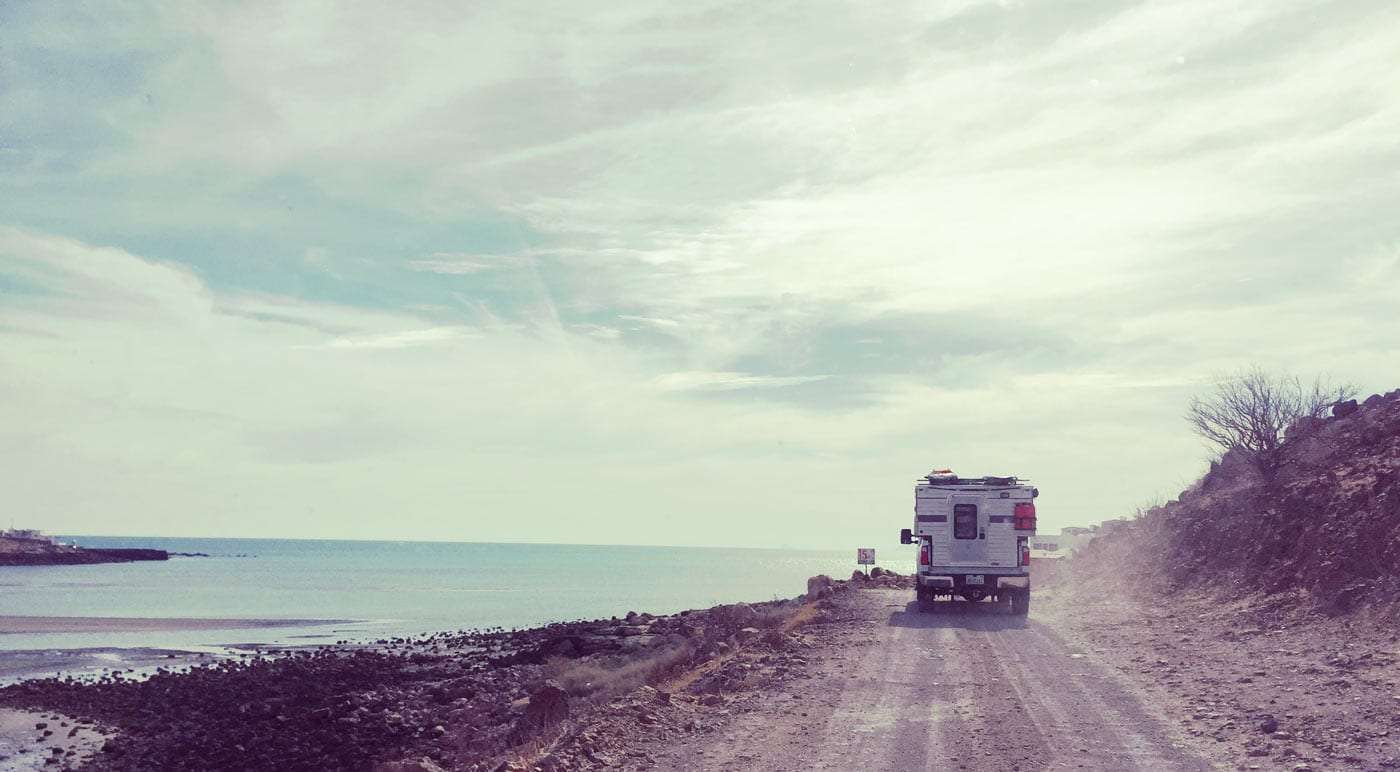
Photo by Nathan
By Nathan Swartz
The following is an account by one man, who traveled for a few months to Baja California, with his family, in their 1978 Volkswagen Bus.
This man is no expert on Mexico. He has been traveling the continent of North America full-time since 2008, but aside from a cruise to Cozumel and Belize, never been in anything remotely Central America. Safety is not an issue of a single person’s experience, but of a collective compiling of data.
Statistics can be scary, though, and not always tell the entire story, but what they do is provide a simple way to compare things. Unfortunately, data is not always up to the minute, so we need to go back to 2011 to look at the latest information.
In Mexico, in 2011, a total of 131 2 US Citizens were murdered in all of Mexico . That same year, 12,664 3 homicides happened in the United States. Mexico has about a third less people than the US, yet the latter had over 90 times more homicides.
Are many, many more people than those 131 US citizens killed in Mexico every year? Yes. Are you traveling to Mexico to join a drug cartel or partake in criminal behavior in the streets of Mexico City, though?
Focusing just on Baja California, from August 2014 to October 2015, 160 people were killed in drug-related homocides in La Paz alone. La Paz being the capital of Baja California Sur. Around 250,000 people live in La Paz. What then, is the statistic? 1
.0006% percent of the population.
In 2015, over 12,000 people were killed before Christmas by guns in the United States. 4 . The population of the US is around 319 million. That puts our percentage rate at 0.00005%. So yeah, the capital city of La Paz is technically 16 times more dangerous, in terms of actual homicides.
Until you look at the actual number of US citizens killed in total , in all of Mexico. We’re not talking suicide or drowning surfers or car accidents, but straight up homicides. Then those percentages change drastically.
Around 8 million tourists visited Mexico from the US alone. 131 of them were killed.
That said, we’ll move beyond how safe it is, leaving that to you to decide for yourself, and speak more to the actual experiences this man, his family, and their old VW Bus had.
Toilets and Bathrooms
Por favor, tirar papeles en la basura.
This sign, and one like it, were the family’s first experiences with a bathroom in Baja. Translated, it basically means “Throw you toilet paper in the garbage, please.”
The sewage system in Baja is apparently not equipped to handle toilet paper. So, there are garbage bags full of used toilet paper in every baño. It’s not really that big of a deal once you get used to it.
You’ll come to discover that when a bathroom is available, it’s less about how glamorous it is and more about the sweet good god almighty relief that you actually get to use one.
While clean, well kept bathrooms are common the further south you get, and in the larger cities or nicer hotels and restaurants, if you’re just camping at RV parks or palapas, expect something significantly more primitive.
Think a toilet seat with a poor excuse for a hole dug in the ground. And thank the guy who comes along once a week or so to shovel it all out.
If you are brave enough to do a little boondocking, though, bring a small shovel and be ready to find yourself a nice chunk of sage to poop behind.
As the family was traveling with friends, they were able to witness how valuable bringing your own toilet might be. Whether it’s something you purchase or if you just rig up a five gallon bucket and a garbage bag, not finding yourself in the situation of needing to run to a bush may prove quite the relief.
The family, however, went packed with little more than a small beach bucket to pee in come early morning and a strong sense of leaving their lunch to mother nature to deal with.
Hotels and RV parks alike will typically have showers. Will they be hot? The family reports that the hot/warm to cold ratio is around 20%. In favor of the cold showers.
So get used to swimming daily, especially if you plan to camp on beaches in favor of staying at RV parks or hotels.
Again, the results will skew as you find yourself in places more likely to be inhabited by gringos, the colloquial term for Americans and Canadians down here in the finer slice of North America.
Oh, and bring flip flops. And expect to get some type of fungus. Sorry, it’s just the experience reported.
Is it Cheap?
As of March 2016, the exchange rate is around 18 pesos to the US dollar. It’s starting to head back down again, but this is also an all time high.
In places like San Felipe, San Ignacio or the Vizcaino Peninsula, you can feed yourself and drink a few cervezas for under 150 pesos, easily. Our traveling family reports typical meals in San Felipe costing around 400 pesos, which included about nine tacos, an additional full “meal” (think a burrito with a side of rice and beans) for their teenager, and five or six beverages at that price.
The same meal in La Paz cost closer to 1000 pesos. That number can grow to 1900 in Todos Santos and Cabo San Lucas, where you’ll be paying U.S. vacation prices.
RV parks, the official kind which have a shower, typically WiFi access, toilets and electricity, run around 200 – 350 pesos per night. More rugged accommodations may be from 100 pesos per night…to absolutely free. Much of the pricing in these places depends on whether anyone ever shows up to collect money.
While digging their toes into the sand and chatting with some ex-pats one night, the family was told that all beaches in Mexico are federal land…so no one can legally charge you to use the beach. However, if someone built palapas (little huts similar to a rickety old pavilion) to provide you shade, or offers a toilet that you’re using, it is apparently either within their right to charge you, or at least it’s easier to pay the equivalent of a few USD in order to avoid a confrontation.
Gas stations are all owned by the government, and as of March 2016, gas was about $3.50 USD / gallon (though it’s all measured in liters down here), compared to $2.40 / gallon in California right now, or $1.68 in Texas. These results may vary drastically as time does it’s progressive thing.
Most importantly, perhaps, is the issue of tipping.
You may have been told that you shouldn’t tip in foreign countries. Such is not so in Old Mexico. The patriarch of the family, responsible for exchanging his time for money and that money for food at restaurants, has indeed been informed by gringos, ex-pats and locals alike that tipping is not necessarily expected, but appreciated and very much a part of Mexican culture.
From coffee shops to bars, car washes to FedEx guys, “propina” jars are not exactly rare.
10-15% is considered customary, and the father of that family reports he would follow this, unless given even slightly better than terrible service, in which case he’d tip the usual 20% he might do in the United States.
Considering a meal might only cost 500 pesos for a family of five, or $28 US, is tipping another $6 really going to break your budget? Because it could significantly improve the life of that waiter serving you.
As in the US and Canada, if you can’t afford to tip, cook for yourself.
Finding Campgrounds
Resources for finding campgrounds in Mexico are not as up-to-date or easy as in the US and Canada, but they do exist.
Between using apps like iOverlander to guide books and websites, you’ll be able to find somewhere to park your shiny, new-fangled Airstream…or in the case of our little traveling family, your rusty old Volkswagen.
While these are all incredibly valuable and will likely prove necessary if not simply useful at some point, one of the best ways to find a place to call home for the night, as reported by our dear traveling reporters, is to have conversations.
With locals, or other travelers. Guide books will take you to where everyone else with a guide book has been. Conversations will help you find somewhere new.
Internet and Cell Service
Such is the advice of that Volkswagen-filling’s worth family of hippies who have been so kind to provide such insights as to how to get internet and cell service down in the grand three-sided island known as Baja California.
Service is spotty, primarily confined to towns, though most towns, even small ones, will have it.
T-mobile currently allows those lucky adventurers brave enough to suffer their terrible service in the United States to roam completely free in Mexico, so if Telcel or Nextel or Movistar, some of the more popular cell providers in MX, have service, you’ll get it on your T-mobile phone.
You can also tether that data, up to 14GB / month as of today, to your other devices.
Or you might just opt to buy your data directly from a Mexican carrier, such as Telcel (who seem to have the superior network when compared to Movistar and about the same speed but more coverage than Nextel), for $60 per 10GB. These plans appear to require that you use them within 30 days of purchase, but we’ve heard reports of slightly cheaper options from our traveling family…though they claim to have only heard secondhand accounts and haven’t had to go this route just yet.
Otherwise, WiFi at campgrounds and restaurants and hotels will be as varied as it is in the United States. Note that many restaurants will provide WiFi for free though, particularly in tourist towns, as a way to draw in hungry data gobblers.
Like most things in Mexico, shopping at grocery stores is significantly cheaper than in the US. Otherwise, the experience is quite similar, but en español.
There are good grocers, think in the bigger towns, but not exclusively, and shittier ones. Some places will have rotting food for sale as though it was no big deal. And some of those places will allow you to exchange it hours later.
The largest differences that our family of VW Bus travelers have discovered in grocery stores is that meat is sold in a way many Americans might find discouraging. Much like you might produce a donut from the bakery case or clean up dog poop on the beach, you slip your hand into a bag, wrap that bag around whatever meat you want, and reverse it all so the meat is then in the bag itself.
The Walmart in La Paz has a real, and good, bakery. Their is an abundance of serano peppers, jalapenos, bananas and avocados. Oranges are, suprisingly, hard to come by. Boxed food is as common as in the US.
Other items that you may have become accustomed to you in your fancy shmancy life in Freedomtown, USA may not be available, or may have substitutes. If you can’t find what you want in a grocery store, say Athlete’s foot spray or hand sanitizer, just check a nearby farmacia, which are more common in Mexico than Starbucks are in a US strip mall.
On the other hand, towns that cater to ex-pats–think Cabo San Lucas and Los Barriles–have organic grocery stores (all of which are small, but so are most grocerias in Mexico). Expect to pay a bit more than you would at your local Whole Foods back home, though.
How do you do laundry in Baja?
You simply drop it off. Lavanderias are places you bring your dirty clothes, a typically nice and older woman grabs it all from you, tells you when to come back, and when you do, for maybe 170 pesos or less (depending on how much dirty laundry you need to air), she has a few bags of clean, folded clothes ready for you.
RV parks will sometimes, but rarely, also offer a laundry room, and more often than not when they are available, there isn’t a lovely old Mexican woman or a dryer to go along with it.
Luckily, it’s hot in Baja and sunny even in the middle of February.
Dining out at Restaurants
In swankier cities like La Paz and Cabo, your restaurant experience may be very much in line with what you expect in the United States.
Our little family of traveling overlanders, though not adverse to visiting these types of places, mentions though that if you really want the experience, avoiding the larger cities and their touristy traps is a requirement. So what are the little cafes and restaurants like in the smaller towns?
Quite different. If a restaurant doesn’t sell beer, for example, they may just run down the street and pick up a six pack if you order yourself a cerveza. Expect a family to not only own, but to be very much a part of running the place, from serving your food to cooking it and every experience in between. In most cases, they aim to please, and want you to be happy with the entire experience.
When it comes to selection, imagine the selection you find when visiting one Mexican restaurant in the US and then another. Does it typically vary that much ? No, not really. And neither do the items you’ll find on restaurants that are side by side or across town or in the various different towns. What varies most are the quality of the food, the prices, and the freebies they give out.
For example, the family reports back that a particular restaurant in San Felipe served “just okay” tacos, they were particularly reasonable when it came to price, the waiters constantly checked up on them, and they were not only given chips and salsa as a free appetizer, but also heaping plates full of steamed clams and garlic sauce.
Just around the corner, a restaurant with a nearly identical menu was charging slightly more, but with no appetizers and had to send someone out to fetch beers when it became apparent that one six pack wasn’t going to do the job.
Your mastery of Spanish will come into play in many dining establishments as well, and don’t expect everyone to speak even a little English. It may even be safe to say that when the average American traveling in Baja is asked, “How is your Spanish?” and their reply is anything akin to “It’s decent,” what they actually mean is, “I can order fish tacos the way I like them with no problem.”
Learning how to order food in Baja is the first skill one will master. How to ask for help when broken down on some long forsaken dirt road with no cell service will be the second.
Aside from ordering food, how much it costs, and so on, one of the most interesting points of dining out in Baja is the time things take. While the number of minutes between when you order and your food arrives is primarily based on how much you order and how busy the place is, just like in the US, what does very is the amount of “service” you’ll receive. It seems that once your food is delivered, most places in smaller towns will have a waiter who asks if you’re okay and, if you say yes or in some way indicate that you are, they’ll largely leave you alone. If you want another beer or soda or something, there is absolutely no problem with walking over to them and asking for one…something that is often considered rude north of the Mexican border.
Likewise, it is extremely rare that your server will bring you the check if you don’t explicitly ask for it. The family reports back that only once in the months the traveled around Baja did a waitress ask if they would cash out because her shift was up, and that was at a very “gringo” establishment. In fact, even if a restaurant was due to close at 8pm, if you never ask them for the check, they could easily stay open an hour or more afterwards. You’d kind of be a dick, yeah, but that just seems to be the way it is.
So if you’re ready to go and wondering why they won’t drop off the bill, “Puedo tener la cuenta?” will get you a long way.
Finally, when it comes to paying that bill… some places do accept credit cards. Bigger towns, fancier establishments, or just forward thinking restaurants. In most cases though, be ready with cash as that’s not only all they’ll accept, but they’ll expect you to have nearly exact change. In Baja, the custom seems to be that if you can’t make change to pay your bill, they just accept the larger amount. This isn’t a hard rule, and if it’s just a matter of a few pesos…say your bill is $320 (again, pesos, they use the same symbol to denote their money as we do), and you’ve only got $300, they may let you slide. Then again, if you’ve only got two $200 peso notes, and they don’t have change, you’ll lose out.
Not that big of a deal though, because tipping is indeed the right thing to do in Mexico . Whether it’s always been a custom or it’s something new, it’s just right. Would you not tip a waitress in the US? Even if you get sub-standard service, you would, right?
You would right?
So why not tip these guys, too? A typical tip for one person’s meal in the bulk of Baja is going to be around ten to thirty pesos. As of the current exchange rate, that’s somewhere between forty cents US and two dollars. If your family of five’s meal comes out to $500 and you generously decide that 20% is an appropriate tip, at a 17-to-1 exchange rate you’re still only tipping $5.88. That’s nothing to most Americans, but might mean a world of a difference to that little family running the restaurant on the side of Mexico 1.
What was that Golden Rule people are always talking about again?
There are two types of mechanics in Mexico, those who own a shop and get paid to do it, and every single other Mexican man.
“Seriously, I have come to believe that all Mexicans have at least a rudimentary knowledge of how combustible engines work,” reports the father of our traveling correspondents in Baja. “I hope that doesn’t sound like I’m stereotyping, because it’s a praise.”
Where cars have become generally more reliant on computers as the ages have gone by, and the value of the US dollar to the peso has widened its gap, so have Mexican men remained gearheads just as American men were in the 50s and 60s. Sure, there are plenty of new cars in Baja, and they’re not all owned by gringos, but there are also a lot of twenty or thirty year old vehicles on the road, and people who know how to fix them.
If you break down, it doesn’t hurt to ask for help. In the US that might mean hitching a ride to the nearest mechanic, or somewhere you can call for a tow truck. In Mexico, it can be as easy as knowing a rudimentary amount of Spanish and popping the hood when a truck full of guys drive by.
On the other hand, if you do start dealing with actual mechanics, understand that once again, there are two types.
Old guys know everything. Young guys only know new stuff. Don’t expect the average mechanic to speak any English at all. And like any businessman anywhere, if you come in fumbling over your words and can’t communicate what you want, you may get taken for a ride that leaves you a few pesos shorter than you pulled in with, and not much further along as far as repairs go.
“I’ve found that Mexican mechanics are the least friendly of folks down here,” that same father reports, “if you know how to communicate at least a little, it’ll get you all the further.” He adds that, after their 1978 Volkswagen Bus broke down, it took ten trips to various mechanics in Guerrero Negro before he found someone who could both speak English well enough for them to discuss the problem and get it resolved, but also to find someone who knew how to work on older vehicles and also had the time and desire to do so.
If you have that trifecta in place though, the ability to speak the language somewhat, a little knowledge of your own on what is actually wrong, and finding the right guy, you’ll be surprisingly pleased with the results.
“After I finally found the right person, and this was four days and again, ten different trips to various mechanics, the total bill for a guy to hand tool a part that fixed my entire situation only cost me $25 US for about two hours worth of work.”
That same job in the US would have easily taken a week by the time they fit him in and cost at least ten times the price.
Do I Need to Know Spanish?
The short answer is, “No.” If you just want to float through the tourist areas, eat a few meals, and nothing ever goes wrong, then you absolutely do not need to speak Spanish at all, and certainly not fluently.
Then again, if you want to talk to local people, to learn about their lives, to make friends, then at least some basic Spanish will go a long, long way. In general, there is not the same “You’re in our country, speak our language,” mentality that prevails in much of rural America, though it does exist to an extent. If you’re trying, you’ll be rewarded for that by a little patience and a lot of silly hand gestures that will leave both parties chuckling a bit.
If you find yourself in a jam…say you need to find a hotel in the middle of the night, call someone for help, or just explain that you want your kid’s burger to be as plain as possible, then knowing some amount of the local language will go a long way.
And, really, though it may be a difficult endeavor, learning even a smidgeon of another language will help your brain open up to new ways of communicating, new thought processes, and a wider appreciation of the local culture in general. Isn’t that what traveling is all about, anyway?
Are the police crooked?
“We got pulled over within twenty minutes of entering Baja,” the family reports. They were driving through Mexicali and obeying all of the posted signs. They saw a police officer on a motorcycle. He’d already pulled someone over and was talking with them alongside the road, and they continued on without much of a thought otherwise.
“Then I saw him, out of nowhere,” the dad reports, “he drove right up beside my window and pointed for me to pull over.” There were no sirens, no flashing lights. They pulled over. At this point, they knew no Spanish at all. After about ten minutes of the officer asking them questions, some of which they could understand via gestures, he waved them on their way.
They were doing nothing wrong, and didn’t know enough Spanish to understand if he was asking for a bribe or not.
About a month and a half later, with a little Spanish under his belt, the dad found himself pulled over again. This time it was in La Paz. He had run a red light, on accident. In Mexico, the yellow light is basically the red light. If you enter an intersection when the light is yellow, you’ve already broken the law. It doesn’t matter if it was still yellow when you exit the intersection. In this case, he almost crashed into opposing traffic. So he slammed on the breaks and waited in the middle of the intersection for it to be clear, then continued on.
“The guys coming from the other street didn’t seem to care if we hit them or not. They were just flying along. Most of them weren’t obeying several laws, too, but I was clearly from the US…I don’t know. I think that mattered.”
Indeed, stop signs seem largely optional for the locals, but again, this time the family was in the wrong. A police officer pulled them over and approached the vehicle. The father felt a little better about his Spanish after some time here and was practicing on the officer. A big mistake.
“You can pay tomorrow at 11am,” he understood at least that portion of what the cop was saying, “and I’ll take your license to the station. You pick it up there when you pay.”
Of course, the copy was speaking in Spanish, but that was the gist of his explanation.
“Where is the police station?” or in poor Espanol, “Donde es la estacion?” Now it was the officer’s turn to play stupid.
“Or,” the policeman said, now in English, “you pay now.”
Six hundred pesos saved the family from a trip to the station the next day. The fine would have been roughly that as well.
You really shouldn’t pay cops off. Don’t ever try and ask them if they’ll accept a bribe. You can hint at it, perhaps, but bribing a cop is as illegal in Mexico as it is in the US. They are just much more likely to offer it. But you’re just helping a guy who is probably a decent man go further down a crooked path. And you’re making it harder for the next American in this situation.
It’s just so much easier to pay them off right there than to haul your guilty ass back down to the station.
“We’ve heard reports that you can call their bluff,” the family tells us, “that once you state that you are willing to go to the station, they’ll just send you along on your way.” Still, they don’t do it immediately, and it can be intimidating.
“Funny thing is,” the dad laughs at the situation, even if he’s a bit embarrassed by it, “I told him that all of my cash was in the back of the Bus.
“So I had to get out, walk to the back, and on this busy street I’m counting out my money to give to the cop.” Smiling, he continues, “the guy was like, ‘No, no!'” He made it clear that he was now the one breaking the law, and me, the stupid tourist, was probably not worth it. If I would have pushed the issue for another ten minutes I probably wouldn’t have had to pay at all.”
Cops in Mexico, while likely just as powerful if not more than those in the US, seem genuinely less dickish than their American counterparts. The best advice? Play dumb, act like you don’t know what’s going on, and be polite. You’ll quite likely just get out of it all.
And then, try a little harder not to break even the smallest of laws.
Road Conditions
Remember that time you were driving through Alabama or Pennsylvania or Michigan or Colorado and were just bitching left and right about how the local DOT seems to always be working on the road, but the road is never fixed?
You’ll be praising those guys after a few weeks in Baja.
Many roads aren’t paved at all, even back streets in decent-sized cities. If you really want to explore, you’ll no doubt find yourself on some rather long, washboard roads to middle of nowhere (literally) beaches. Some of these roads will suddenly disappear as potholes the size of your vehicle have bore their way into the face of Baja like a blackhead on a teenager’s left nostril.
Even on Mexico’s highways, there are no shoulders, the roads can be tight, and the curves sudden. “Topas”, aka speed bumps, can show up out of nowhere. There is a particularly amusing / threatening one in La Paz, just before you enter town. The speed limit is 40km/hour and then you see a sign where the limit increases to 60km/hour. Just as you notice that sign and begin to accelerate, a two foot speed bump appears and you can either slam on the breaks, no doubt forcing the fellow behind you into your rear bumper, or take a a year or two off the life of your vehicle’s front suspension.
While there is much beauty to be seen while driving through Baja, if you’re the actual driver, it’s best to keep your eyes on the road at all times.
Don’t drive at night. Some people will tell you it’s because you can get hijacked. More reasonably though, it’s to keep you from crashing into a 2,000lb. bull who finds the pavement a little warmer than the desert sand at night.
Familiarize yourself with the speed limits, and pay attention, they change quickly and without reason. You can be driving down some abandoned road to nowhere and the speed limit will only be 60km/hour, suddenly dropping to 20km/hour for seemingly no reason (ie, there is nothing around and no sudden turns), only to jump to 110km/hour just before a populated town springs up.
While no one in their right mind would encourage you to speed, the limits in Baja are set quite low, and the further from population areas you get, the less likely some copy will just be hiding alongside the highway as they do in the US.
Even the newest looking roads can have major, major potholes.
Expect that beautiful scenery, too–and this is one of the more unfortunate aspects of Mexico–to be littered with basura, aka trash. Nearly always.
As for gasoline, it’s prevalent. There is a stretch near where Mexico 5 and Mexico 1 intersect, down to Guerrero Negro, where there are very few places to fill up, and if you’re exploring the dirt roads of Vizcaino, you can go 60 miles or more without seeing a gas station, but in general and particularly with newer vehicles that can easily go a hundred miles or more without needing a refill, you won’t have trouble finding gas in Mexico. And all of the gas stations, Pemex, are government run, so there’s no need to hunt around for the cheapest prices. They’re always the same: whatever the government says they are.
Getting mail from the US sucks in Mexico.
“We ordered a part, three day international shipping,” our traveling family tells us, “and a month later we were able to pick it up in La Paz. It costs almost $150 when everything was said and done, including a ‘holding fee’. That’s right, FedEx couldn’t get it to us in 3 days and so we had to pay for the additional three and a half weeks it took them to finally deliver it.”
“Another time, we tried shipping some documents to the US,” says the father of our Baja correspondents, “that was again three day shipping.” It took a week before their tracking number even reported the item as being shipped, and then another three days for it to arrive in Texas.
Don’t expect Amazon to ship most items, and don’t expect to find many common items you might need in Baja. Come with everything you think you need, short of food, and if you absolutely need something shipped down, rent a casita for a month and wait it out.
Also note that aside from big cities like La Paz, you can’t typically send packages via UPS or FedEx. While there are little couriers offering these services, if you have a package, these guys need to get it somewhere that customs can root through it…so shipping documents is the most likely scenario if any amount of success is desirable.
Exchanging Dollars, ATMs and Credit Cards
If you bring US dollars to Mexico, you can typically exchange them either at stores dedicated to doing just that (and they take a cut, of course, in the form of giving you an exchange rate a bit lower than what it would actually be) or at places like gas stations, where if you buy something with dollars they’ll be okay with giving you change back in pesos.
But not a ton of change, more like breaking a $20 down into $15 worth of pesos.
ATMs are largely provided in every decent-sized town. Bancomer is the most common, and they charge what is roughly the equivalent of $5 as their fee. Add in whatever your bank charges and you might find yourself paying around $10 / ATM transaction. 5000 – 10,000 pesos is typically the limit on how much you can withdrawal, from Bancomer’s perspective anyway (your bank will have its own limits).
Banamex is consistently the cheapest, charging closer to $2.50 and the host of other random little banks charge a varying amount in-between those two ranges. Still, outside of the bigger cities you won’t find anything but Bancomer.
On top of this, ATMs typically disperse 500 peso notes (if you withdraw some amount of thousands), which are hard to spend if you’re just trying to buy something like a candy bar or a pack of cigarettes. If you’re not spending at least 300 pesos and you hand over a 500, you may find yourself in a situation where the cashier doesn’t have enough change. Or is annoyed that you don’t have anything smaller.
Credit cards can be used in larger towns, particularly where there are more tourists or ex-pats, but always have some cash on hand, because even though many grocery stores and hotels will have credit card machines, most small restaurants and campgrounds won’t.
What are the people like?
Honestly? Just like Americans. Some are quite friendly. Others are short. A few are just downright jerks. People are people around the world, we have good days and bad. Mexicans are not particularly any more happy or pleasant than Americans.
The primary difference, however, is that in general…and this goes for the smiling young mother walking her kid through the playground and the rough-around-the-edges farm worker in the back of a pickup truck alike…if you say “hola” or “buenes tardes” to just about anyone, they will surprise you with a fervid response of the same nature.
So in that way, they are different. There is a politeness that seems ingrained in the culture that was lost in the United States at some point.
What’s the Weather Like?
Sunny. All the time.
Sometimes windy. Chilly at night in the winter, but hot during the day.
And very, very sunny.
The Landscape
“The cardon stretch on for endless kilometers, dotting the rolling desert and peppering mountains like I hadn’t imagined,” he tells us. A bit of a dendrologist, our roving father reporter, he takes note, as naturally does his family. They speak of an arid land, rarely flat and sometimes downright monstrous as hills and mountains go.
The road, whether pavement, dirt or sand, wriggles between some of the most curvaceous, alluring landscape in North America. While the cardon cacti are the dominant force of fauna in this region, in the washes and arroyos thick native bushes (and plenty of tamarisk) rise ten or fifteen feet into the air, if not higher, while an interesting array of trees twist and turn like a Doctor Seuss version of reality appear here and there wherever you go.
Still, plant life is relatively scarce. The big blue sky and the rustling of the ocean as it goes murky shallow to aquamarine pristine depending on what lies beneath are the primary attractions most folks seem to come to Baja to experience. Massive dunes prevail, separating where they can the land from the sea, and even where the beaches have been tamed by man the tide tends to rise and fall significantly against a rather sharp slope, particularly in the southern half of Baja. Further north, one can walk for what seems like an eternity before finding themselves even ankle deep in salt water.
It is the desert, and as such is gorgeous to those who know how to see it properly.
Drinking Water
Montezuma’s Revenge is not a myth. You will get sick from drinking non-purified water in Mexico, and as far as anyone who isn’t snooping into the darker realms of a local’s home can tell, Mexicans only drink purified water, too.
Whether some don’t or they all do is not the point, sure, perhaps some locals have an immune system capable of handling everything that the natural water and Mexican-borne systems of delivering it can dole out, but for nearly all foreigners, consuming non-purified water will result in a day or several of everything you’ve eaten–and then the vapid hole that’s left–coming out of both ends.
Luckily, the ice and water they serve in every restaurant our traveling companions have visited has been purified water. Yes, the ice too. No need to fear the margaritas.
Bottled water is for sale in abundance, from single doses at the local gas station to 5 gallon jugs at the grocery store, and most towns have at least one place where you can go to fill up your own freshwater tanks and bottles. Best of all, it only costs about 15 pesos for 5 gallons, sometimes significantly less for more and a little more for less. As of today’s exchange rate, that’s less than a dollar for what, in scientific terms, we deem a buttload of water.
Alcohol, Tobacco and Pot
Mexicans enjoy a buzz as much as their northern counterparts, even if the options are slightly different and the rules on imbibing follow suit.
When it comes to alcohol, you will find no shortage. Don’t expect variety, mind you, but you can buy liquor, wine and beer alike in convenience stores, grocery stores and many restaurants. If you’re an IPA snob or only drink a certain type of wine, you may need to reconsider opening your tastes a little to try something new…or settle if you must. Most restaurants will offer beer at least as a beverage, and even those that don’t will sometimes have someone run out and grab you one or two if you end up ordering a cerveza or two with your meal. Don’t expect it, but it’s more common than you think. You can also often leave a restaurant with your beer. Drunk driving is illegal, but not as serious an offense as in the US, and at one point the offer to take three margaritas on the road when leaving an establishment was had.
That is not advice, just a conveyance of our dear traveling family’s experience.
As for cigarettes, if you’re the smoking type, they cost significantly less, around 50 pesos, which is currently just over $3 USD per pack. American Spirits? No. Everything else, just about? Yes. Those smokes you can pinch the filter to turn from regular to menthol seem to be very popular with the younger Mexicans who do smoke. It is not frowned upon like it is in the US, particularly in smaller towns, but fewer people seem to smoke cigarettes via an unscientific collection of data gathered by the roving family kind enough to share their experiences with us.
What about weed though? You know, cold, hard, dope. Well, maybe not cold or hard, but the green variety.
Marijuana is not abundant in Baja, and apparently it is not entirely illegal either. If you wanted to find some, it wouldn’t be hard, particularly in the more touristy areas…in Los Cabos, for example, you might be offered marijuana for purchase multiple times in a day, in Los Barriles or La Paz on the other hand, you may need to make some friends or just ask around.
The laws of being caught smoking or purchasing pot are unknown to this author and beyond the scope of this article, but it a sufficient summary of the status of green in Baja is that if you want it, you can find it, and no one seems to give a damn if you’re smoking it. Be smart, be safe, and oh, don’t expect the same quality as in Colorado. If they’re seeds, toss ’em!
After having spent three months traveling around Baja, from Mexicali to San Felipe, the Vizcaino Peninsula to La Paz and a significant chunk of the East Cape, we asked the patriarch of our traveling family how he would sum up his experience in Baja.
“I started drinking cerveza most afternoons rather early, got sand in my shorts and my Bus, and watched the stars get bright just long enough to fall asleep early enough to make sure I’d wake up and see the stars. People were nice, I only rarely got sick of fish tacos, and as I’m waiting in line here for the ferry to the Mainland…well…I kinda love Baja.”
Tourists Killed
FIND A SHOW NEAR YOU
Tickets for Warren Miller’s 75 are now on sale.

Is it Still Safe for Me to Camp in Baja California?
After the brutal murder of three surfers in Baja California last week, travelers are wondering if the area is more dangerous than it used to be and if they should stop camping.

- Share on Facebook
- Share on Reddit
New perk: Easily find new routes and hidden gems, upcoming running events, and more near you. Your weekly Local Running Newsletter has everything you need to lace up! >","name":"in-content-cta","type":"link"}}'>Subscribe today → .
On May 3, authorities in the Mexican state of Baja California discovered the bodies of three surfers —two Australians and one American—who had been missing for a week. Authorities announced the arrest of three people in connection with the alleged murder.
The crime has generated headlines and intense media scrutiny around the world, turning a spotlight onto the Baja peninsula and the infrequent-but-shocking collisions between its beautiful, austere landscapes and the violence occurring by its border with the United States.
Is Baja more dangerous than it used to be? Is it still safe to camp there?
For me, those questions are personal. I’ve been visiting the peninsula regularly for over a decade to go fishing, off-roading, and camping across its remote beaches, deserts, and mountains. I married my wife there just before the pandemic was declared in 2020. We spent our honeymoon driving from Montana down to Todos Santos and back, camping along the way. Part of the region’s draw for us is its demand for personal reliance and the opportunity to test ourselves.
While my wife and I have never had even a whiff of trouble, we do know people who have experienced violence. Among them is Ron Gomez Hoff, who runs the popular TalkBaja website and its multiple associated social media groups. TalkBaja’s online community is an essential resource for people traveling and living in Baja, and Hoff has lived there for the last 24 years. He married into a Mexican family, and lives as part of the local community outside a small town on the peninsula’s Pacific coast.
In an editorial addressing the murders , Hoff shared his experience with violence, telling the story of a time when he and his wife were attacked by criminals near their home—and left for dead.
It’s not just Hoff’s personal experience that’s relevant here. TalkBaja’s main Facebook group is where news of the surfers’ disappearance first broke when the Australians’ mother posted photos of her sons and their friend, seeking help. Hoff sits at the epicenter of information sharing for the region. If there’s anyone who can authoritatively weigh in on the question at hand, it’s him.
“There’s nowhere you can go in the world today that’s totally safe,” Hoff told me. “But down here there are two things working against each other. You’ve got smaller police forces with limited budgets, and then you add to that the fact that the vast majority of this large peninsula is off-grid, it’s remote, there are few paved roads, and there’s no cell phone signal in most places. You can drive hundreds of miles without even seeing a gas station.”
Measured in a straight line, from the U.S. border in the north to Los Cabos in the south, the Baja Peninsula is about 760 miles long. The drive along Highway 1 from Tijuana to San Jose del Cabo is over 1,000 miles. Throughout most of that distance, that highway is barely two lanes wide, irregularly paved, and is so rough and remote that it presents more danger than most Americans have likely ever before experienced.
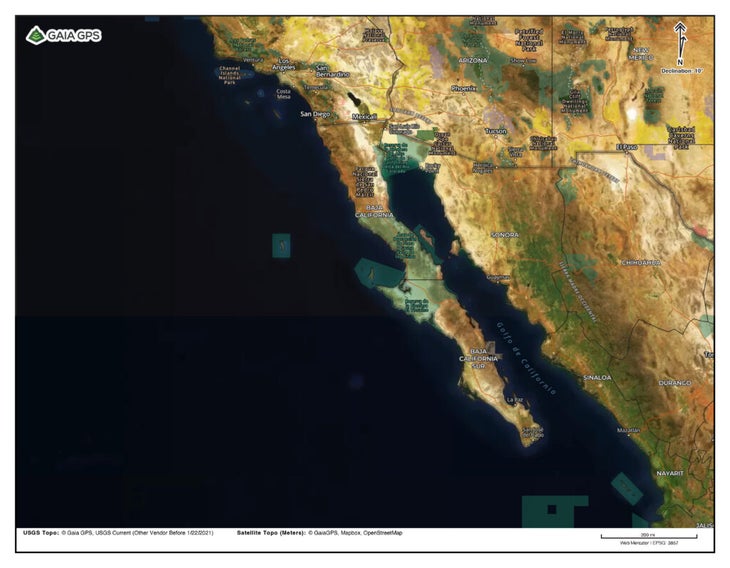
There are also two states on the peninsula—Baja California and Baja California Sur. The former, which is closer to the U.S. border, contains cities like Tijuana, Ensenada, Mexicali, and Tecate, which have some of the highest rates of violent crime in all of Mexico . South of Ensenada, it’s nearly a 400-mile drive to the border with Baja Sur, then another 260 miles from there to Loreto, a seaside town of 20,000 residents on the peninsula’s east coast which has seen two murders in the last year , a much higher rate than is typical there.
Is the murder rate in Tijuana applicable to a remote beach in the same state, 300 miles south? Of course not. But Hoff said it’s equally inaccurate to look at the very low murder rate for American tourists visiting all places in Mexico, and conclude that Baja is entirely safe.
“Mexico had 33.5 million American visitors in 2022, and only 46 of those were murdered,” said Hoff. At first glance, that represents a lower murder rate than north of the border.
“But murder rates are calculated in homicides per-100,000 people per-year,” Hoff continued. “An average tourist is here for three days. So you’ve got to take the 46 murders, multiply it by 365, and divide it by three.”
Doing that math takes the homicide rate for Americans in Mexico from 0.14 to 17.5 per-100,000 people. In 2022, the overall murder rate in the U.S. was 6.8 homicides per 100,000 people .
“Baja has a reputation as a place that is very remote, and it is,” Hoff continued. “But no matter how remote you get, there’s always somebody around, and that somebody is not always a good guy.”
Hoff said that’s a change he’s witnessed during his time visiting and living in Baja, explaining that an amendment to the Mexican constitution in 1991 that permitted ejido land (a type of communal agriculture land that’s widespread on the peninsula) to be privatized has led to a booming number of small farms and similar being constructed, some in extremely rural areas.
That’s something my experience backs up. I’m a skilled off-road driver who builds my own 4x4s into custom vehicles capable of unsupported travel through extreme terrain, and yet everywhere I’ve been in Baja—even on the other side of really challenging trails—I’ve encountered people.
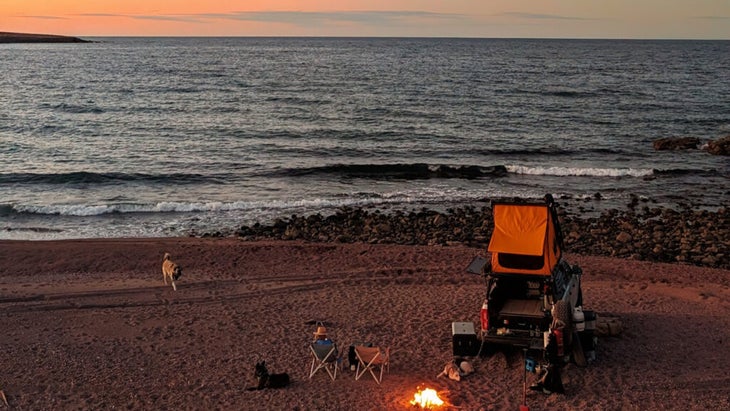
“You’re just not alone anymore,” Hoff continued. “When you see somebody out there these days they’re either working at a fish camp or ranch, they’re a foreign tourist because Mexican tourists won’t go out there anymore, or they’re a malandro (best translated as ‘bad guy’).”
Hoff went on to share information he’s gathered from local law enforcement and other sources over the decades. Lower levels of cartel operations—drug growing or production sites, or smuggling waypoints—are often staffed by the local equivalent of freelancers. Sometimes they might be busy working, and sometimes they might be between jobs. Because those operations take place in remote areas, that means you could come across malandros with free time on their hands pretty much anywhere. He also said that should you inadvertently find yourself camping in proximity to a cartel operation, they may send people to keep an eye on you, to make sure you don’t pose a threat.
Despite the large number of contacts, friends, and people I know in the Mexican tourism industry, no one wanted to discuss the murders or even safety protocols. People I’ve known for years ghosted me when I asked them. But Hoff’s assessment was backed up by conversations I had with Mexican friends born on the peninsula. I spoke to three of them—locals in the surfing community who told me they did not want to be named in this story.
Instead of sharing their thoughts on crime trends, they gave me practical advice for how to avoid problems in Baja. One, a surfer who recently had their first child, said that they no longer camp in unfamiliar areas, and where possible, try to stay on private land owned by friends or family. Others shared various strategies or approaches to determining areas in which they will or won’t camp that essentially amount to the same advice.
My local sources were reluctant to speak about criminal activities on the record, too. But these conversations are still fruitful. They focus less on an overall assessment of safety either historical or current, and instead immediately dive into the ins and outs of avoiding crime and violence while traveling the peninsula.
“Tell people to use paid-for campgrounds,” one of those friends told me. “That way they’re not only contributing to the local community, but you’re for-sure safe in those.”
I asked Hoff if simply finding a good campsite before nightfall, and making sure no one was around, would reduce that risk. That’s always been my strategy, and I wanted to run it past someone with much more experience.
Hoff told me he wouldn’t recommend winging it anymore, as that can get you into trouble.
The U.S. State Department last updated its longstanding travel advisories around the peninsula in August 2023. Those include a “Reconsider travel” warning for Baja, “due to crime and kidnapping,” and an, “Exercise increased caution due to crime,” for Baja Sur.
“Travelers should remain on main highways and avoid remote locations,” the State Department continues in the advisory. “Transnational criminal organizations compete in the border area to establish narco-trafficking and human smuggling routes. Violent crime and gang activity are common.” It goes on to order that U.S. government employees avoid driving after dark in areas of Mexico adjacent to the border.
“If you want to remote camp safely today, you need to do a lot of research,” Hoff continued. “And I don’t mean look at stuff people posted 10 or 20 years ago, you need to look for something that’s been posted in the last 30 to 60 days about that spot. And don’t just look for one source, find sources that have multiple people commenting on them, supporting or disagreeing.”
Multiple resources exist right now for people looking for good, remote campsites and other areas in Baja. I reference iOverlander , which is full of user generated content reviewing and locating campsites, taco stands, hostels, and similar. BajaNomad is a forum for the same that’s been operating for decades. Friends frequently share coordinates for spots they’ve stayed in or traveled through.
And there’s Hoff’s own TalkBaja , TalkBaja Road Conditions , TalkBaja Weather , and now, Safe Camping in Baja Mexico , a private Facebook group he started just this week, in response to the murders.
“It’s been a long-standing tradition for some of you to keep your favorite remote camping spots a secret but in light of recent events, the time has come for us to come together as a community and share what we know—good and bad—about the different off-road campsites down here in an effort to create a pool of shared knowledge,” Hoff wrote in a post introducing the Safe Camping group.
Despite the recent murders, Hoff believes that information sharing forums like his Safe Camping group will help future travelers and campers stay safe.
“Something changed with this event, and I think it has to do with the amount of coverage it has gotten,” he said. “It’s exponentially greater than other similar events we’ve seen in the past.” Not only did word of the missing surfers break on TalkBaja, but it was followed by multiple eyewitness accounts that tracked their movements in the run up to the murders, described the location and crime scene, and even connected the murderers to another missing persons case.
Despite the increased availability of information on crime and safety in Baja, Hoff believes the murder could become a pivotal moment for tourism on the peninsula.
“Because there’s been so many details provided outside of official sources, I think people are really seeing a detailed story of what these guys went through,” Hoff said, “And people are going, ‘that could be me.’ That’s really hitting home for a lot of travelers.”
For safer travel on the peninsula, you can always go to tourist centers with lower crime rates.
I reached out to the Baja D.A.’s office and the Baja California Tourism Board and its local representatives in Ensenada, Mexicali, and Rosarito for comment, but at press time have not received a response.
- Backcountry Camping
Popular on Outside Online

Enjoy coverage of racing, history, food, culture, travel, and tech with access to unlimited digital content from Outside Network's iconic brands.
© 2024 Outside Interactive, Inc

IMAGES
VIDEO
COMMENTS
The northern part of the peninsula, the state of Baja California, is one of Mexico's most dangerous states. It has the third highest crime rate and third highest homicide rate in Mexico, at 70.4 incidents per 100,000 people. Between June 2022 and May 2023, the state experienced a whopping 2,650 murders.
Sponsored. According to the U.S. State Department, Baja California is safe to travel to, with moderate crime. There are low levels of robberies, carjackings, and hate crimes and a high level of corruption and bribery. Among the safest cities, Ensenada, Rosarito, and Guadalupe Valley have the lowest crime rates year over year and are some of the ...
25 restaurants, hotels and hidden wonders along the Baja Highway. March 15, 2023. All authorities agree that driving at night in rural Baja is dangerous because of the many roaming livestock. In ...
Baja California Sur currently has a level 2 out of 4 rating, which simply encourages travelers to "exercise increased caution" due to crime. Baja California (the more northern state) currently has a level 3 rating, warning travelers to "reconsider travel due to crime and kidnapping". In a seemingly random incident in early May 2024 ...
Safe Places to Visit in Baja California. Despite the Baja Peninsula having high crime rates, some places are safe to visit, especially in the southern tip areas. These renowned spots include Ensenada and San Felipe, all recognized as safe places to explore. Whether you are planning for a honeymoon or a family getaway, they present themselves as ...
Click through to see the safest places to visit in Mexico, and as always, make sure to follow proper guidelines and check out the U.S. Department of State's travel advisory page. Loreto Loreto, located in Baja California Sur, is one of the oldest towns in the Mexican state and is known for being a beautiful escape from the hustle and bustle ...
This little device can make a world of difference in your Baja California safety. 2. Portable Jump Starter and Tire Inflator. For those driving in Baja Mexico, another excellent safety product is a portable jump starter and tire inflator for your car. It saves the day if you experience these common car troubles.
Geography is part of the reason: Loreto is in Baja California, which is separated from mainland Mexico by the Sea of Cortez. It doesn't hurt that Loreto is still a fishing village despite becoming a tourist destination in the last few decades. The population of Loreto is around 20,000.
Safe Travel. March 5, 2021. 6. ... Baja California | This milestone marks one of the many ways Baja California is diligently working to begin safely welcoming visitors back to the region. February 22, 2021. 8. A step by step guide when traveling to Tijuana.
Short answer: There are many beautiful and safe places to visit in Baja California, including: La Paz is a beautiful coastal city with a relaxed atmosphere. It's a great place to relax on the beach, go swimming, or explore the nearby islands. Todos Santos is a charming town with a bohemian vibe. It's a great place to visit for art galleries ...
Frequently Asked Questions (FAQ) - Is Baja California Safe To Visit 1. Is Baja California safe for tourists? Generally, Baja California is a safe destination for tourists. However, like any place, it's essential to exercise caution, stay informed about local safety conditions, and take common-sense precautions. 2.
The Baja California Peninsula has clear blue waters, fresh design, and seriously good guacamole. Montage Los Cabos. Photo courtesy of Montage Los Cabos. Punta Lobos beach. Photo courtesy of Hotel ...
Where Is the Safest Place to Stay in Baja California? While there are several safe places to stay in Baja California, here are the top suggestions. La Paz. La Paz is one of the safest cities to visit in Baja California, popular with families, couples, and solo travelers. Here you will find several white sand beaches, such as Balandra Beach.
The Mexican state of Baja California borders California. It is home to popular tourist destinations like Tijuana, Rosarito, and Ensenada. When it comes to tourism, Mexico is generally considered a safe destination for travelers, and any attacks directly involving tourists are extremely rare. Still, Mexico is a country that has its share of ...
Safety Facts About La Paz. According to Numbeo, La Paz has a crime rate of 34.85, which is low. To provide some perspective, Mexico City's crime rate is 78.44, Tijuana's crime rate is at 81.77, and then Acapulco's crime rate is 79.73. It's safe to walk alone in the city during the day and night, and the risk of getting mugged or robbed ...
Reissued after periodic review with updates for Chiapas, and Durango. Country Summary: Violent crime - such as homicide, kidnapping, carjacking, and robbery - is widespread and common in Mexico.The U.S. government has limited ability to provide emergency services to U.S. citizens in many areas of Mexico, as travel by U.S. government employees to certain areas is prohibited or restricted.
Wild Canyon Adventures. 3,209. Amusement & Theme Parks. An adventure park located in a scenic canyon, highlights here include the largest zipline course in Baja and a glass floor funicular. See ways to experience (13) 2024. 4. Medano Beach. 4,518.
Safest Places in Baja California. Baja California is a beautiful region in Mexico that draws tourists from all over the world. If you're considering a trip to this scenic area, here are some of the safest places to visit: Todos Santos: This picturesque town is located on the Baja California Sur and is known for its vibrant arts scene ...
Renting a car in Loreto, La Paz or Los Cabos and road-tripping around Baja California Sur is the best way to see the state. However, ... Loreto is one of the safest places to visit in Mexico. It is a very small, primarily tourism and fishing-based town of just 20,000 people. It is not known for any narco activity that occurs in other parts of ...
The safest cities in Baja California to live are La Misión, Rosarito and Ensenada, whereas in Baja California Sur, the safest are Loreto and Todos Santos. Those are the places where I felt safer. La Misión is not included in any statistic. It is a small town where one third of the population are Americans. One fourth are registered Americans ...
Cabo Pulmo. Natural Feature, Park. Pascal van de Vendel / Unsplash. View Tours. Drive north from Baja California Sur's most famous city and celebrity favorite, Cabo San Lucas and 60mi (97km) later you'll reach Cabo Pulmo national park: a paradise for naturalists and scuba fanatics.
Not all places in Baja are safe. Tijuana consistently gets ranked as one of the most violent cities in the word. Parts of Baja California along the U.S. border are also considered dangerous due to cartel violence, while Loreto, Mulege, San Ignacio and Bahia De Los Angeles are some of the safest places in Mexico.
The population of the US is around 319 million. That puts our percentage rate at 0.00005%. So yeah, the capital city of La Paz is technically 16 times more dangerous, in terms of actual homicides. Until you look at the actual number of US citizens killed in total, in all of Mexico.
But Hoff said it's equally inaccurate to look at the very low murder rate for American tourists visiting all places in Mexico, and conclude that Baja is entirely safe. "Mexico had 33.5 million ...
Sierra la Laguna holds a lot of treasures within its 277,835 acres. It contains over 150 species of birds, including some that are only found on the Baja peninsula. It is a vital part of the ...
Discover Museo del Vaquero de Las Californias in El Triunfo, Mexico: This bilingual museum explores the more than 300 years of vaquero history.
Discover Misión Santa Rosa de las Palmas in Todos Santos, Mexico: Once a Catholic mission, this small town tucked between the ocean and the mountains is now a magical spot for art and history lovers.